











Bath is also home to many little museums of special interest. Here’s a mini guide to them all
Any of Bath’s streets or buildings look familiar? Yep, you’ve seen them on TV and the silver screen
A collection of little conversations with the good folk that aim to please visitors to the city
38 We travel back in time to chat to Flavia, she’s a Roman citizen and a regular at the baths
–important
Take a break or maybe pack a picnic; Bath’s many parks and urban green spaces are the perfect place to relax, excerciseand enjoy the sun
a cultural tour of the city’s arts scene at The Holburne Museum
Then a visit to Victoria Art Gallery
about the rich and fascinating history of The American Museum & Gardens
46 Top jeweller Mallory celebrate their 125th anniversary. Katie Vander Woerd tells us all about this wonderful city business
Meet Bath retailers Daniela, Shelley and Kirstie from Grace & Mabel womenswear in Bath
known as the ‘Lantern of the West’ –a guided tour through the past, present and
of the thermal spring waters and a visit to Thermae Bath Spa
The Guitar Man. Be entertained by Steve Robinson, one of Bath’s best street entertainers 118 We chat to Richard Knighting and Marty Grant the owners of highly the acclaimed Bath restaurant, Corkage

Some wonderful features from the local archives
30 The men who built Bath: Ralph Allen, Beau Nash andJohn Wood –the elder and the younger
84
122
Dr Felicity James takes a look at Jane Austen’s time in Bath and what effect the city (and its social life) had on her work
Bath’s main theatre has had a colourful and dramatic history. Now in its third incarnation, the Theatre Royal Bath reminds us that the show simply, must go on
124 Ralph ‘Romeo’ Coates –the worst ever actor. It’s a great story, and quite hilarious!
Snippets of indulgent fun and activities to make your stay special
36 Read all about it. With help from Toppings Bookshop, some books on Bath
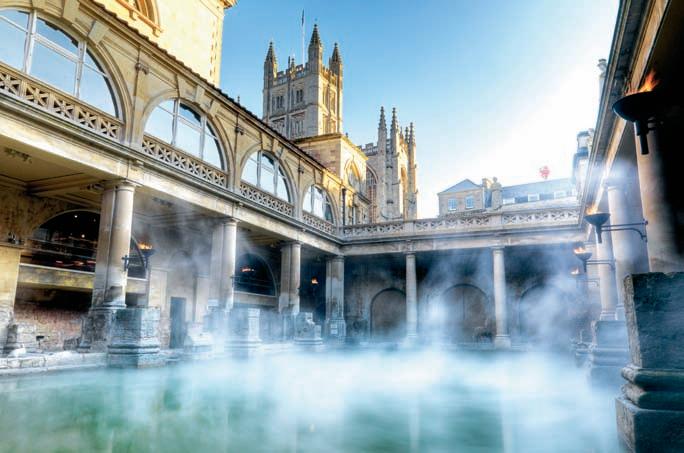
52 Fancy a little souvenir to take home as a memento of your visit? Here are some popular gift choices
80
There’s an excellent art and creative scene here with many independent galleries offering great artworks
98 Spa city: a round up of a few favourite places for a good pampering session
It’s vibrant, international and delicious. Bath has a phenomenal choice when it comes to eating out
40 Enjoy a great coffee at the city’s top spots.
88 Afternoon Tea. Our guide to the best places to take tea, in style, in Bath
102 Start your tour of all the city’s gastronomic delights and the dining options to be found
126 We love the nightlife: The very best places in Bath to venture out after dark and be thoroughly entertained
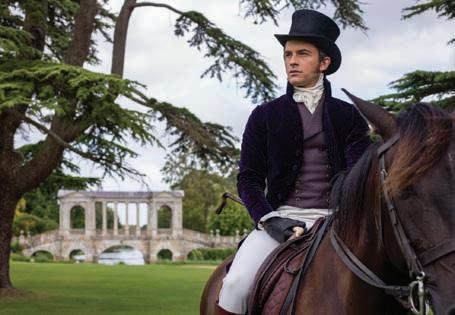
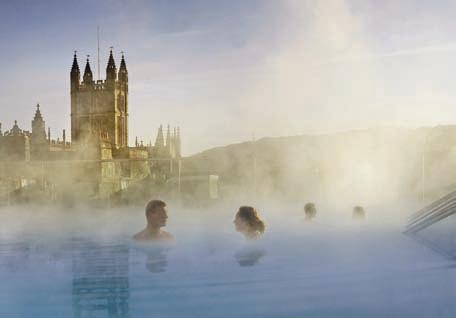



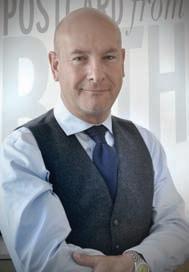
ne of the charms of Bath is its human scale, a city that is easily traversable by foot in under an hour and with so much to be discovered and enjoyed in such a small space.
It’s during the summer months things really start to hot up; not only is there the chance to get out and enjoy all the al fresco activities on offer, but early sunrises and golden evenings allow the opportunity to soak up more of th e Bath’s pleasures for even longer.
So while you’re here, venture out and take in as much of the city as possible. Whether it’s a visit to our world-class museums or galleries, a tour of our architectural sites, a simple summer’s stroll in one of the many parks or a relaxing dip in the geothermal waters – actually, that should be compulsory –and then enjoying Bath’s excellent shopping, dining and entertainment scene. There’s so much on offer, it’s no wonder that this small city provides all the magic needed to be one of the country’s finest visitor destinations.
Postcard, as the name suggests, is a collection of experiential notes and personal accounts delivered by those who really know this wonderful city of ours. Rather than the usual tourist-guide formula, our writers have been assigned to delight and inform you in a far more perceptive way and I believe they’ve done an exceptional job.
Finally in Postcard you can find much more practical detail to make your stay in Bath as well-informed as possible: great places where you can eat, drink, shop and be entertained.
From all of us who have contributed to this edition, we hope you’ll absolutely love this little city we call home. Enjoy your stay. Return sometime soon.
Steve M.For more than 22 years we have been publishing The Bath Magazine –the city’s biggest monthly magazine. During that time we have amassed an extensive library of information and knowledge with some of the best writers and writing on Bath, its history and the places and people that make the city a great destination. Postcard from Bath is a compendium of new features and reworked articles and just about everything else we know and love about Bath.
And, if you want to be informed about everything good going on in Bath: visit: thebathmagazine.co.uk
POSTCARD from
Publishing Editor
Steve Miklos
E: steve@postcardmagazine.co.uk
Editorial
Emma Clegg, Melissa Blease
Contributors, feature writers and photography:
Jenny McAuley, Dr Felicity James, Simon Horsford, Georgette McCready, Jessica Hope, Catherine Pitt, Claire Louise Cohen, Kate Hearst, Saber Khan, Dara Foley, Crystal Rose, Derryn Vranch, Paolo Ferla
Advertising Sales
Liz Grey E: liz@postcardmagazine.co.uk
Production Manager
Jeff Osborne
E: jeff@postcardmagazine.co.uk
Finance Director
Jane Miklos
E: jane@postcardmagazine.co.uk
Opinions expressed in articles are strictly those of the authors. All information contained in this publication is, as far as we are aware, factually correct at the time of going to press. MC Publishing Limited cannot accept responsibility for any errors or inaccuracies in such information. Whilst every reasonable care is taken with all material submitted to The Postcard from Bath, the publisher cannot accept responsibility for loss or damage to such material. MC Publishing Limited endeavours to respect the intellectual property of any owner of copyrighted material reproduced in this publication. If any copyright holder has been wrongly accredited, please contact us. M C PUBLISHING LIMITED
2 Princes Buildings, George Street, Bath BA1 2ED Telephone: 01225 424499
© MC Publishing Ltd 2024 All rights reserved. This


Please enjoy and recycle this publication but if you are not able to participate in a recycling scheme, then why not pass your copy to a friend or colleague.
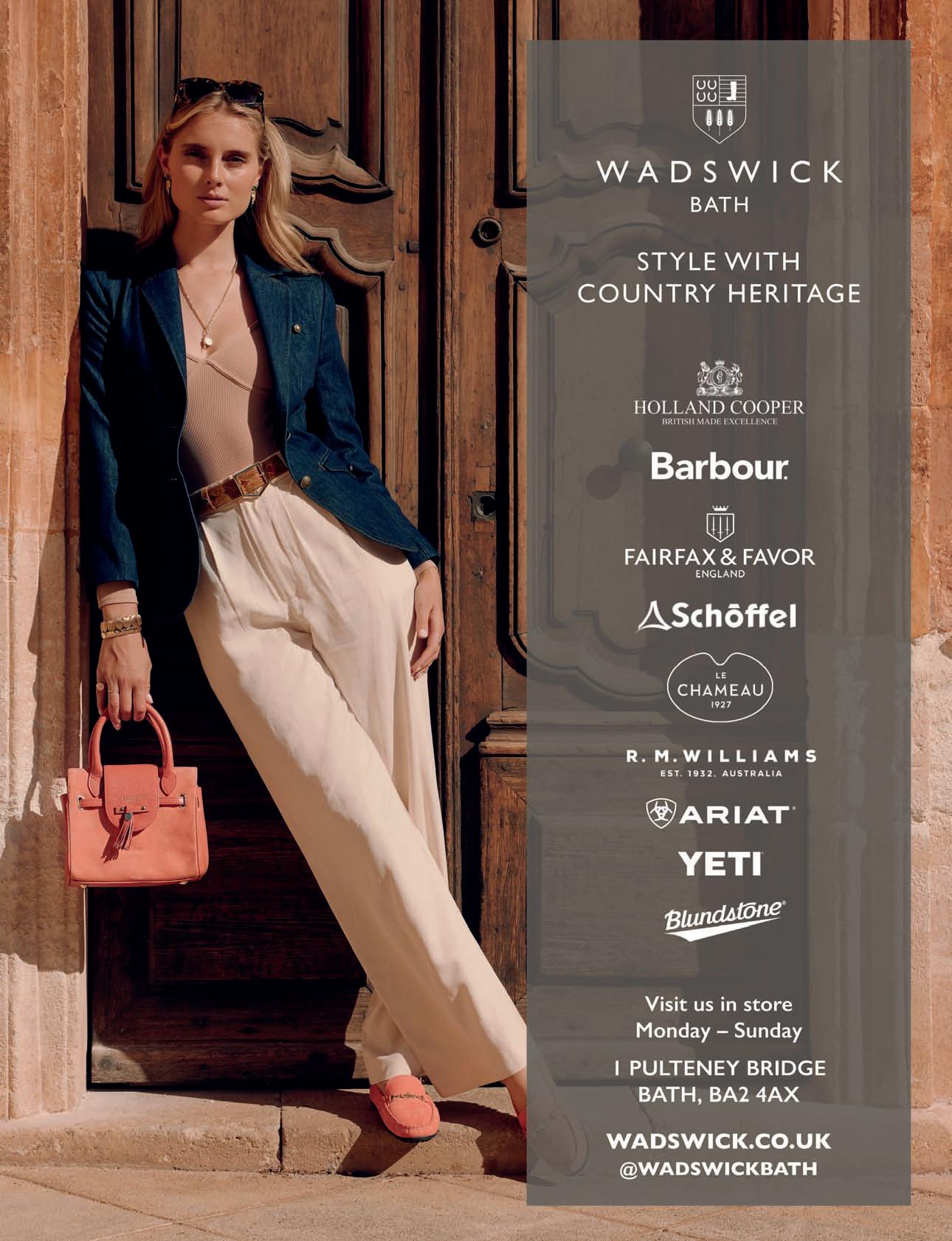
What’s on and things to do

If Opera has acclaimed productions to its name and a reputation for artistic excellence, with a focus on supporting emerging artists and enriching the local community. Their approach is to create a relaxed and welcoming setting in which to showcase spectacular opera. The festival entices some of the best musicians and singers to the South West, and this year is no exception.
Set in the beautiful gardens of Bradford on Avon's Belcombe Court, If Opera brings two of the greatest operas in the repertoire to the stage: Donizetti’s Lucia di Lammermoor and Strauss’s Die Fledermaus, together with the popular picnic prom featuring JTQ - The James Taylor Quartet and a children’s concert, Little Red Riding Hood Belcombe Court, Belcombe Road, Bradford on Avon, Wiltshire BA15 1LZ Web: ifopera.com

Green Park Brasserie in the old Green Park Station invites all its guests to enjoy great food, drink and live music. The venue supports local food producers and offers a menu using quality ingredients, from Braised Beef Bourguignon Pie to a Moving Mountains Vegan Burger. What’s more, every Wednesday, Thursday, Friday and Saturday evening the brasserie offers live music and candlelit dining. The music from the very best artists in Bath and Bristol includes modern funk trios, hot club jazz bands, acoustic soul and swing, Beatles' classics and sax-led trios. It takes place on Wednesday and Thursday from 6.30pm–8.45pm and on Friday and Saturday from 6.30pm–9.45pm. Green Park Brasserie, Green Park Station, Bath.
Web: greenparkbrasserie.com

Bath Racecourse hosts around 20 flat races between March and October, alongside many other live events. Part of Arena Racing Company (ARC), the racecourse received multi-million-pound redevelopment in 2016, which transformed the venue into the beautiful sight you see today. With modern facilities that give recognition to the history and heritage of the venue, the purposebuilt venue accommodates guests on race days as well as for private events such as weddings or conferences. Special fixture days include Ladies Day on 15 June, and Country and Western Racenight on 14 September.
Bath Racecourse, Lansdown, Bath BA1 9BU Web: bath-racecourse.co.uk
Kimberly has been established in Trim Street Bath for over forty years and stocks some of the world’s finest designers for women.
Current designers include : Amina Rubinacci - Max Mara StudioLe Tricot Perugia - Luisa CeranoKinross - Cinzia Rocca.
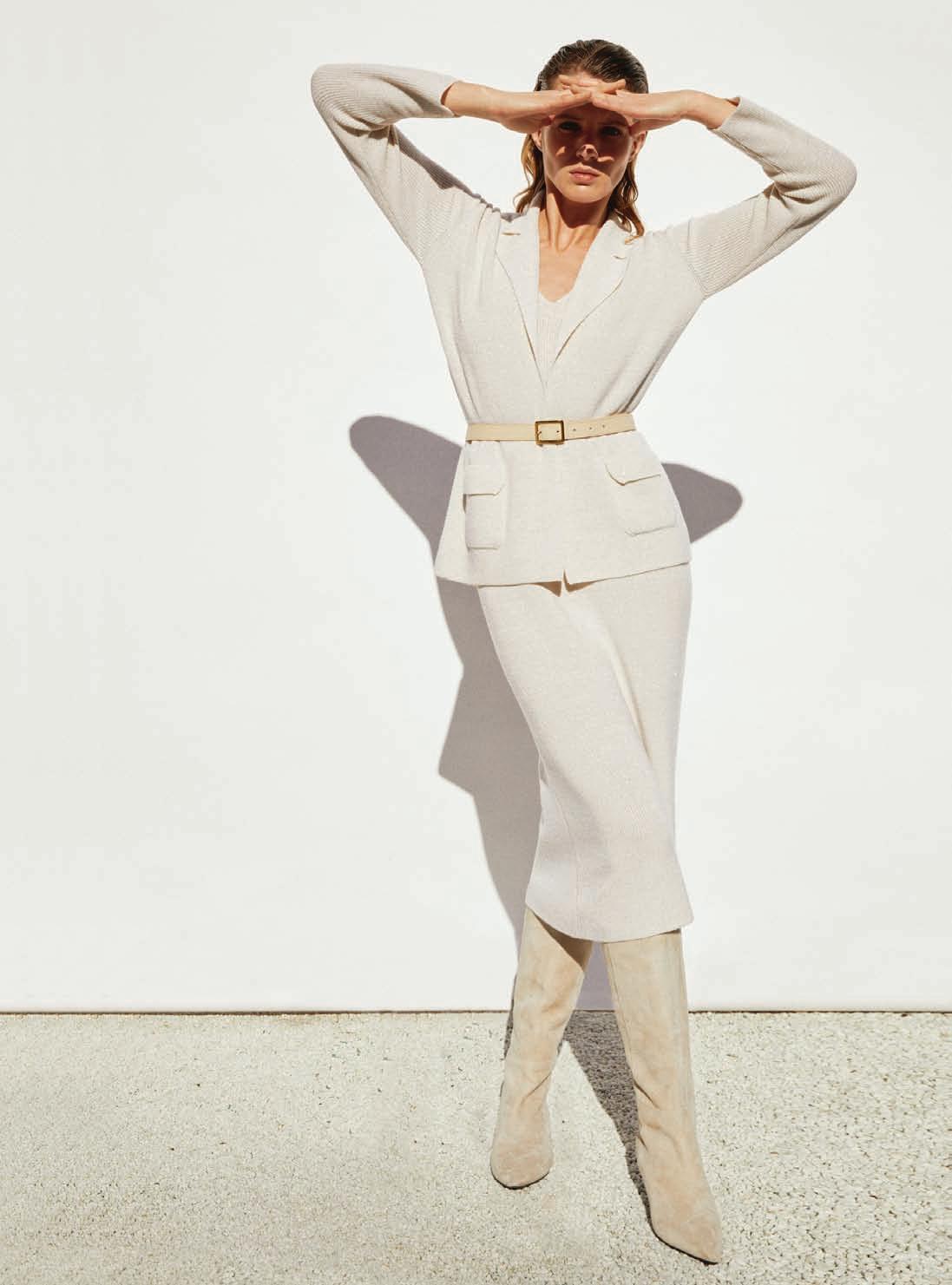
Kimberly Trim Street Bath BA1 1HB 01225 466817
kimberly.co.uk
kimberly@kimberly.co.uk Amina Rubinacci
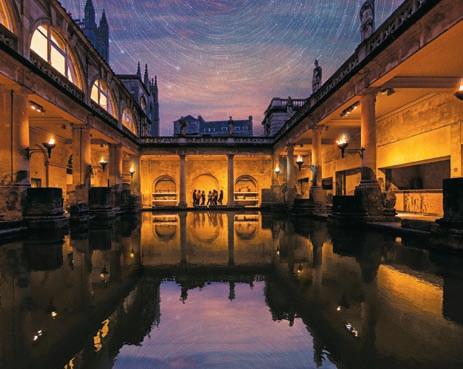
The Roman Baths will stay open until 10pm every evening this summer, offering visitors a chance to enjoy the special atmosphere around the torchlit Great Bath. There will be a pop-up bar beside the Great Bath selling Champagne, sparkling wine, mulsum (honeyed wine), soft drinks and locally-made Marshfield ice cream. The museum will stay open late so visitors can look around the fascinating displays about life in Roman Bath, long after the usual closing time. Last admission at 9pm.
Book online at www.romanbaths.co.uk
Forest Live is a major live music series managed by Forestry England. With everything required for a great night out, the concerts are renowned for their relaxed atmosphere and spectacular forest backdrops. Income generated from ticket sales helps look after the nation’s forests sustainably, for people to enjoy and wildlife to thrive. The programme includes appearances by acclaimed American jazz, blues and soul singer Gregory Porter, globally renowned pop star Anne Marie, multi-million-selling sibling quartet The Corrs, iconic vocalist and songwriter Van Morrison and musical pioneers Nile Rodgers & CHIC. Tickets are on sale via the Forestry England website.
Westonbirt Arboretum, Tetbury, Gloucestershire GL8 8QS
Web: forestlive.com

by Oliver Rosser
Photograph by Lee
Choreographer Kim Brandstrup presents the final installment of his Greek mythology triptych at The Ustinov. Echo and Narcissus will feature an ensemble of dancers including Laurel Dalley Smith from the Martha Graham Dance Company in New York.
Ustinov Studio, from 19 June – 6 July
Disco diva Deloris’ life takes a surprising turn when she is forced to hide in a convent where she helps her fellow sisters find their true voices as she also rediscovers her own. The cast includes stage and screen star Wendi Peters as the Mother Superior and Landi Oshinowo as Deloris Van Cartier.
From 6–17 August
The History Boys follows a bright bunch of boys in pursuit of sex, sport and a place at university, lifting the lid on staffroom rivalries and the anarchy of adolescence. This timely revival, directed by Seán Linnen asks what is the purpose of education. And who is it for? The 20th anniversary production of Alan Bennett’s brilliant modern classic.
From 22–31 August
Web: theatreroyal.org.uk

The latest way to get around Bath is to take one of the fleet of 500 TIER shared e-bikes and shared e-scooters.
The service comprises TIER’s state-of-the-art ‘E-bike 3’ and latest ‘TIER 6’ iteration of its shared e-scooter.
Users can rent both e-bikes and e-scooters through the TIER app available on iOS and android, and first-time riders benefit from one free unlock and 15 minutes of free riding time. Pay-as-yougo pricing is 99p to unlock the bike and then 16p per minute.
There is also a range of passes including a £4 daily Commute Pass offering 30 minutes riding time, as well as a range of daily and monthly passes. To start you ride, either scan a QR code on the bike or pick the bike you want to unlock in the TIER app. Once the bike is unlocked, you must remove the cable lock from the rear wheel and secure it along the top of the rear mudguard. To end your ride, locate a parking bay, the locations of which can be found on the map in the TIER app. Once stopped you need to deploy the kickstand, insert the cable lock through the rear wheel and end their ride in the app.
Enjoy a free walking tour of Bath, including the main points of historical and architectural interest. Tours last around two hours, covering all the main sites and some more obscure spots in Bath with an interesting history. The tours are informative and entertaining both for residents and visitors to the city. The guides are proud of their walking tour, which is free and no guide accepts a tip. The reward is the satisfaction of welcoming visitors from across the world and leading informative, interesting and entertaining walking tours of the beautiful and historic city of Bath. Places on these tours cannot be booked – you simply need to turn up at the starting point. The walks start outside the Pump Room in Abbey Church Yard at the sign board saying ‘Free Walking Tours Here’ (see above). The start times are as follows: Sunday to Friday – 10.30am and 2pm. Saturday – 10.30 only The guides offer tours every day of the year except Christmas Day.
Web: bathguides.org.uk
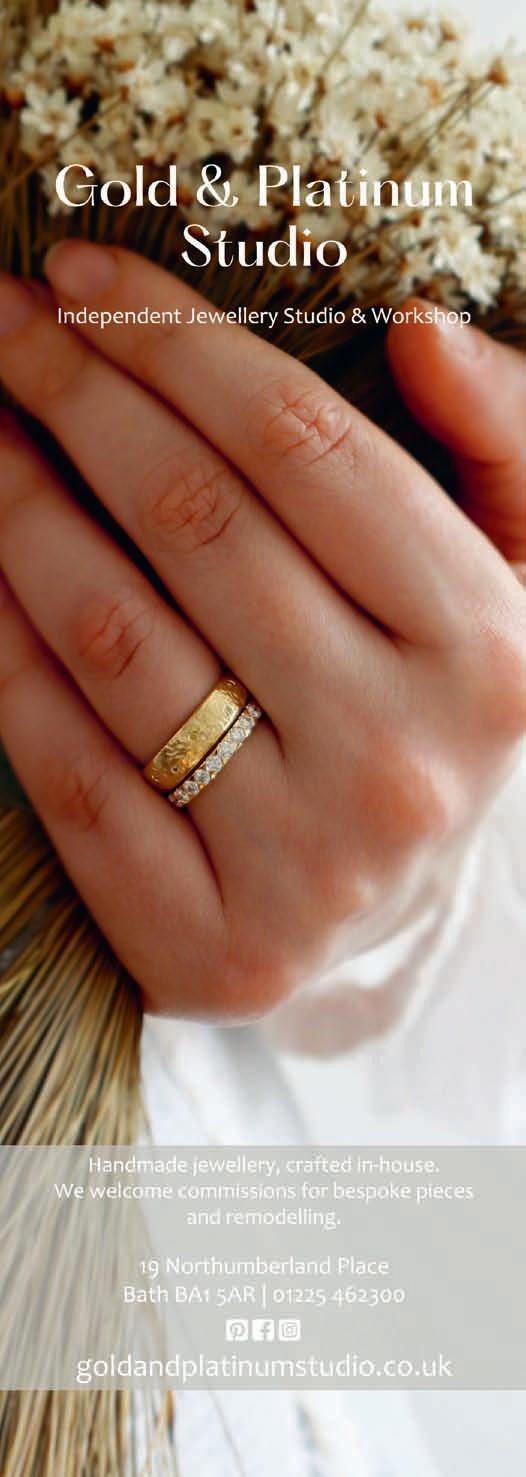
What’s on and things to do
Be immersed in the world of Shakespeare galore. There’s Peter Pan, Sherlock Holmes, slapstick, laughter, and so much more. This delightful, openair theatre festival returns to the Holburne Museum Gardens for its 4th brilliant year. Sip a cooling drink under a warm sunset and relax on your rolled-out blanket, and should the summer skies misbehave then the new covered shelter allows the show to go on. Great fun, book your tickets.
The Holburne Museum, Great Pulteney Street, Bath BA2 4DB. Web: gardentheatrefest.co.uk

The Jane Austen Festival in Bath is the largest and longest running Jane Austen Festival in the world. The festival begins with a Regency costumed promenade, which has been filling the streets for Bath with over 500 people in Regency dress since 2004 and holds the Guinness World Record for the largest gathering of people dressed in Regency costumes. It’s great fun to see and take part... and very, very ‘Bath’.
Web: janeausten.co.uk/pages/festival-updates-2024

Sun, sea, sand… and the city
Bath on the Beach brings Caribbean vibes to the heart of the city. Mix in some cocktails, games, food and ice cream, and you’ve got yourself a celebration of all things summer. Head down to Royal Victoria Park and relax in one of the specially set-up hammocks or cabanas – available for larger groups – or grab a shaded spot under the palm trees. If you’re after something more active, there is beach volleyball, adventure golf, table tennis, boules, bar games as well as Euro 24 screenings and more for all to enjoy. And the best part: entry is free!
Web: bathonthebeach.co.uk

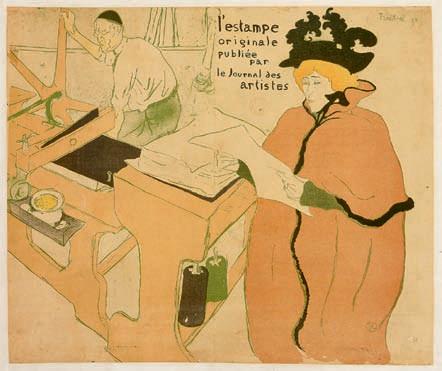
Toulouse-Lautrec and the Masters of Montmartre
From cancan dancers to the legendary ‘Chat Noir’ the show features 100 original posters from 1890s Paris.
26 April –29 September, Victoria Art Gallery, Bridge Street, Bath; Open Tues –Sun, 10.30am–5pm; Web: victoriagal.org.uk
Henry Moore in Miniature
This retrospective of Moore’s sculptures that could fit in the hand shows over 60 works that do not exceed 30cm.
3 May –8 September, Holburne Museum, Great Pulteney Street, Bathwick Open daily 10am to 5pm; Web: holburne.org
Mr Doodle! Museum Mayhem
The first ever UK museum exhibition of internationally renowned artist and internet sensation, Mr Doodle.
3 May –1 September, Holburne Museum (as above)
American Road Trip
A journey through the diversity of American landscapes, history and culture in a family friendly exhibition.
Until 31 September, American Museum & Gardens, Claverton Manor, Claverton Down Open Tues–Sun 10am to 5pm; Web: americanmuseum.org
Bath Contemporary Artists’ Fair
A monthly fair celebrating the diversity of contemporary art, showcasing the works of artists from across the region.
Sunday 9 June, 14 July, 11 August, 8 September Green Park Station, Green Park Road, Bath, 10am – 5pm; Web: bcaf.co.uk

It’s your time in Bath, so spend it well. Our very own round-the-clock tour guide Melissa Blease counts down the hours for a one-day or a two-day stay
• 8am –wake up to Bath
If you’ve only got one day in Bath, you need to get moving early to make the most of it... So use your post-breakfast quiet time to check out the addresses that the hoards are set to congregate around later on: the honey-coloured curves of the Royal Crescent and the Circus, the breathtakingly impressive, clean lines of Great Pulteney Street and the elegant Milsom Street area are all at their stage-set best when bathed in the early-morning sunlight.
• 10am –culture calling
Your attention levels should be at their peak around now, so take your pick of the fabulous historic tourist attractions in the vicinity of the city centre. Choosing just one option is a tough call, but if you’re time-limited, you’re not going to be able to take them all in; fortunately, either the Roman Baths, the brilliant Holburne Museum or Victoria Art Gallery can be ‘done’ in a single two-hour blast.
• 12 noon –lunch on-the-go
If the weather is behaving nicely, lunchtime is the opportunity for a spot of al fresco refuelling set against one of the city’s historic backdrops, including Royal Victoria Park, historic Queen Square and the dramatic weir waterfall; grab a bespoke, instant picnic lunch and munch your sarnies in style. If, however, it’s a bit too wet or chilly, a myriad of splendid cafés, restaurants and bars all vie for your attention.
• 2pm –get wet
Immerse yourself in the tranquil surroundings of the Cross Bath. Part of the Thermae Bath Spa Complex, this intimate, standalone, open-air thermal bath – an official ‘sacred site,’ complete with its own changing facilities – offers a uniquely peaceful alternative to the more extensive spa experience offered in the main New Royal Bath. Cross Bath sessions last a nice, neat 1½ hours including changing time, and a towel and robe are included in the entry price.
• 4pm –afternoon amble
Enjoy tea and cake at one of Bath’s many independent cafés
before taking time to wander, browse, compare and contrast the distinctly different atmospheres between the fascinating, eclectic Walcot Street, the chic’n’glamorous area around Milsom Street and the popular Southgate development , picking up souvenirs of your time in the city as you go.
• 6pm –speedy supper
If your time in the city is limited, you probably won’t want to linger long over dinner. Fortunately, a proliferation of pretheatre and early bird menu deals offer gourmet feasts at a fraction of standard à la carte prices between 6pm–7.30pm at restaurants across the city, usually detailed on easy-to-spot Aboards outside their doors. If you’ve been organised enough to book a hot ticket for a show at the Theatre Royal, the Ustinov Studio, The Forum, The Little Theatre Cinema, Komedia, Chapel Arts Centre or The Pavilion, your evening is planned. If, however, you’re footloose and fancy free...
• 8pm –fun‘n’frolics
For a fabulously fun tour around the ancient and mystical streets of Bath and to hear spine-chilling stories from the vaults of the city’s history, the super-spooky Ghost Walks of Bath tours start outside the Abbey main door at 8pm on Wednesday, Thursday, Friday, Saturday and Sunday evenings throughout the year, and between May and October tours run 7 nights a week. But if rain stops play or you’ve done enough walking for one day, head for the Green Park Brasserie to enjoy free, live acoustic jazz/swing in an atmospheric former Victorian railway station every evening from Wednesday to Saturday, or The Bell (Walcot Street), which offers a warm welcome to one and all supplemented by a diverse range of live music three to four times a week on evenings (Monday, every other Tuesday and Wednesday from 9pm) ranging from jazz to blues to folk to roots. Meanwhile, St James Wine Vaults (James Street) hosts regular live music, performance poetry and interactive pub quizzes throughout the week.
It’s been a long day! But if you’re still up for a little more of Bath, the Nightlife section (page 126) can point you in the right direction of all manner of grown-up fun. If, however, you’re ready to hit the pillow – sweet dreams!

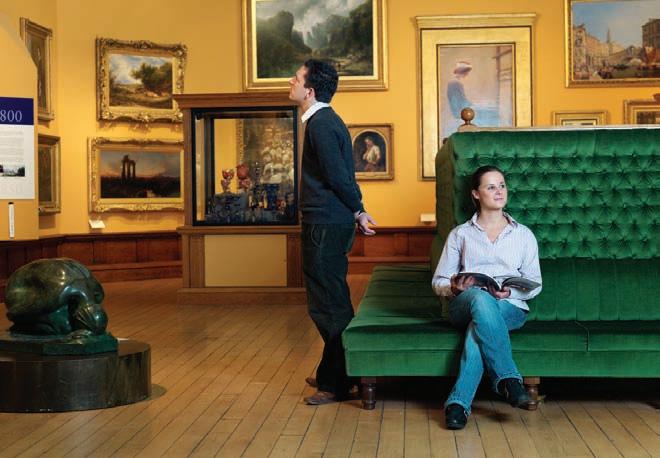





The basic ingredients for making the most of the overall Bath experience are listed in our one-day tour. But if you’ve got time to delve deeper, supplement your stay with these add-on ideas.
• Make time to step back in time
Lose yourself in Bath’s rich history with the Bath Museums Saver Ticket, offering discounted entry to the Roman Baths and special exhibitions at the Victoria Art Gallery – if you’ve got two days to spend in the city, you can give these museums the attention they deserve. And for special interests, check out the city’s great smaller museums and art galleries.
• Bliss out
Turn a visit to the Thermae Bath Spa into a highlight of your stay, supplementing the standard two-hour session with a treatment from the Treatment Menu or a package that includes lunch or dinner at the spa’s Springs Café. The spa’s spectacular Rooftop Pool offers breathtaking views over the city; naturally seductively steamy at any hour of the day, it’s particularly magical at sunset even during the autumn/winter months.
• Tease yourself
Upgrade the mid-afternoon café/coffee shop break to an unforgettable Afternoon/High Tea experience at the Pump Room, the Gainsborough Bath Spa Hotel, the Royal Crescent Hotel, The Ivy or Sally Lunn’s for a ‘Bath Bunn’.
• Post-sunset shenanigans
A two-night stay in Bath offers the opportunity to turn one evening into showtime (see venue suggestions on the 12-hour itinerary) and another into an unforgettable gourmet extravaganza. Tasting Menu plus optional Wine Flight experiences go large at Bath’s best hotels and restaurants, where some of the UK’s best chefs (Chris Cleghorn at the Michelinstarred Olive Tree Restaurant, Jauca Catalin at the Bath Priory and Martin Blake at the Royal Crescent) are waiting to take
your order. Elsewhere, you can’t go wrong with the vegetarian and vegan celebrations at Oak (previously Acorn Vegetarian Kitchen), or Rob Clayton’s uplifting, stylish modern bistro dishes at his eponymously named Clayton’s Kitchen.
A map is the most useful accessory a visitor can equip themselves with. But if you’ve got a couple of hours to spare bring the map to life by heading up the Wellsway and taking in the glorious views from Alexandra Park: behold, the city in miniature, awaiting your investigation.
Mayor’s Guide Walking Tours – led by local volunteers who are knowledgeable and passionate about the city – are free. Don comfortable shoes and hook up with the group outside the Pump Rooms at 10.30am and 2pm from Sunday to Friday and at 10.30am on Saturday. All walks last around two hours.
The Theatre Royal releases 40 gallery/side bench/perch tickets priced from around £13.50 on all performance days (maximum two tickets per person). These are available for booking as soon as tickets are for sale, and are available at the box office or online.
City Sightseeing buses depart from Bath Abbey on a regular basis and offer two options: the City Route and the Skyline Route, which takes voyagers through the countryside high in the hills that surround Bath. Both routes include an experienced guide who provides a fascinating commentary on the points of interest as you travel. Hop on/hop off tickets are valid for 24 hours.
Then you qualify for a trip to one of the spectacular villages, towns and visitor experiences within easy access of Bath.
• Approximately 15 miles/24km
The super-pretty village of Castle Combe (as seen in Steven Spielberg’s War Horse and the original film version of Dr Dolittle with Rex Harrison singing Talking to the Animals) represents the very meaning of the words ‘picturesque’ and ‘quaint’.
• Approximately 17 miles/27km
Even if you’re not a Harry Potter fan, Lacock Abbey – the interior of which doubled-up as the interior of Hogwarts in two of the Harry Potter films – is as enchanting and magical as the ancient, quintessentially English village of Lacock.
• Approximately 22 miles/35km
Wells (the smallest city in the UK) features a magnificent 13thcentury cathedral – surrounded by the unique, moated Bishop’s Palace. Meanwhile, Stonehenge, Westonbirt Arboretum, Longleat, Highclere Castle (aka Downtown Abbey), Glastonbury and Cheddar Gorge are all within easy access /drives from Bath.
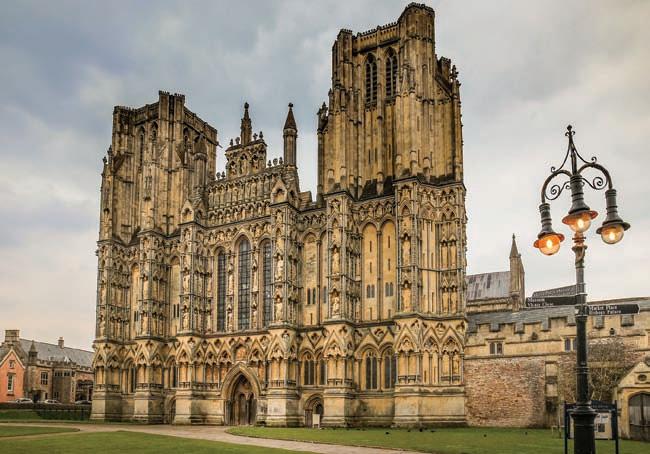
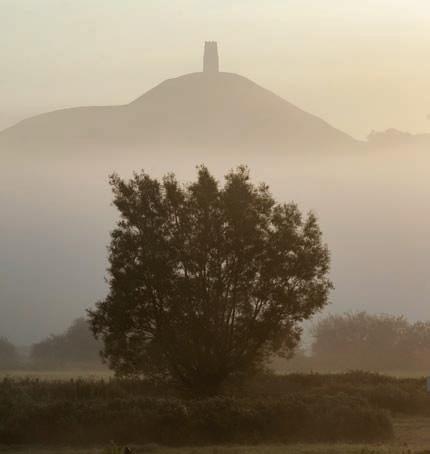
1. The magnificent Gothic façade of Wells Cathedral
2. Steeped in legend, the mysterious Glastonbury Tor looks over the mythical Isle of Avalon
3. The prehistoric standing stones of Stonehenge near Amesbury in Wiltshire
4. The picturesque village of Castle Combe
5. The cloisters of Lacock Abbey, where many a scene from Harry Potter has been filmed



HISTORICAL SITES
Roman Baths
Bath Abbey
The Pump Rooms
Assembly Rooms
Royal Crescent
The Circus
Pulteney Bridge
Sally Lunn’s House
Beckford’s Tower
MUSEUMS & GALLERIES
Bath Royal Literary & Scientific Institution
Herschel
Holburne




Bath has a long and rich history –Here’s a whirlwind tour through some of its key moments
• 863 BC: According to the legend, having healed himself and his herd of pigs from leprosy by bathing in the hot mud irrigated by the naturally heated spring waters, Bladud –son of King Rud Hud Hudibras and tenth ruler of the Britons in line from the first King Brutus, (aka Brute of Troy) –takes his rightful title of King (and founder) of Bath.

• AD 43: The Romans arrive and name the city Aquae Sulis, after the goddess Sulis Minerva –a considerable urban settlement is created on the site to include grand temples and bathing complexes.
• 577: The West Saxons win the Battle of Deorham and capture Bath, incorporating it into the Saxon petty kingdom of the Hwicce.
• 878: Bath becomes a royal borough of Alfred the Great’s Kingdom of Wessex.
• 973: Edgar, King of England 959–975, is crowned alongside his wife Ælfthryth at Bath Abbey by Dunstan, Archbishop of Canterbury.
• 1088: Benedictine monks take over the abbey and start to build a massive cathedral priory, complete with Bishop’s Palace.
• 1090: John of Tours moves the episcopal seat to Bath, giving it city status.
• 1137: Much of Bath is destroyed by a fire that ravages the city.
• 1499: Oliver King, Bishop of Bath and Wells, begins reconstruction of the now neglected abbey, which surrenders to the Dissolution of the Monasteries act in 1539.
• 1576: The Queen’s Bath is built, with a drinking fountain installed in 1578.
• 1590: Bath’s city status is confirmed by Queen Elizabeth I.
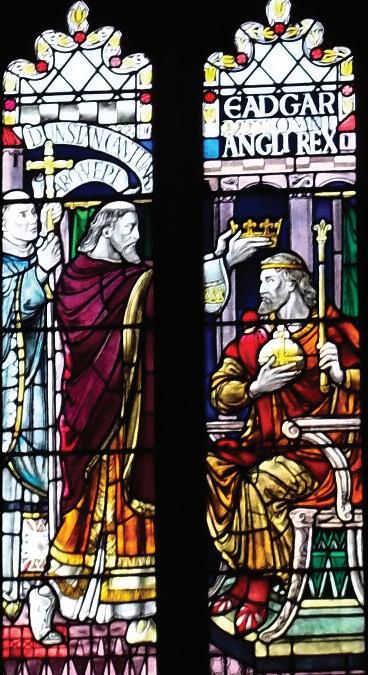
• 1657: The first regular coach service between London and Bath is established.
• 1702: Queen Anne visits Bath, confirming the city as a fashionable destination and focal point for social activity outside of London.

• 1704: Richard ‘Beau’ Nash is appointed Master of Ceremonies.
• 1712: Entrepreneur and philanthropist Ralph Allen is appointed postmaster.
• 1725: Architect John Wood the Elder develops an ambitious plan for his home town and presents them to Ralph Allen for consideration.
• 1726: Allen begins buying up Combe Down and Bathampton Down Mines for building stone.
• 1727: A gilt bronze head from a cult statue of Sulis Minerva is found by workmen excavating a sewer near the Roman Temple.

• 1742: Ralph Allen is elected mayor of Bath.
• 1755: The Royal Crescent, designed by John Wood the Younger, is completed and the Roman Baths are rediscovered following the demolition of the Duke of Kingston’s Abbey House.
• 1761: Beau Nash dies, and the Corporation of the City fund a lavish, elaborate funeral. Nash is buried in the nave of Bath Abbey.
• 1762–1764: Scientist and astronomer William Herschel arrives in Bath and Brock Street is built.
• 1769: The Circus is completed; Pulteney Bridge is constructed.
• 1771: The New (Upper) Assembly Rooms are built.
• 1775–1777: The Hot Bath is built.
• 1780: The Roman Great Bath is rediscovered by Major CE Davis while exploring a leak from the King’s Bath.
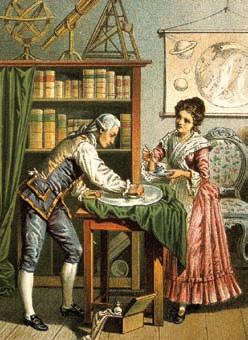
• 1781: William Herschel makes the first observation of the planet Uranus from the back garden of his house in New King Street.
• 1783–1784: The Cross Bath is built.
• 1793: The devastating Bath bank crash causes temporary havoc to the construction industry.
• 1795: Sydney Gardens opens as Bath Vauxhall Gardens, a commercial pleasure garden. The Grand Pump Room opens.
• 1797–1798: The Cross Bath is developed and increases in size.

• 1801: Jane Austen moves to Bath and stays in the city for almost five years. The Austens resided mostly in the newly built 4 Sydney Place, overlooking Sydney Gardens.
• 1804: Construction of the New Theatre Royal on Beaufort Street/ Saw Close begins.
• 1805: The Orchard Street Theatre closes its doors for good. The New Theatre Royal opens to the public.
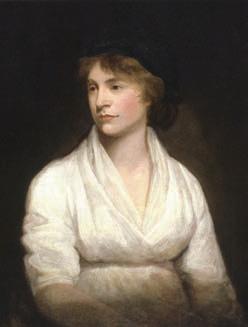
• 1816: Mary Wollstonecraft Shelley arrives in Bath. By December her writing on the novel Frankenstein was well underway.
• 1830: Victoria Park is opened by 11-year-old Princess Victoria (later queen) as a private pleasure ground.
• 1831: Jolly’s on Milsom Street opens as The Bath Emporium, one of the very first department stores to open in the UK.
• 1840: Isambard Kingdom Brunel builds the Bath Spa Train Station for the Great Western Railway. The First

Penny Black postage stamp is used to send a letter by Thomas Moore Musgrave, postmaster of Bath.
• 1861: The Guildhall Market is built on a site that had been used for trading for more than 800 years.
• 1862: The New Theatre Royal is destroyed by fire. The refurbished theatre opens again in 1863.
• 1865: Bath Rugby is founded by members of Lansdown Cricket Club as Bath Football Club.
• 1893: The Holburne Museum opens on Charlotte Street.
• 1923: The Roman hot plunge baths are excavated.
• 1936–1941: Haile Selassie, deposed Emperor of Ethiopia, is exiled in Bath.

• 1938: The Assembly Rooms reopen after restoration.
• 1942: Three German aerial bombing raids –part of the Baedeker Blitz –kill 417 Bath residents and destroy or badly damage the newly restored Assembly Rooms.
• 1955: The Assembly Rooms reopen, incorporating the

Museum of Costume ; The Beatles play at Bath Pavilion.
• 1987: Bath is inscribed by UNESCO as a World Heritage Site.
• 1997: The Ustinov Studio opens at the rear of the Theatre Royal.
• 2005: The egg, a venue for children’s, young people’s and family theatre, opens.
• 2006: The Thermae Bath Spa opens to the public.

• 2009: The SouthGate shopping centre and a brand new bus station opens.
• 2021: The City of Bath receives a second World Heritage Site inscription as one of the Great Spa Towns of Europe.
• 2022: Bath Abbey’s Footprint Project is completed, including the abbey’s historic floor being saved from collapse and underfloor heating powered by Bath’s hot springs.
Melissa Blease takes a tour of Bath’s most popular visitor attraction and discovers a world-class experience POSTCARDS
Despite Senator Tacitus describing the taking of the waters as “one of the luxuries that stimulate vice,” the Romans started the development of Aquae Sulis as a sanctuary of rest and relaxation some time after the Roman invasion of Britain in AD 43. Over the next three decades, they built a reservoir, a sophisticated series of baths and a temple dedicated to the goddess Sulis Minerva around the natural hot springs. The temple was constructed around 60–70 AD, and the bathing complex was gradually built up over the next 300 years.
But after the Roman withdrawal in the first decade of the fifth century, the bathing complex fell into serious disrepair and was eventually lost to silting and flooding. The vaulted building around the spring collapsed into the waters in the sixth or seventh century, but the oak piles that were sunk into the mud continue to provide an integral part of the stable foundations today.
The various street level aspects of the Roman Baths, The Grand Pump Room and the Stall Street entrance were designed in the 18th century by Thomas Baldwin and John Palmer, two of the leading architects of Georgian Bath who, alongside John Wood the Elder, John Wood the Younger, Robert Adam and John Ev eleigh, are responsible for most of the Palladian-style architecture for which Bath is so highly regarded.
Throughout the 18th and early 19th century, visitors flocked to fashionable, genteel Bath from far and wide to drink the mineralrich spring waters and socialise in the Grand Pump Room, the

neo-classical salon within the Roman Baths complex. As Jane Austen – who moved with her family to Bath in 18 01 for what her family deemed to be health benefits – wrote in Northanger Abbey, “every morning brought its regular duties: shops were to be visited; some new part of the town to be looked at: and the Pump Room to be attended, where they paraded up and down for an hour, looking at everybody and speaking to no one.”
Both the Pump Room (which remains in use as a tea room and restaurant today) and the Roman Baths fortunately offer a far friendlier, more accessible welcome to contemporary visitors, centuries on – and the complex still remains very much a fully functioning, sparkling jewel in the city’s crown.
Time may not stand still for the Roman Baths, but the defining purpose at the core of the complex remains the same ❝
In 2021, a new area was unveiled at the Roman Baths. The Roman Gym (part of the main visitor journey around the Roman Baths) was renovated amongst newly excavated remains, and allows visitors access to a courtyard where Romans worked out before heading into the baths. The gym itself includes the remains of an ancient sauna (a laconicum) and one of the best preserved doorways from Roman British times, while projections showing how the Romans would have used the gym, and audio commentary explaining Roman workouts and the Roman attitude to health, wellbeing and medicine brings the whole area to fully authentic life.
The state-of-the-art Clore Learning Centre – an ambitious restoration initiative (also part of the Archway Project) that allows school and community groups to learn all about history and heritage in a hands-on, accessible way – opened a year later and was unveiled at the same time at Bath World Heritage Centre, which offers a central point for visitors to find out about the citywide UNESCO World Heritage site’s hot springs, Roman remains, Georgian architecture, Georgian town planning, the social setting of the Georgian spa town and the city’s natural landscape setting.
Time may not stand still for the Roman Baths, but the defining

purpose at the core of the complex remains the same. The site’s permanent collection contains thousands of archaeological finds from pre-Roman and Roman Britain including a fairly recent addition known as the Beau Street Hoard, which was excavated by archaeologists on the site of the Gainsborough Bath Spa Hotel in Beau Street in 2007 and is today widely acknowledged to be one of the most remarkable archaeological discoveries ever to have been made in Bath: 17,655 Roman coins were found fused together in eight separate money bags and spanning the period from 32 BC–274 ad.
Elsewhere, exhibits range from the divine to the domestic. In the Temple Worship area of the museum, the gilt bronze head of the goddess Sulis Minerva, for example, is an ancient, awe-inspiring showpiece, while catching the eye of the imposing Gorgon’s head that glowers down from the top of the grand ornamental Temple Pediment (the temple itself being one of only two classical style temples in Britain, depicting the merging of local and Roman beliefs) is a curiously thrilling experience. Offering delightful contrast to the more dramatic exhibits on display, the brooches, combs, jewellery, glass bottles and general domestic paraphernalia discovered buried beneath the foundations of the present buildings offer a fascinating, evocative snapshot of everyday Roman life and create a strong link of familiarity between the past and the present.
Meanwhile, the curiously moving Roman Curse tablets (‘defixiones’, inscribed on to small sheets of lead or pewter and believed to range in date from the second to the late fourth century ad) depict the private and personal prayers and wishes of 130 individuals and provide a uniquely personal insight into Roman life. Addressed to the goddess Minerva Sulis, many request stolen items be returned, but others are scarily malevolent, seeking more severe levels of justice be served: “Docimedis has lost two gloves and asks that the thief responsible should lose their minds and eyes in the goddess’ temple”.


The tablets are the only objects from Roman Britain to be included within UNESCO’s Memory of the World register, which aims to preserve, promote and protect written and audiovisual heritage while encouraging universal access to social history.
A visit to the Roman Baths is a multi-textured, comprehensive experience offering broad appeal to all ages, tastes and interests. Even those who may n ot think they’re visiting Bath to learn more about the history of the Heritage City can’t fail to realise that it’s all around us, at every turn – and never more so than within the domain where Bath began.
A
It is recommended that you allow between around 90 minutes up to 2 hours for your visit. Portable, fact-packed audioguides that can be stopped, started, and rewound according to your schedule and particular interests are included as standard in the admission price, including all-age guides and a children’s guide –or, take the popular Anglo-American travel writer Bill Bryson’s witty, incisive thoughts and observations on Roman life, history and society on the tour with you. While it may not be to everyone’s taste, at the end of your visit you have the opportunity to sample the hot natural spa water. Salute!
The Roman Baths, Abbey Church Yard, Bath BA1 1LZ
The Roman Baths is open every day except 25 and 26 December.
For specific seasonal opening times, admission prices, special events and accessibility details, visit the Roman Baths website.
Tel: 01225 477785
Web: romanbaths.co.uk
A DISPLAY OF THE BEAU STREET HOARDIn 2023over 1 million people visited the Roman Baths. The second most visited attraction outside London. Stonehenge being first.
Hot water at a temperature of 46°C (114.8°F) rises at the Roman Baths at the rate of 1,170,000 litres every day.
The spa water originally fell as rain around 10,000 years ago. It sank to a depth of around 2km below the earth’s surface, where it is geothermally heated before rising back up to one of Bath’s three springs: the Cross Bath Spring, the Hetling Spring or the King’s Spring, which supplies the Roman Baths.
Bath spa water contains more than 43 minerals and trace elements, the most concentrated of which include calcium, magnesium, sodium and iron.
The Great Bath holds 225,000 litres of water.
The Temple of Sulis Minerva in Bath is one of only two classical temples known from Roman Britain, the second one being the Claudius Temple in Colchester.
The tranquil Cross Bath – part of the grander Thermae Bath Spa complex but situated in an independent setting – is an official sacred site with ancient origins; some historians claim that, around 7,000 years ago, the site was occupied. Indeed, Mesolithic flints found in the spring support this and there was human activity all round the area.
It’s impossible to estimate exactly how much the Beau Street Hoard (17,655 Roman coins) would be worth in real terms today. If you’d like to imagine going shopping Roman-style, an amphora of wine would have cost you 300 Sestertii, you could buy 200 pounds of flour for just one Aureus and a slave would set you back 500–1,500 Denarii.
The terrace overlooking the Great Bath is lined with Victorian statues of Roman emperors and governors of Britain including Constantine the Great, Julius Caesar, Claudius and Hadrian.
The statues on the terrace date to 1894, and were carved in advance of the grand opening of the Roman Baths in 1897.
Visitors could still occasionally bathe in the Great Bath (and some of the smaller baths) up until 1978. However, following the discovery of a dangerous amoeba, which was active in the water, the baths were closed for bathing.
The spring water that supplies the Thermae Bath Spa today is drawn from new boreholes drilled beneath the King’s Spring and the Cross Bath between 1983–1985, and the Hetling Spring in 1998 and 2011. The water is tested weekly and is consistently declared safe.

Handmade in the Heart of Bath

ENGAGEMENT AND WEDDING RINGS HANDMADE BESPOKE JEWELLERY REPAIRS AND REMODELLING
9 ABBEY CHURCHYARD, BATH BA11LY
01225 460072



The Royal Crescent is one of the most breathtaking architectural treasures, says Jessica Hope
With its 114 Ionic columns, honey-coloured stone and curved symmetry spanning 150m (500 ft), the Royal Crescent is one of the most majestic examples of 18th-century Palladian-style architecture in the UK, and as such it is protected by a Grade-I listed status.
Between 1767 and 1775 architect John Wood the Younger designed and oversaw the construction of this magnificent semiellipse of buildings. His father John Wood the Elder had brought Palladianism to Bath with his developments in and around Queen Square (1725–1736) and the Circus (1754–1768). The Crescent was the final sequence in this architectural masterplan.
Wood employed various builders on each of the 30 houses, and while he was particular about maintaining the dimensions and design across the façade, he allowed purchasers the freedom of budget to do what they liked inside and at the back. This is why the depth of the buildings and roof lines differ behind the Royal Crescent, and the windows are not all aligned. This architecture, often described as ‘Queen Anne fronts and Mary-Anne backs’, is an indication of the wealth of the initial owner.
The Royal Crescent was the first crescent of terraced houses to be built ‘rus in urbe’ (country in the city) as it overlooked parkland and offered fashionable visitors city residences that had the same style and grandeur as the houses in their country estates.
A Ha-Ha remains to this day – a ditch separating the upper and lower lawns mainly to keep grazing animals off the upper lawn, but is near invisible to anyone running down - hence the unsympathetic name.
On completion, the Crescent became one of the most sought-after addresses in the city. It adopted the title ‘Royal’ at the end of the 18th century after Prince Frederick, Duke of York and Albany, had stayed there.
Drawn by the Assembly Rooms and the thermal waters, by the late 18th century Bath had become a centre for the leisurely classes to take the waters, socialise, gamble and purvey the marriage market. To see and be seen was considered the most desirable of diversions and those in wealthy (and not so wealthy) society used Bath’s open spaces, such as the Royal Crescent, Circus and Queen Square, to promenade, meet their friends and gossip.
Currently, of the crescent’s 30 townhouses, 10 are still full-size houses, 18 have been split into flats of various sizes, one is the No. 1 Royal Crescent museum, and the two central houses with the entrance at number 16 is the splendid Royal Crescent Hotel.
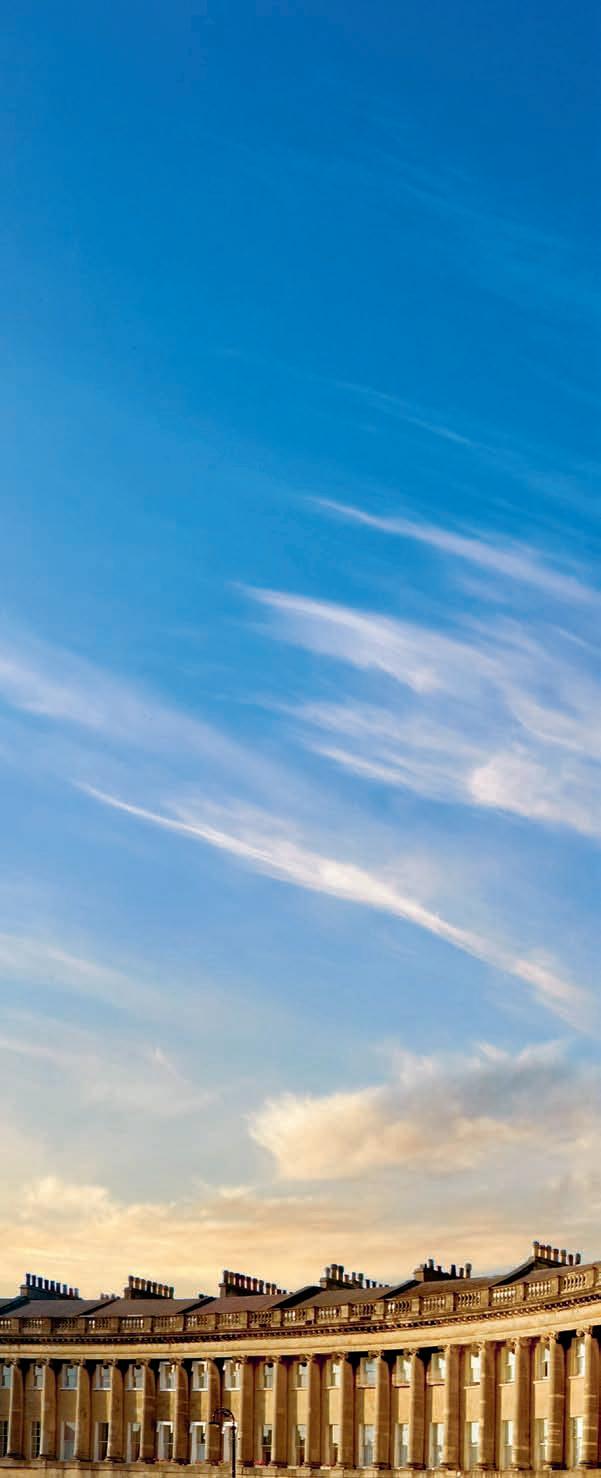

Melissa Blease digs deep into the architectural roots of Bath, and celebrates the pioneers responsible for creating some of the city’s most loved and distinct buildings
Despite enduring a Roman invasion, being granted official city status more than nine centuries ago, and with a regular London coach service since 1657, Bath in the late 17th century was little more than a quiet market town with a population of just 2,000. But this was about to change.
In 1702, Queen Anne visited Bath and publicly endorsed the medicinal, mineral-rich properties of the city’s spring water, declaring that it helped to ease her painful gout. She visited Bath regularly to take the waters with the aim of seeking a cure.
Within two years of the royal visit, Richard ‘Beau’ Nash relocated to Bath from London to claim the mantle of Master of Ceremonies, presiding over the social and cultural events of a city that was turning into the UK’s most fashionable merrymaking zone. Eight years later, 17-year old Ralph Allen swapped his job behind the counter of his family’s post office in Cornwall to work as an assistant to the postmistress of Bath.
Allen soon became the youngest postmaster in the UK in 1712, at the age of 19. An instinctive entrepreneur and avid philanthropist, he went on to reform the country’s postal system by introducing a ‘signed for’ mail initiative to guarantee security, and improving speed and efficiency by no longer directing mail via London.
In a move that exemplified his passion for enterprise, combined with an innate aptitude for logistics, in 1726 Allen used the small fortune he had made from revolutionising the postal system to purchase the quarries at Combe and Bathampton Downs, and built a railway to carry huge blocks of stone into the city.
Around the same time, architect John Wood (born in Bath in 1704) had recently returned to the city from London, where he’d been involved with the Cavendish-Harley housing estate development in Mayfair. Wood the Elder discovered a natural affinity with Allen and they developed an ambitious plan for the architectural regeneration of Bath. Working closely together, the

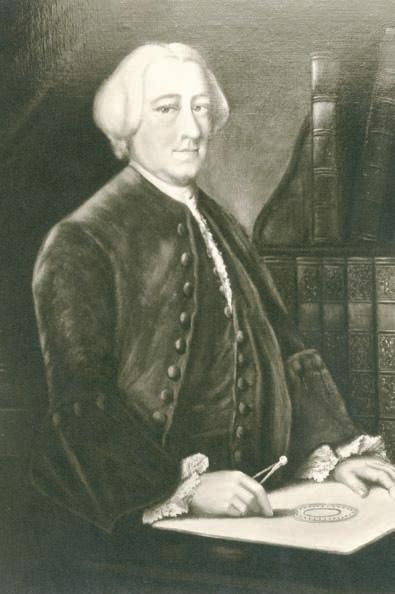
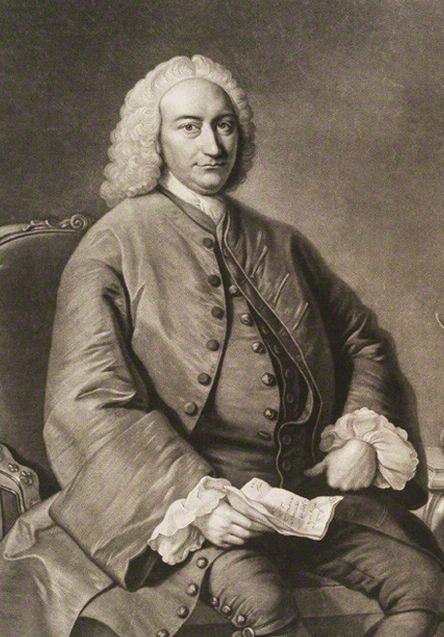
duo was largely responsible for the development of Georgian Bath.
Combining his passion for Palladianism (after 16th-century Venetian architect Andrea Palladio) and his fascination with ancient British history, Wood the Elder’s overall vision was to turn Bath into ‘the Rome of Britain’, complete with a Circus Maximus and Forum. While the Corporation of Bath initially looked upon his grand designs as self-indulgent, they eventually conceded that Bath’s popularity was creating a need for accommodation for visitors and new long-term residents. Using Wood the Elder’s designs, work on Queen Square – named in honour of George II’s consort, Caroline –began in 1729; leading by example, perhaps, Wood the Elder took one of the centre houses for himself.
While Queen Square was still a work in progress, Wood the Elder also undertook a commission from Allen to build a new home to display his new-found status. The pair chose a plot of land that lay just outside Bath’s original city boundaries to build Prior Park, an imposing Palladian mansion set in 28 acres and overlooking the city. Completed in 1743, the park was described by British author and man-about-town Philip Thicknesse as ‘a noble seat which sees all Bath, and which was built, probably, for all Bath to see’.
While their partnership came to an end during the project, they remained firm friends. Allen used Prior Park to entertain influential personalities of the day including artist Thomas Gainsborough, theatrical impresario David Garrick and novelist and dramatist Henry Fielding. All of these he proudly introduced to Wood the Elder who, by 1728, had completed his first private commission in Bath, a new building for St John’s Hospital in the city centre.
Wood the Elder’s greatest architectural gift to Bath had yet to be revealed. The Circus, named after the original Latin word for a circle or ring, comprised 30 terraced houses on an orbicular layout, divided into three sections of equal length, based around a central lawn. When viewed from the air The Circus, Gay Street and Queen Square form the shape of a key. This ancient masonic symbol shows Wood the Elder’s fascination with Freemasonry, a nonreligious fraternity established at the end of the 14th century by local stonemasons aiming to regulate fair interaction with clients. Freemasonry was described by one of the original founding

members as ‘a beautiful system of morality, veiled in allegory and illustrated by symbols’. Wood the Elder’s connections are further endorsed if you wander The Circus and see the frieze that runs along the elegant curved facades, decorated with 525 pictorial emblems including nautical symbols, swords, mythological and legendary beasts and representations of the arts and sciences. Wood the Elder never saw his most magnificent, ambitious work completed – he died three months after laying The Circus’ first foundation stone in 1754. But the family’s legacy doesn’t end there.
John Wood’s son John was born in Bath in 1728 – the same year his father moved back to the city from London. From his early childhood, Wood the Younger was captivated by his father’s work. In 1749, when Wood the Elder temporarily relocated to Liverpool to oversee the initial stages of his design for the city’s new town hall, Wood the Younger went with him. After Wood the Elder died, Wood the Younger took over, building The Circus (completed in 1768) and Gay Street, which provided an elegant thoroughfare twixt The Circus and Queen Square.
Over the coming years, Wood the Younger created a new architectural image for Bath, a bold, neo-classical style different to the more ornate, embellished frontages of his father. This is most sharply represented in Wood the Younger’s designs for buildings such as the Assembly Rooms, a U-shaped building based around a grand central aisle linking a Tea Room, Card Room, Ball Room and Octagon Room. This was purpose-built in 1771 to host the Assembly, an 18th-century entertainment venue.
Wood the Younger’s ultimate masterpiece was Bath’s Royal Crescent, completed in 1774. The 500ft/150m elegant, sweeping curve of 30 grandiose terraced houses overlooking acres of pastoral paradise was later transformed into Royal Victoria Park. Exuding the discreetly luxurious glamour that Wood the Younger excelled in creating and renowned for its iconic architecture, the Royal Crescent was the first of its kind in the UK. It remains one of the most picture-perfect examples of Georgian architecture.
Over the 18th century, Bath’s population grew to almost 30,000 as the city moved from market town into fashionable metropolis. Today, 83,000+ residents and thousands of annual visitors and tourists offer gratitude to The Men Who Built Bath.

Bath Abbey sits at the very heart of the city. Rich in history and a notable example of fine Gothic architecture, it is one of the city’s most inspiring sights for visitors and pilgrims. Welook at its past, present and future
One might expect the principal religious building at the heart of the city of Bath to be a cathedral, but the magnificent, imposing church is actually an abbey – and the original church, built in around 757 AD by the Anglo-Saxons, was once a monastery.
Bath Abbey is the third building to stand on the spot where Christians have worshipped for over 1000 years. Dedicated to St Peter and St Paul, the Abbey is historically important for many reasons, and world-renowned as the site where King Edgar, the first king of a united England, was crowned in 973 AD. Until that point, England had been a series of small kingdoms, each run by their own leader; Edgar’s coronation paved the way for the future unity of the nation of England.
As you approach the Abbey from the impressive west front, o ne of the first things you’ll notice is the unusual stone carving, depicting angels climbing up – and tumbling down – a pair of ladders. This dates from the early 16th century, when Bishop Oliver King commissioned the building of a new abbey that was to be the forerunner of what we see today: the last great Medieval cathedral to be built in England before King Henry VIII’s Dissolution of the Monasteries closed the Abbey in 1539.
In 1573, permission was granted by Queen Elizabeth I for the restoration of the Abbey and it was completed in 1620. A second restoration with major changes were carried out by the City of Bath in 1833 resulting in much of the Abbey exterior we see today.
Admirers of Gothic architecture will appreciate the Abbey’s dramatic flying buttresses and the many windows which allow the interior of the building to be filled with natural light. At night, when the lights glow inside to welcome visitors, the Abbey can be clearly seen from the tops of the hills that surround Bath, earning itself the affectionate local nickname, the Lantern of the West.
The dramatic fan-vaulted ceiling in the main nave replaced the original wooden ceiling and was part of Victorian architect Sir George Gilbe rt Scott’s restoration of the Abbey during the 1860s. Scott, who also designed the Albert Memorial and the grand station at St Pancras Station, was also responsible for the handsome, ornate chandeliers, which were originally gas fired before being converted to electricity in 1979.
Original visitors to Bath Abbey would have been able to move freely around the nave, as it was not until the 19th century t hat wooden pews were installed, again at the behest of Gilbert Scott. As part of the recent renovation scheme for the Abbey, the pews – which were uncomfortable for long periods of sitting – were removed in order to free the space up for a variety of events and leaving the nave unadorned as it was in medieval times, or filled with seating when the occasion demanded it.
Bath Abbey is unique for the plethora of memorial plaques on its walls and floors. Only Westminster Abbey has more wall tablets than can be found in Bath: there are 1508 memorials, with 617 on the walls and 891 laid into the floor. Not all the individuals commemorated are interred in the Abbey, but they or

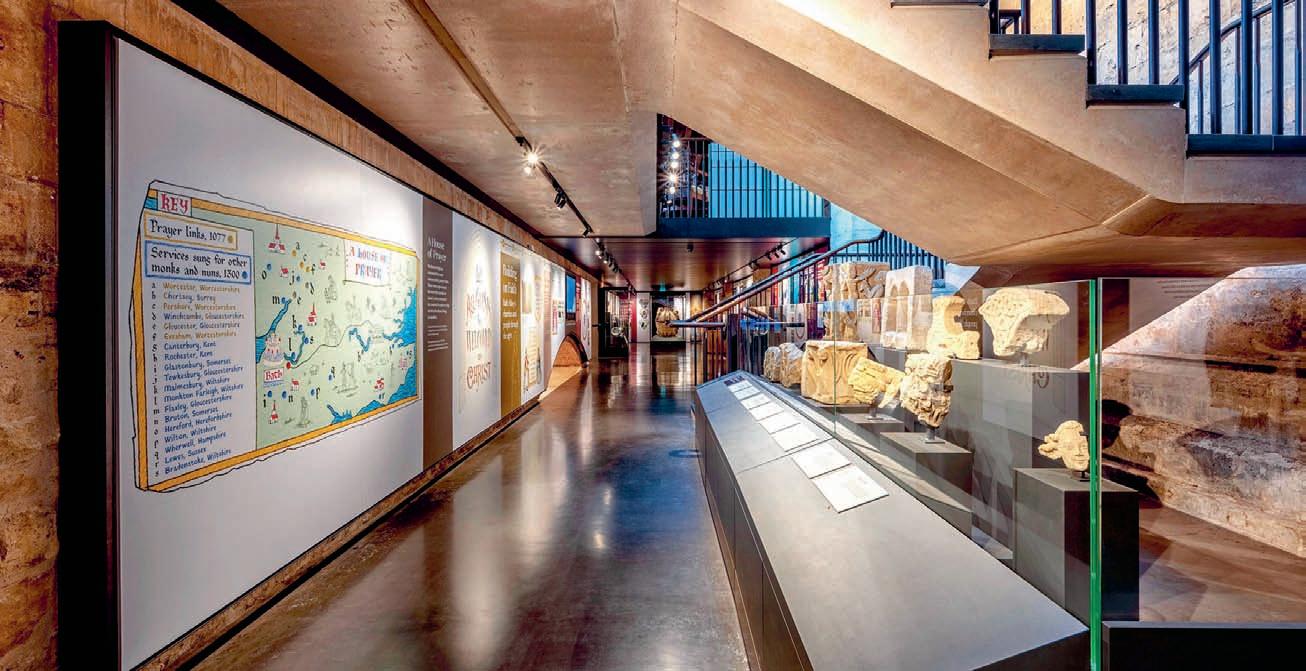
their families wanted a memorial to be placed here. Wander among the plaques and it quickly becomes apparent that it’s not only the lives of the wealthy and influential that are recorded; if you’re looking for a particular memorial stone, the Abbey’s volunteer guides are very knowledgeable.
If you have a head for heights, regular Tower Tours offer a memorable view of the city. A guide will lead you up the 212 steps to the top of the tower, pausing in the magnificent, awe-inspiring bell-ringing chamber on the way up. The views from the top of the 45-metre tall tower are spectacular – it’s no wonder that this eyrie has become a popular spot for marriage proposals.
In recent years, Bath Abbey’s ambitious, multi-million pound Footprint Project protected and restored the historic fabric of Bath Abbey while bringing it into 21st-century service.
The project started in May 2018 when the east end of the Abbey was closed off so that the collapsing floor could be stabilised, ecofriendly underfloor heating could be installed and the ledgerstones on the floor could be restored. When the first phase was completed and the east end reopened, the north side of the Abbey was closed to carry out the same work on the floor, heating and ledgerstones. A wealth of discoveries were unearthed during the archaeological digs (including a Medieval tiled floor that was in the Norman cathedral that once stood on the site of the current Abbey) and today, the Abbey has been opened up in new ways, securing its full glory for present and future generations of visitors.
A new LED lighting system and underfloor heating powered by renewable energy from Bath’s famous hot springs has made the whole site far more energy-efficient. There’s a brand new Song School alongside meeting rooms and office space in Kingston Buildings (adjacent to the Abbey), as well as a brand new Learning Room that has transformed the Abbey’s facilities and opportunities for the Abbey congregation, Bath residents and the city’s visitors alike. The Learning Room is regularly used by
visiting primary and secondary schools and is currently an integral part of the ‘warm spaces’ initiative across the city of Bath and for the provision of English lessons for Ukrainian refugees.
In March 2023 Bath Abbey’s Discovery Centre opened to the public. This unique heritage centre transformed the building’s newly excavated ancient vaults into a fascinating, accessible space that brings the Abbey’s history to life. Objects from the archives (including Anglo-Saxon crosses and Medieval fragments) are on display in the ancient vaults beneath the building, while interactive, immersive exhibits, videos, animated timelines and replica period costumes bring the history of this extraordinary building to vivid life for all ages. Meanwhile, the Abbe y Shop has undergone a complete transformation, not to be overlooked!
To maintain its high standard as a leading local heritage attraction and to remain a sustainable place for worship, the Abbey has an admission fee of £7.50. Local residents and those wishing to pray, worship and attend services are welcomed at no charge. There are regular prayers during the day and a roster of services throughout the week, details of which can be found on the Bath Abbey website.
Today, Bath Abbey is used regularly for secular events, concerts, art installations and more, and is a renowned centre of musicmaking. It’s vital to remember, however, that it primarily remains a dedicated place of worship for its congregation and the Christian community.
Visit: Bath Abbey, Bath BA1 1LT
Tickets: Adults £7.50, Students £6.00, Children (5–15) £4.00, Families 10% discount (up to 2 adults + accompanying children)
Open daily, Monday to Friday: 10.00am – 5.30pm, (6pm Saturday), Sunday: 1 .15 – 2.30pm and 4.30 – 6.30pm
Information on the Tower Tours can be found online or by visiting the abbey shop.
Web: bathabbey.org

Bath has been the subject of a great many books over the years – Saber Khan from Topping & Co booksellers picks four of the best for those wanting to discover the authentic pulse of the city
(THE HISTORY PRESS, £20),

For almost 300 years, excavations have been carried out in Roman Bath. At first these were rare and sporadic and archaeological finds were made by chance. Even fewer were reported. But from the 1860s, deliberate investigations were made and professional methods employed. The Roman Baths were laid open to view, but little was published. From the 1950s, interest accelerated, professionals and amateurs collaborated, and there was never a decade in which some new discovery was not made. The first popular but authoritative presentation of this work was made in 1971. From the 1990s to the present there has been some sort of archaeological investigation almost every year. This has thrown much new and unexpected light on the town of Aquae Sulis and its citizens. In this book, Peter Davenport, having been involved in most of the archaeological work in Bath since 1980, attempts to tell the story of Roman Bath and the ‘Three Hundred Year Dig’.
(THE BOOK GUILD PUBLISHING, £8.99)
Sometimes in Bath is a warm and witty story-tour through the city’s history, conducted by award-winning journalist, author and humorist, Charles Nevin. Many of Bath’s much-loved historical figures spring to life in episodes shimmering with the curious magic of the enchanted city. Each story has an afterword distinguishing the fiction from fact, adding enthralling historical detail and giving visitors useful links to Bath’s many fascinations.
AUSTEN IN BATH: WALKING TOURS OF THE WRITER’S CITY, KATHARINE REEVE
(THE LITTLE BOOKROOM, £12.99)



Back in 1900, Austen devotee Lord Issedligh asked: ‘Should we ever grow weary of reading and writing about her?’ The answer is an emphatic ‘no’, especially when presented with a book as good as this. We see Bath as Jane Austen knew it, as a young visitor, a resident and finally a writer. This beautifully illustrated guidebook thoughtfully weaves together the story of Jane Austen’s life in Bath with the stories of the unforgettable characters in her novels. The delightful walks are mapped out to take readers to Bath’s unique crescents, to its verdant pleasure gardens and ancient Roman spas, and to the majestic Pump Room and Assembly Rooms, site of the glittering balls where Austen’s heroines made their debuts.
Where gentlemen powdered their wigs, a real tennis court that became a factory that became a museum, Britain’s oldest war memorial, a forgotten industrial relic in the heart of the city, a secret garden in Widcombe, a road that closes for six weeks a year to protect toads, a little-known view of the King’s Bath, the theatre that became a church that became a Masonic lodge, an art deco interior unlike any other in the city. Far from the crowds and the usual clichés, Bath has plenty of undiscovered hidden treasures for people who know how to wander off the beaten track.



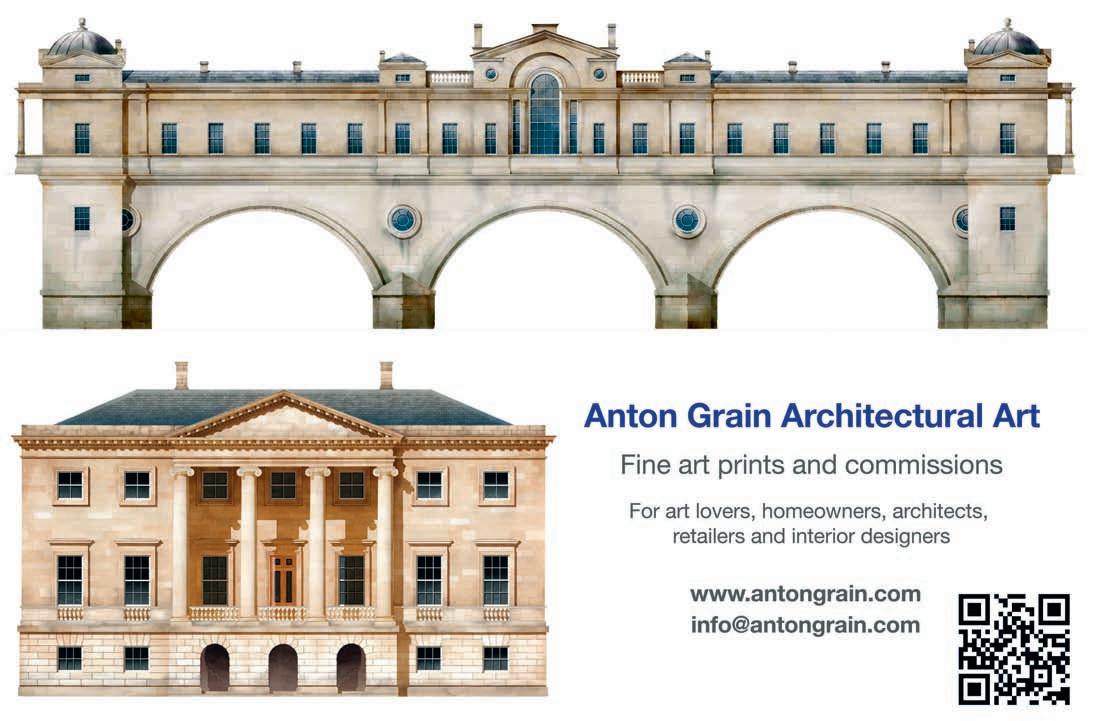
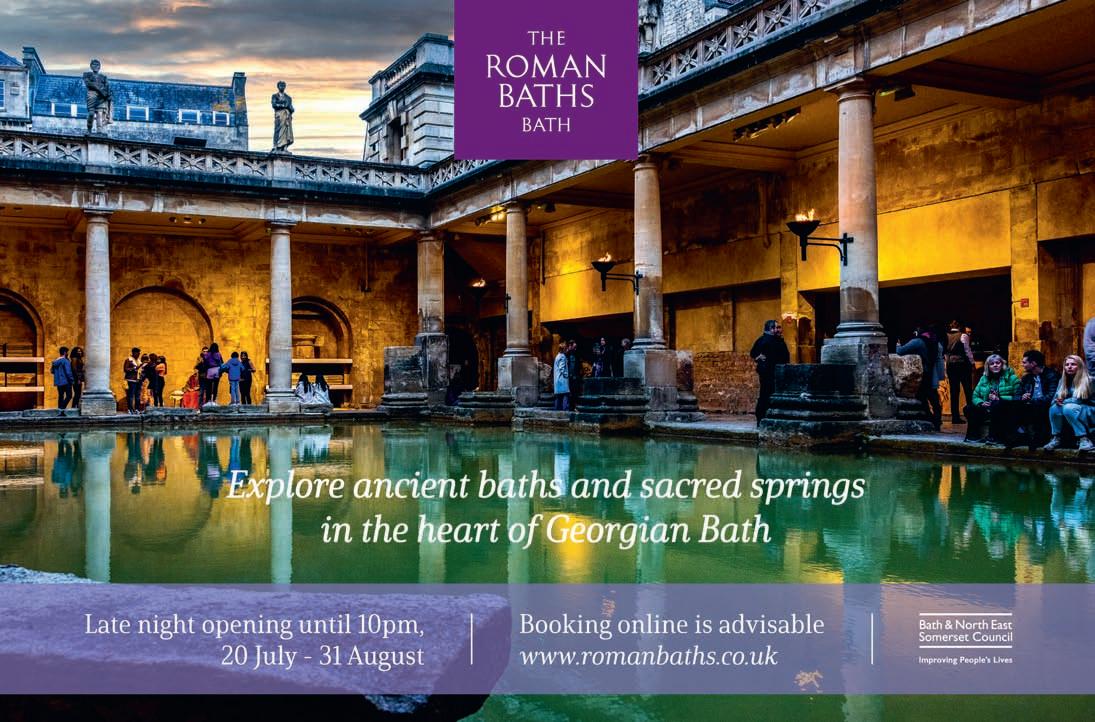
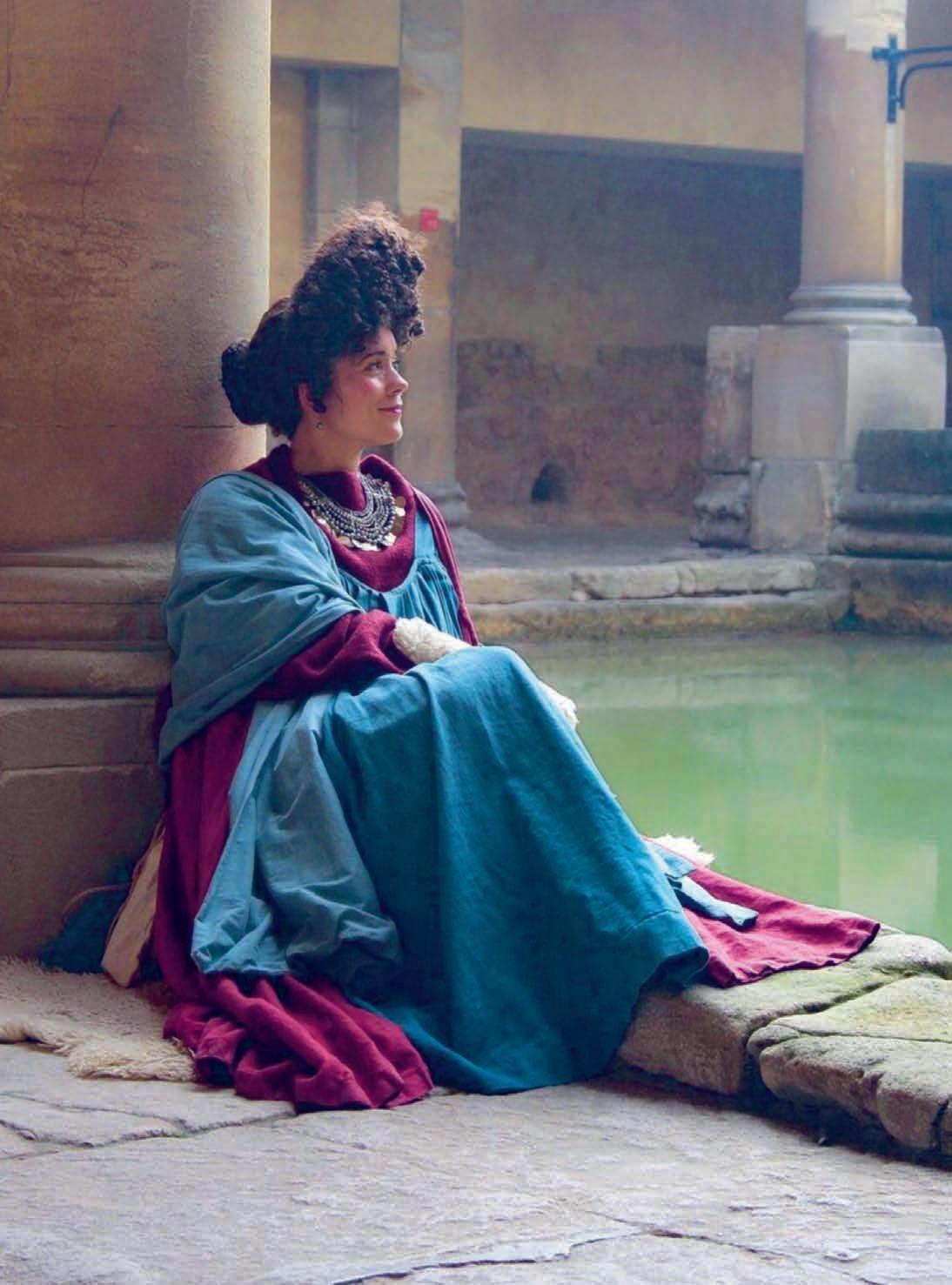
Flavia is a Roman lady, born around 30 AD. Her husband Gaius Tiberinus commissioned the building of the Roman Baths in Aquae Sulis –Flavia loves to spend time there, and she has a large collection of sandals
Can you tell us why you and your husband made your home in Aquae Sulis (Bath)?
Well it’s so much cleaner here than smelly old Londinium, and of course you have the wonderful baths here! My husband Gaius Tiberinus actually commissioned them, you know, so in a way, you have me to thank. They truly are a marvel of this colonial backwater you call Britannia –the only self-heated baths this side of the Empire! The waters have their healing properties from the blessed power of the Goddess, so Aquae Sulis really is the place to be in Roman Britannia.
Why did your husband fund the building of the Baths?
Well Gaius has always had a nose for the next big thing, and when he heard about this healing spring near the Mendip Hills, he had this instinct it would be the perfect place to establish a bath house. You know, before we came along, it was little more than a muddy old puddle! The local Celts really had no idea how to harness the power of this spring, but we Romans are very good with water –you may have heard of our aqueducts? We’re jolly clever!
As for Gaius’ role, well… to me, he’s the man who funds my caliga [sandal] addiction. He’s a government official, a procurator, so he’s in charge of the local money pots. Honestly, I’m not that interested, so long as he keeps the denarii rolling in.
Where do you like to spend time in the Baths?
The Great Bath itself. I love to submerge myself in the warm waters –being careful to keep my wonderful hair dry, of course –and relax with a cup of wine and some oysters. It’s where I catch up on the latest Aquae Sulis gossip with my lady friends. Though don’t believe anything Octavia Sabina tells you –she has a silver tongue!
Have you ever commissioned a curse tablet?
Of course! I mean, who hasn’t? It’s an unfortunate right of passage here. I had a glorious winter cloak that was taken from the apodytereum at the beginning of last spring. I was livid!
Do you think life has improved in Aquae Sulis over the centuries?
Well in many ways, it’s much the same as it was in my day with so many different languages spoken and people from across the globe making pilgrimage to the Baths. I’m not that fond of your carriages, though –far too noisy and smelly. Horses at least have a certain majesty, but these metal boxes are quite hideous.
Do you ever mix with the Iron Age Britons?
Only when I have to. As the wife of an important politician, I have to help grease the wheels of our alliance with the Dobunni tribe. It makes life easier, even if they do have a bit of a pong. They bathe in the cold waters of the River Abona with this strange animal fat and ash mix… It looks revolting and can’t get them clean! Olive oil and a good sweat in the caldarium or nothing, that’s what I say!
Have you ever met a Roman Emperor?
Yes, Vespasian. Though, he wasn’t an emperor when I met him. He was just Titus Flavius Vespasianus, the legate of the second legion, Augusta. He’s actually a lot shorter in person than you’d think.
How do you and your family manage your energy consumption?
Darling, underfloor heating is the only way to go! It gets terribly cold here in Britannia during the winter months, and nothing can beat having warm feet. It really is worth it, even though the child slaves moan about getting into the crawl space to stoke the fires.
What do you think of the people who come to the Baths, but don’t get in the waters?
Well, they’re just missing out, aren’t they? It’s the ones who ask if they can drink the water that I find particularly odd. Why would you want to drink bath water? I suppose it takes all sorts. I just wish they wouldn’t bother me with their disgusting habits.
What were the roads in Aquae Sulis like in your day?
I cannot stand your wiggly roads. If you want to get somewhere, use a straight line from point A to B. That’s how we do it with our roads. I love a straight Roman road. And get rid of all these metal carriages! If you need something to transport you, just hire a couple of servants to carry you around in a litter. There’s nothing like having two strapping men heaving you about on a big pile of cushions –far fewer emissions and much easier on the eye!
Would social media have been beneficial for the Romans?
Oh, it would have made life a lot easier! I like to keep up with the latest trends and fashions of Rome, but it can take up to six months for news of what the Empress is currently wearing to reach me here in Aquae Sulis. It would be a different st ory if we had Instagramus at our disposal. With an Empire as big as ours, it’s so important to keep news and information flowing. You modern folk are lucky!
romanbaths.co.uk
Like many cities, Bath has no shortage of places to get a coffee and cake. Sure, there are national chains but let’s highlight some independent, local, favourite places for a good ol’ cup of Joe and a delicious bite to eat
Are you a fan of a flat white? Or are you more of a caramel macchiato kind of person? Maybe you’re always in search of your morning espresso, or a mocha as your daily indulgence. Either way, everyone has their preferred brew and the Bath coffee scene is booming. With no signs of slowing down, an estimated 98 million cups of coffee a day are being consumed annually in the UK according to the British Coffee As sociation and a turnover of over £5 billion is predicted for 2024 by the World Coffee Portal.
Whether it’s an early morning take-out, a mid-morning refreshment, or even an afternoon pick-me up, enjoying quality coffee has become an essential part of most people’s day, and Bathonians are no exception. Bath’s baristas serve up an estimated £17 million worth of espressos, lattes, cappuccinos and flat whites e very year. But how do you choose where to go for your cup of good ol’ Joe?
We’ve rounded up some of the city’s best cafés and delis to discover plenty of great coffee blends, fine pastries, yummy cakes and savoury snacks.
3 Liliput Court, Bath BA1 1ND Web: courtyardbath.co.uk

15–16 and 17 Pulteney Bridge, Bath BA2 4AY
Poppy’s Bakery is a beautiful little coffee shop and bakery situated directly on Pulteney Bridge, just a minutes’ walk from both Waitrose and The Guildhall. Delicious pastries are cooked on-site everyday, why not enjoy one with a freshly ground espresso and a beautiful view over the weir, what more could you want! Watch the pleasure boats come and go in the summer months or do some people watching across the street whilst taking in the best of Bath’s Georgian architecture. Takeaways are also popular; they offer a meal deal which is ideal for a picnic down by the river. Cream teas are an afternoon staple here with varying homemade scone options, look out for the blueberry scones especially, alongside other favourites including carrot cake, triple chocolate brownie and lemon drizzle – made by the on-site bakery team. Opening hours: 9am-5.30pm Monday–Friday. 9am-6pm Saturday and 9.30am-5.30pm Sunday.
Just around the corner from the bustle of Bath Abbey, this colourful independent café has been serving up delicious food for over 30 years. Head down the steps at North Parade Passage to discover the quirky surroundings of Lilliput Court and soak in the Georgian architecture views. Go for fluffy pancake stacks or Havana toast - think spiced pulled pork, ham, cheese and chipotle mayo, topped with a fried egg - boozy cream teas, rarebit crumpets, all day Full English/veggie, homemade lunch specials and Kirsty’s moreish cakes. There’s a cosy inside space and plenty of cover outside too, with heaters and blankets for chillier days, ensuring a delightful stop off year-round.

1–2 Bartlett Street, Bath BA1 2QZ
Web: cafelucca.co.uk
Café Lucca revives and relaxes in equal measure. It serves wonderful food in a welcoming environment, offering freshly ground coffee and a light breakfast in the mornings, lunch from a selection of brightly coloured salads and bruschettas and panini, or for afternoon tea an array of tempting cakes. This is the perfect place for catching up with friends, or as a respite from shopping, and is one of Bath’s favourite places to see people and be seen. Deliciously fresh, modern Italianstyle/Mediterranean food is served in the elegant and spacious surroundings of The Loft. All the fresh produce and Italian products are from small local family suppliers. Based in a traffic-free street in Bath’s boutique quarter, the restaurant is just two minutes’ walk from Milsom Street and The Assembly Rooms, and when the sun shines there are tables outside from where one can watch the world go by.
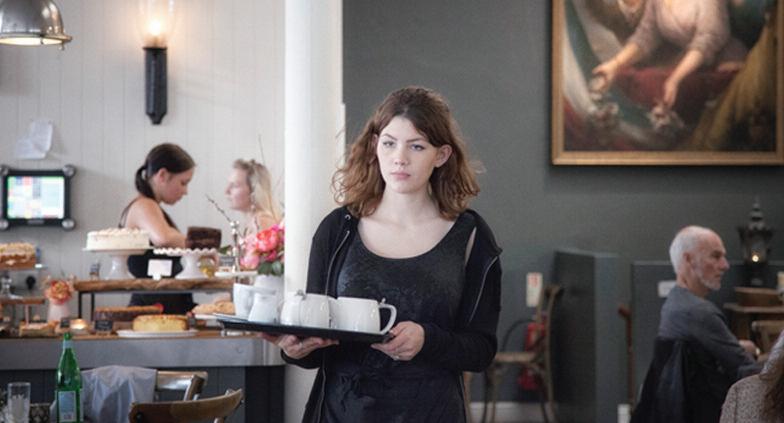
2 Quiet Street, Bath BA1 2JS
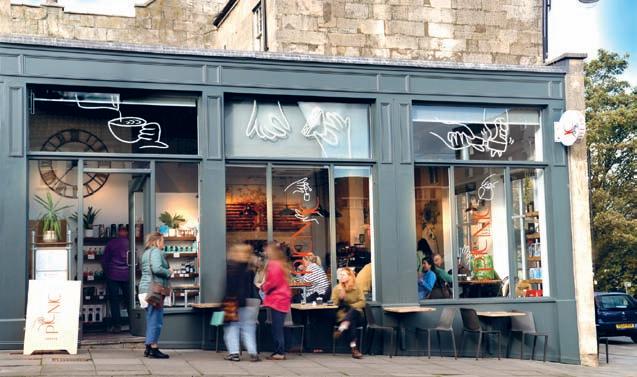
9 Saracen Street, Bath BA1 5BR Web: picniccoffee.co.uk
Just a few moments walk from the main shopping street, Picnic is a laid-back coffee shop occupying a wonderfully sunny corner location, with floor to ceiling windows. A great place to people watch and see the world go by. The staff here are warm and attentive and their welcoming smiles and friendly chat keep locals and visitors coming back. Picnic is decorated in a contemporary style, with plenty of comfortable seating both inside and out, and bookshelves containing travel guides and holiday reads, ready to transport you to just about anywhere in the world. Their speciality coffee beans are sourced from Plot Roasting in London, with additional guest roasters featuring each month. A selection of freshly roasted beans and other coffee brewing kit is also stocked for retail. Snacks are not forgotten with a selection of gluten-free and also vegan cakes, as well as made-to-order toasties. For tea drinkers there’s a good range of ethically sourced Good & Proper loose-leaf teas on offer.
5 Princes Buildings, George Street, Bath BA1 2ED Web: adventurecafebar.co.uk

A mouthwatering cake display greets you here at Quiet Street with a fabulous choice of classic bakes - the cheesecakes are a particular favourite. There’s a great variety of coffees, with all of the options available in freshly ground decaf as well. A popular spot for takeaway coffee, there is also plenty of seating on the ground floor, as well as down a spiral staircase into a colourful and cosy lounge. Serving a simple breakfast, lunch and tea and cake menu, the café can get busy so get there early. A delightful pitstop on the way into town, this pretty little café is situated between Milsom Street and Queen Square. Opening hours: 8.30am -5.30pm Monday–Friday. 9am-6pm Saturday, and 9.30am-5.30pm Sunday.
SOCIETY CAFÉ
4–5 Kingsmead Square, Bath BA1 2AB and The Corridor, 19 High Street, Bath BA1 5AJ Web: society-cafe.com
MOKOKO
6 Abbey Churchyard, Bath BA1 1LY and Web: mokokocoffee.com
CAFE AU LAIT
12–14 Dorchester Street, Bath BA1 1SS
The Holburne Museum, Great Pulteney Street, Bath, BA2 4DB Web: holburne.org
Dara Foley ventures off the well-worn tourist routes to discover Bath’s many specialist museums
Bath has a wonderful, eclectic mix of independent specialist museums that will educate and stimulate the senses even more. Intelligent, intriguing and charming, they are certainly worth a visit; here are some little treasures that will make your experience of our city so much richer.
At one end of the magnificent sweeping curve of the Royal Crescent, surely Bath’s most photographed street, can be found a museum which gives us the chance to see what the home life of a fashionable Georgian household was like. No. 1 Royal Crescent, run by Bath Preservation Trust, has been painstakingly furnished and decorated just as it might have been during the period 1776–1796. Visitors can take a room-by-room journey around 18th-century life, from the lady’s bedroom and the parlour to the gentleman’s retreat. In addition to the fine furniture, glassware, china and silver, and the collections, which reflect the interests of the era in science and the natural world, there’s a recreation of a working kitchen in the basement, filled with archaic and fascinating cooking paraphernalia. Children can have a turn trying on costumes from the period and there is often a be-wigged doorman in full Georgian costume to welcome visitors outside the grand front door.
Open Tuesday to Sunday No. 1 Royal Crescent, Bath BA1 2LR Tel: 01225 428126 Web: no1royalcrescent.org.uk
This attraction, set in a Grade II listed property, blurs the lines between museum and immersive visitor experience, extending over four atmospheric floors including the dank foreboding basement experience. Step into the world of Mary Shelley with a floor dedicated to uncovering her history and tragic life events, and confront the formidable 8ft monster recreated exactly as Mary imagined. Bursting with unusual artefacts and vintage items, interactive multi-sensory environments and assorted body parts, Mary Shelley’s House of Frankenstein delivers an unnervingly visceral, illuminating and entertaining experience.
Open daily
37 Gay Street, Bath BA1 2NT
Tel: 01225 551542 Web: houseoffrankenstein.com
BATH ROYAL LITERARY AND SCIENTIFIC INSTITUTION
For those who fear the world is dumbing down, BRLSI (pronounced Brillsy) is an oasis of cultural refreshment. Located
on Queen Square, it’s a prominent address but an unassuming institution, perhaps explained by the fact that it’s a charitable organisation run by volunteers. So there’s no flashy shop selling t-shirts and pencils, but there is a running programme of free exhibitions centred on promoting science, literature and art. The museum is fortunate in being able to call on its tens of thousands of objects in its collections to collate fascinating displays. Throughout the year there are knowledgeable lectures and talks from world-class experts on topics as diverse as fake news, Buddhism, nanoscience and climate change. Check out some of the collections in its online gallery.
Open Monday to Saturday 16–18 Queen Square, Bath BA1 2HN Tel: 01225 312084 Web: brlsi.org
HERSCHEL MUSEUM OF ASTRONOMY
In a quiet side street off Bath city centre lies a modest Georgian terraced house where astronomer William Herschel made history over 200 years ago. With his telescope in the garden of the home in New King Street that he shared with his equally gifted sister Caroline, Herschel discovered Uranus, a hitherto unknown planet. That discovery in 1871 was to influence future generations of space scientists. The late astronomer Sir Patrick Moore said that Herschel should be commemorated as the man who gave us our first understanding of an accurate shape of our star system, or galaxy. The small museum has some rooms furnished as they would have been in the 18th century, and its artefacts tell of a life filled with music-making and scientific exploration. Also, watch a short film about the Herschels and visit the 18th-century garden, where plants used in cooking and medicine were cultivated.
Open Tuesday to Sunday 19 New King Street, Bath BA1 2BL Tel: 01225 446865 Web: herschelmuseum.org.uk
More of an immersive curiosity than a museum, the Jane Austen Centre celebrates the author’s life and works with a permanent exhibition that explores her time in Bath and the influence that the city had on her books and the characters she created. Set in a classic Georgian townhouse that’s decorated in classic regency-era style, and fit with the fashion and food to match, the museum offers a time-capsule glimpse into Austen’s personal life. Visitors will also meet many of the costumed guides that gallivant the corridors, such as the brilliant Martin Salter –AKA Mr Bennet, who remain in-character and make the experience enchanting and memorable. There’s also a chance to dress up in Regency clothing,
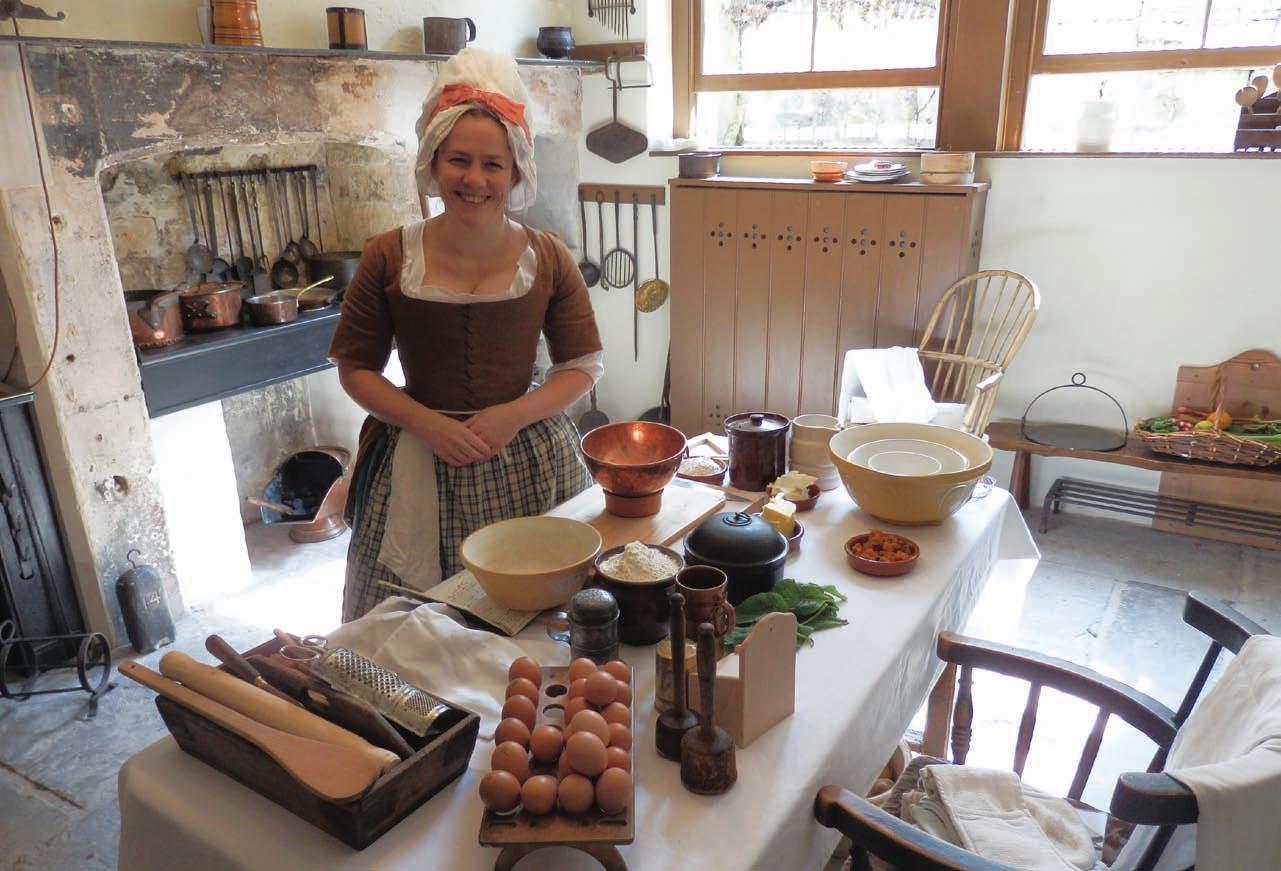
THE

 MUSEUM OF EAST ASIAN ART MING DYNASTY JADE PANEL
MUSEUM OF EAST ASIAN ART MING DYNASTY JADE PANEL

and sample biscuits, scents of the era and even try a little writing with a quill and ink. After all that, take tea and possibly cake, with Mr Darcy in the centre’s Regency Tea Rooms.
Open daily 40 Gay Street, Bath BA1 2NT Tel: 01225 443000 Web: janeausten.co.uk
THE MUSEUM OF EAST ASIAN ART
Bath is home to the only UK museum dedicated to the art and culture of East and South East Asia. It has a collection of exquisitely beautiful items, including ceramics, carvings, netsuke and jade, many of them thousands of years old. It is a place to quietly focus on the details of form and colour and to marvel at the craftsmanship imbued in these pieces. The museum has an excellent shop – great for gift buying – and regularly runs family friendly events and craft sessions.
Open Wednesday to Saturday 12 Bennett Street, Bath BA1 2QJ Tel: 01225 464640 Web: meaa.org.uk
THE MUSEUM OF BATH AT WORK
Bath was once a thriving hub of industry, making goods that were shipped around the world. This unusual museum is dedicated to the centuries of Bath’s working heritage. Highlights of the collection include a recreation of a 19th-century soft drinks bottling plant, J.B. Bowler, which once operated in the city, and a Horstmann car from 1914, one of the earliest motor vehicles, also made in Bath. The museum is a great place for Bathonians to learn more about their heritage, and for visitors to look at how our ancestors used to make things. For many it will also offer the experience when history collides with our own memories of past technology.
Open daily Julian Road, Bath BA1 2RH Tel: 01225 318348 Web: bath-at-work.org.uk
THE MUSEUM OF BATH ARCHITECTURE
This fascinating museum is housed in the splendidly Gothic Countess of Huntingdon’s Chapel. Its collections include old prints showing Bath as it used to look in a pre-industrial age, along with a scale model of the city showing its famous sites. There’s also the chance to examine the tools and methods used by

artisans in the construction of the Georgian city, alongside the dr awing tools used by architect John Wood the Elder.
The Countess of Huntingdon’s Chapel,
The Paragon, Vineyards, Bath BA1 5NA
Tel: 01225 333895 Web: museumofbatharchitecture.org.uk
OLD THEATRE ROYAL AND MASONIC MUSEUM
It’s easy to miss this ordinary looking building, yet behind the modest front door lies a fascinating history dating back to 1750. This museum reveals the story of the first purpose-built theatre in Bath. Originally named the St James Theatre, it soon became the first Theatre Royal outside London with star performers such as William Dimond and Sarah Siddons attracting sell-out audiences. As the population of Bath grew towards the end of the 1700s, its limitations were obvious and a new location for the theatre was found in Beaufort Square, the site now occupied by the Theatre Royal Bath. The Theatre Royal and Masonic Hall are open to the public on selected days with guided tours available to give you an insight into the history of the theatre, the building and freemasonry in general.
Opening times vary, check website for details 12 Orchard Street, Bath BA1 1JU Tel: 01225 462233 Web: oldtheatreroyal.com
The city of Bath is one of only two entire cities inscr ibed by UNESCO as World Heritage Sites, the other being Venice. Bath World Heritage Centre celebrates the city’s unique cultural offering and gives an insight into what makes the city so special. Find out more about the city’s attributes of Outstanding Universal Value the hot springs, Roman remains, Georgian architecture, Georgian town planning, the social setting of the Georgian spa town and the city’s natural landscape setting. You can explore interactive exhibits and displays designed to inspire, excite and inform. Discover free walking trails and guides and a specially designed mobile app to help you explore everything Bath has to offer.
Opening daily
10 York Street, Bath BA1 1NH Tel: 01225 477785 Web: bathworldheritage.org.uk


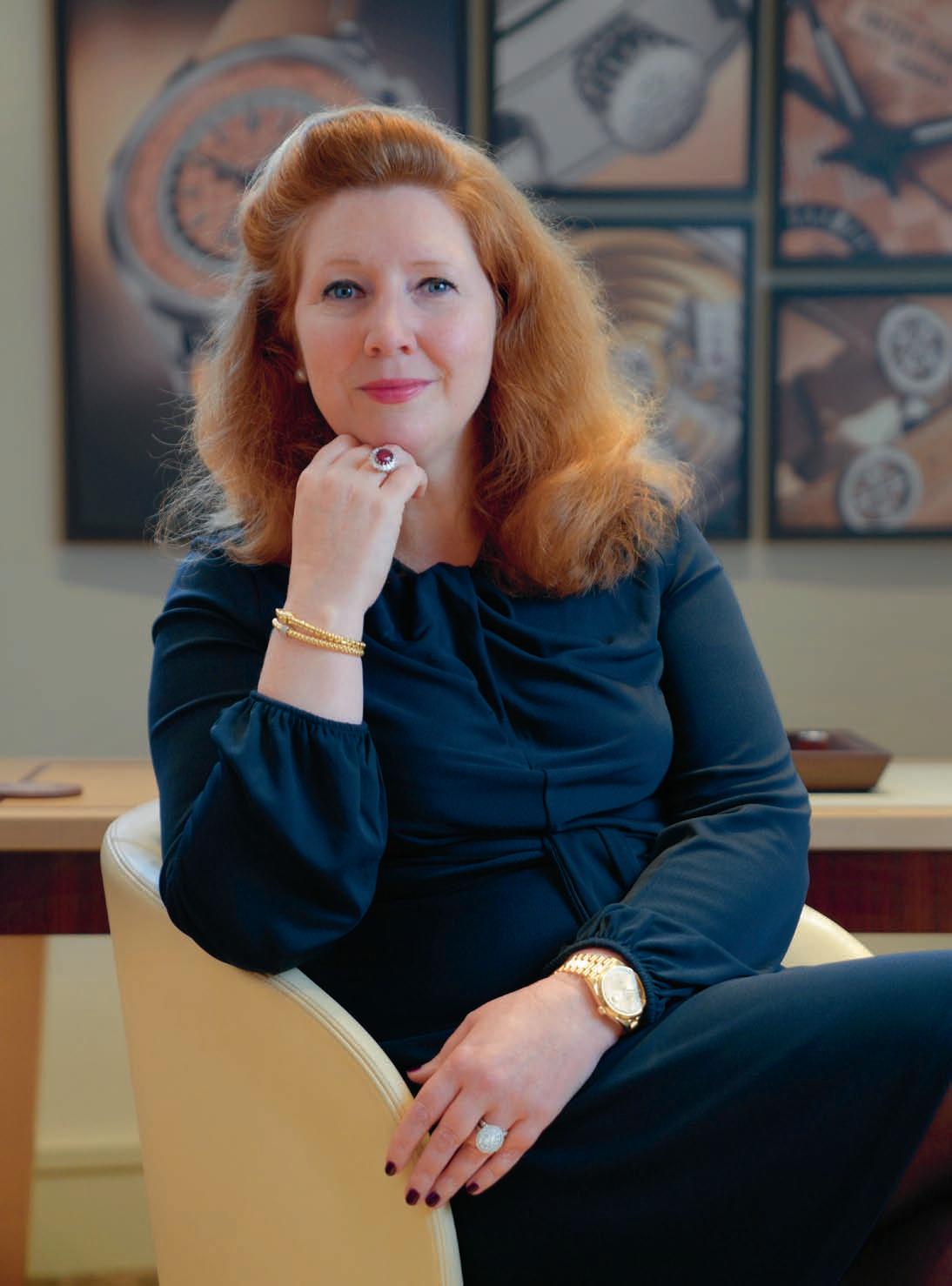
Let us introduce you to Mallory, the oldest jewellers in Bath who are celebrating their 125th anniversary. The great-great-grandaughter of the original owner, Katie Vander Woerd gives us some insights into the business...
Mallory’s history began in Bath in 1898 when Edward Palmer Mallory, Katie Vander Woerd’s great-greatgrandfather, took over Routley the jewellers. “According to the 1891 Census, Edward Palmer Mallory began his career working as a ‘Jewellers Assistant’ in Cheltenham. He later moved to Bath gaining employment at Routley the jewellers at No. 1 Bridge Street and in the summer of 1898 he bought the business which became E.P. Mallory & Son. In the ensuing years and helped by his wife Mrs M.T. Mallory, the couple grew the business until it became a central part of commerce in the city, with people travelling from miles to buy jewellery.”


Ladies used to come to Bath to take the waters in the early years of the shop and came in to buy silver tea sets. “During the late 19th century the pause for afternoon tea became a fashionable social event. For high society, the afternoon tea table was one of great opulence and refinement. Tea drinking for the upper class came with a whole host of accessories – fine porcelain teacups and saucers, decorative silver teapots, mahogany tea caddies, silver tea urns, exquisite table linens and personalised tea blends.
At that time silverware was highly valued for its craftsmanship, intricate designs, and the intrinsic beauty of silver and was desired by the gentry. E.P. Mallory & Son would hand-deliver fine silverware to many of the great and the good of Bath, as well as serving those who visited the Bridge Street showroom.”
Over the past 125 years the business has embraced world wars and recessions, changing fashions, seasons and trends – all of which led the business to change and evolve. ”One of the most significant changes in 2005 saw the opening of our now dedicated watch department. My father, Robert Vander Woerd, had the foresight to predict the growth of the watch industry and to expand this area of our business, making us the first jeweller outside London to bring a multi-brand offering to a retail business, representing some of the finest luxury watch houses in the world. Our unique offering of fine jewellery, high end timepieces and luxury accessories made us a true shopping destination.”
Katie Vander Woerd came into the business ten years ago. “I was happy and proud to join the company and to be part of this fastpaced and fascinating industry. It’s often about carving a niche for yourself, harnessing the skills and talents you have and deciding how they can bring value. As the fifth generation, I feel immensely privileged to be able to continue to build on the heritage, brand and family values that have been created.”
Mallory is one of the most prominent jewellers in the country. “We are one of the largest independent familyowned and run jewellers in the UK today – there are not many left like us! We employ around 40 staff and the Mallory premises spans six Georgian buildings – so a lot happens behind the scenes! At the top of the house, we have dedicated state-of-the-art workshops where you will find our our accredited watchmakers and technician who service and maintain timepieces, as well as two talented goldsmiths who produce our beautiful Mallory creations, and repair and restore fine jewellery.”
We have a team of people who have been in the trade for a long time and have acquired a wealth of knowledge over the years. An important part of the watch and jewellery world is to pass on knowledge and expertise in the different specialisms, whether that’s antique jewellery, watches, gemmology, valuations, jewellery manufacturing or watch-servicing.”
Is there a secret to the success of the business? “We are a personal business, and we believe in offering a unique and personal experience. We never compromise on our standards or values. As a family company we are in control of our own destiny. Bath is a special place, and we feel fortunate that Edward Palmer Mallory chose to reside here. Our customers come from all over the world, but our home is here in Bath – we have a deep sense of our heritage in this wonderful city.
Clients come to us to buy something special. We are here to impart our knowledge and guide... and hopefully make dreams come true!”
Mallory, 1-5 Bridge Street, Bath BA2 4AP; 01225 788800; Web: mallory-jewellers.com
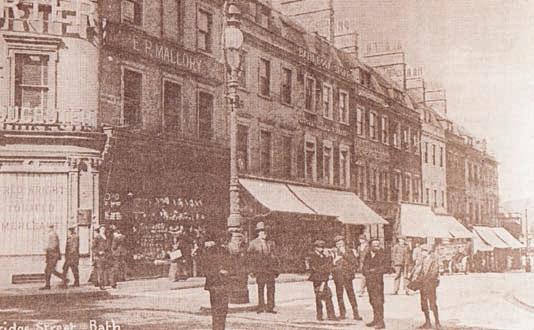
From Sense and Sensibility to Bridgerton and The Pursuit of Love to Sherlock, Bath’s heritage and picturesque locations continue to make a big mark on TV and film screens. Melissa Blease rolls the credits
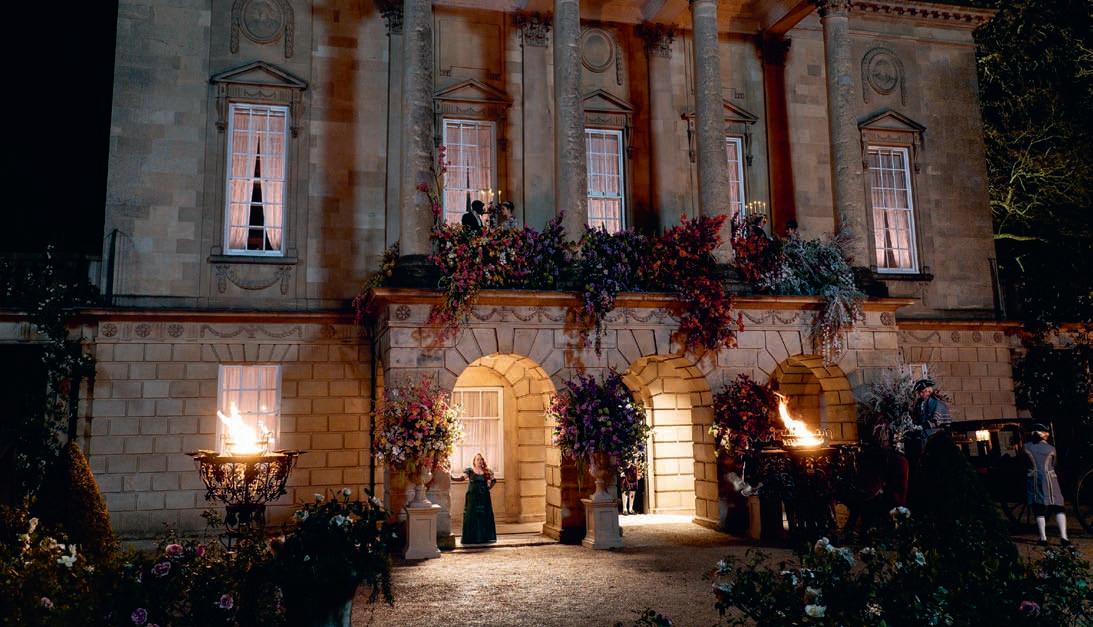
“The dash of carriages, the heavy rumble of carts and drays, the bawling of newspapermen, muffin-men and milkmen, and the ceaseless clink of pattens...” That’s how Jane Austen described Lady Russell’s experience of driving through Bath in her 1817 novel Persuasion. Over two centuries on, the carts, drays, muffinmen and pattens are long gone – or are they?
At least three adaptations of Persuasion have been filmed in Bath, most recently the thoroughly modern and controversial 2022 Netflix version starring Dakota Johnson. The BBC’s 1995 version proved to be more favo urable with critics, but the supreme winner was the BBC’s six-part adaptation of Pride and Prejudice, which came out in the same year and starred Colin Firth as Fitzwilliam Darcy... most memorably, perhaps in that wet shirt scene, although this was not filmed in Bath. The BBC/A&E Network 1987 adaptation of Northanger Abbey was, though –and the Sky Arts/Giles Coren 2017 documentary I Hate Jane Austen
Key Austen-related film and TV backdrops include the Royal Crescent, Sydney Place, Abbey Churchyard, Abbey Green, The Pump Room, Old Bond Street, The Assembly Rooms, Bath Street, North Parade Buildings and Gravel Walk.
Director Mira Nair’s 2004 adaptation of William Makepeace Thackeray’s 1848 novel Vanity Fair (starring Reese Witherspoon alongside a host of iconic stage/screen superstars) gave us bountiful, big screen Bath in abundance. Four years later, Saul Dibb’s 2008 historical drama The Duchess worked similar Bath blockbuster magic as Keira Knightley, Ralph Fiennes, Charlotte Rampling and Dominic Cooper starred as groovy Georgians trotting their well-heeled stuff in various locations across the city, most notably The Assembly Rooms and The Holburne Museum, at the apex of gracious Great Pulteney Street. Talking of which... Are you familiar with Bridgerton’s Lady Danbury's exquisite home in an upper-class corner of 19th-century London? Well, that’s The Holburne too! Since 2020, the very word Bridgerton (the huge Netflix historical fiction/romance smash hit) has become
synonymous with Bath: all the exterior shots of the Featherington family’s fabulous house were filmed on the Royal Crescent, while Gunter's Tea Shop, Lady Dee’s Hat Emporium, the Modiste Dress Shop, the Horse and Hop Pub, the market’ and Siena Rosso's humble abode were all variously shot around Abbey Square, Abbey Green and Beauford Square.
Bath reprised its role in the Bridgerton franchise in the 2023 prequel series Queen Charlotte: A Bridgerton Story, and season 3 hits our screens this summer, profiling wallflower (and secret scandal sheet writer) Penelope Featherington (Nicola Coughlan) and her longtime crush, world traveller Colin Bridgerton (Luke Newton).
Tom Hooper’s epic, multi award-winning 2012 musical film version of Victor Hugo’s 1862 novel Les Miserables beautifully recreated the sights and sounds of 19th-century Paris... in Bath. Remember the dramatic moment when Javert/Russell Crowe throws himself off the Pont au Change into the River Seine? It was neither the Pont au Change nor the River Seine; the scene was filmed on Pulteney Bridge and Bath Weir.
Less dramatic, perhaps, but equally moving, the title character in Hettie Macdonald’s 2023 film adaptation of Rachel Joyce’s whimsical, poignant 2012 novel The Unremarkable Pilgrimage of Harold Fry (starring Jim Broadbent) passes through Bath city centre during his epic walking journey from South Devon to Berwick-upon-Tweed.
On a rainy autumn day in October 2021, Parade Gardens, Pulteney Bridge and Pulteney Weir were transformed into a magical snowy backdrop for key scenes in Paul King’s Wonka starring Timothée Chalamet. The film’s narrative acts as a prequel to both Roald Dahl’s 1964 novel Charlie and the Chocolate Factory and its original 1971 film adaptation premiered in December 2023. In 2009, Bath’s Little Theatre Cinema (St Michael’s Place) was immortalised in another magical Roald Dahl spectacular: Wes Anderson’s stop-motion classic, Fantastic Mr. Fox
It would probably be easier to list the few remaining corners of Bath that haven’t been used as a backdrop across four seasons of quirky ITV detective drama McDonald and Dodds. And, being on contemporary drama territory, locations from the grand (Queen Square; the Royal Crescent; Royal Victoria Park) to the functional (the city council meeting rooms at The Guildhall; the council-leased allotments; Bath Leisure Centre) by way of various popular Bath watering holes including The Bell Inn (Walcot Street) are all clearly recognisable.
You might not think that McDonald’s in SouthGate is a prime location, but the fast food giant filmed its spectacular 2017 Christmas advert complete with snowflakes and Christmas trees here.
Elsewhere, key scenes in Emily Mortimer’s wild’n’witty adaptation of Nancy Mitford’s 1945 novel The Pursuit of Love (BBC, 2021) were filmed around No 1 Royal Crescent and Green Park Station; the Assembly Rooms took centre stage as the grand Brussels ball scene in ITV’s 2020 historical drama Belgravia; the
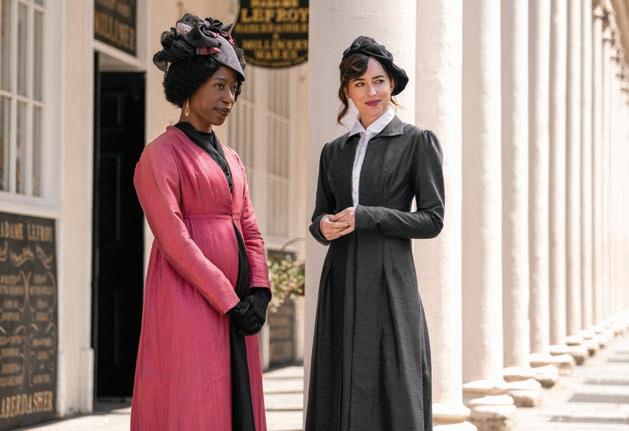
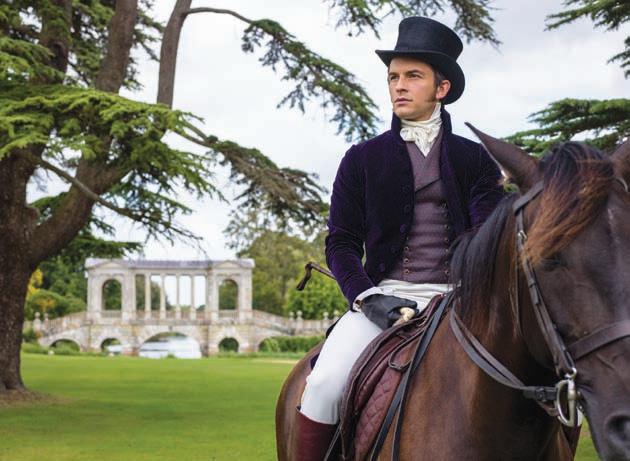
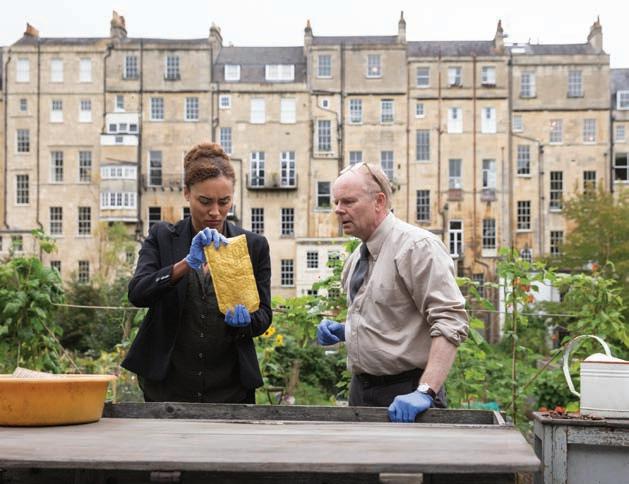 JoNAThAN BAILey IN The SeCoNd SerIeS of BRIDGERTON, fILMed IN prIor pArk GArdeNS
TALA GouVeIA ANd JASoN WATkINS IN MCdoNALd ANd doddS, SerIeS 1, IN The CouNCIL ALLoTMeNTS. VICTorIA pArk
JoNAThAN BAILey IN The SeCoNd SerIeS of BRIDGERTON, fILMed IN prIor pArk GArdeNS
TALA GouVeIA ANd JASoN WATkINS IN MCdoNALd ANd doddS, SerIeS 1, IN The CouNCIL ALLoTMeNTS. VICTorIA pArk
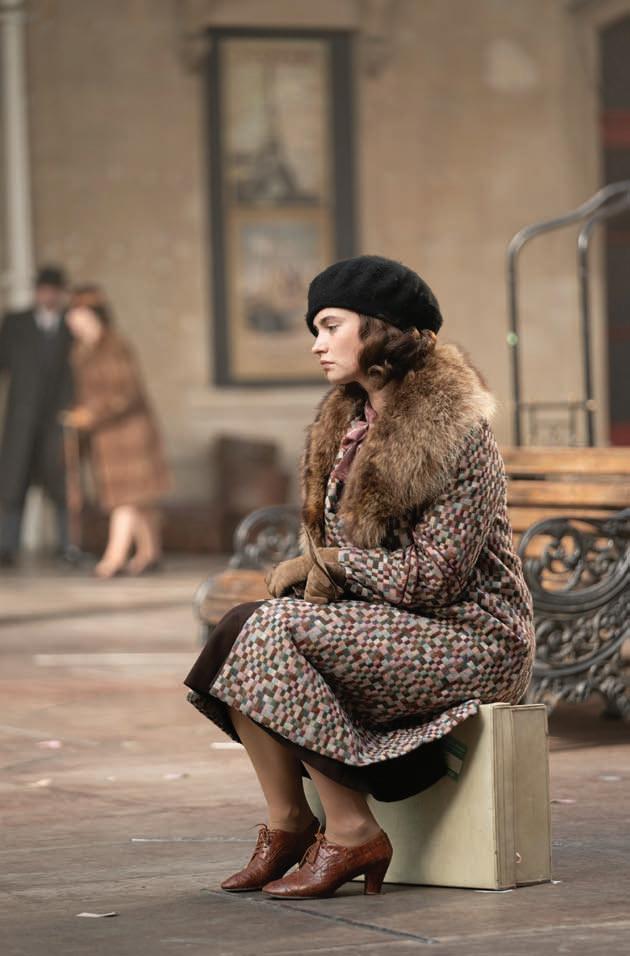
Guildhall doubled-up as London’s Old Bailey court rooms in the BBC’s 2019 series The Trial of Christine Keeler; and Benedict Cumberbatch strutted his Sherlock stuff on the ancient cobbles of Queen Street when it was transformed into a Victorian-era street market for the BBC’s 2015 Sherlock Christmas Special.
At the time of writing, Stardom Films brand new romcom movie One Night in Bath is being filmed in various locations around the city.
Several scenes in Steven Spielberg’s 2011 powerful World War I epic film War Horse were filmed in the village of Castle Combe (9 miles/14km north east of Bath). You might also recognise the ancient, picturesque bridge from its close-up as a backdrop in the original film version of Dr Doolittle (1967), while pivotal scenes in Matthew Vaughan’s 2017 adventure film Stardust were filmed here.
Meanwhile, the village of Lacock (15 miles/24km east of Bath) is as picture-perfect as ancient, quintessentially English villages get and film production companies agree. Lacock Abbey was turned into Wolf Hall in the BBC’s adaptations of Hilary Mantel’s book and the sequel Bring Up the Bodies, while Great Chalfield Manor and Garden (down the road from the Abbey) starred as Austen Friars, home of Thomas Cromwell.
Lacock Abbey also doubled-up as the interior of Hogwarts in Harry Potter and the Philosopher’s Stone (2001) and Harry Potter and the Chamber of Secrets (2002). Both the Abbey and the village featured in Fantastic Beasts: Crimes of Grindelwald (2017); His Dark Materials (BBC, 2019); Cranford (BBC 2007–10); Pride and Prejudice (BBC, 1995) and Justin Chadwick’s 2008 historical drama The Other Boleyn Girl. Dyrham Park (9 miles/14km north of Bath) is no stranger to period dramas either; this imposing National Trust property has enjoyed various big-screen roles including close-ups in James Ivory’s elegant 1993 tear-jerker The Remains of the Day (1933), John Alexander’s Sense and Sensibility (2008) and ITV’s 2019 historical drama Sanditon.
The Dyrham Park mansion was also spotted as the exterior of Warleggan House in Poldark (BBC, 2015–2019)... and there was more Poldark at Bath’s Prior Park College for a ballroom scene, in Corsham (8 miles/13km south west of Bath) and Wells (around 22 miles/35km north-east of Bath), most notably Wells Town Hall, which had a starring role as Warleggan Bank.
TIMOTHÉE CHALAMET STARRING IN PAUL KING’S WONKA, RELEASED DECEMBER 2023 - FILMED IN BATH IN 2021





Looking for a little souvenir? Here’s a few ideas to take your fancy
Available from: The Fine Cheese Co., 29 & 31 Walcot Street, Bath BA1 5BN Web: finecheese.co.uk
Made at Park Farm in Kelston, this is a mild and creamy, organic, brie-style cheese made to an original 19th-century recipe. The flavour is mushroomy and creamy with a hint of lemons. It comes wrapped in parchment paper with a red wax seal. Bath Soft dates back to the time of Admiral Lord Nelson who in 1801 was sent some by his father. It was recorded that Nelson’s sweetheart was ‘gratified’ by the flavour of this cheese! £10.68 (250g)

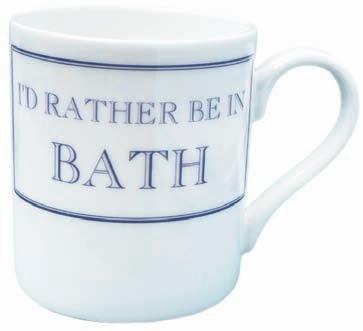
25 Union Passage, Bath BA1 1RD Web: silvershopofbath.co.uk
As well as a huge range of delightful silver jewellery and gift ideas, we found this popular ‘I'd rather be in Bath’ Bone China mug. Priced at £10.95 it’s a quick and easy take home that will not only remind you of your time in Bath, but gently call you back to visit again.
Jody Cory Goldsmiths 9 Abbey Churchyard, Bath BA1 1LY Web: jodycory.co.uk

Local girl, Jody Cory has handmade a range of jewellery to celebrate her home town. Made at her Abbey Churchyard store, the Memories of Bath range includes angels climbing the abbey, UK pendants with a small diamond putting Bath on the map, fob pendants and bracelets featuring a map of Bath, and Bath charms. Shown here is the Roman coin range. Jody’s grandfather was an engineer in the city and while working at the Pump Room, he found a few Roman coins. As Jody recalls: “I remember as a child how special they were, and I was interested in the history of our amazing city. I guess I take after him in a small way by continuing to work in metal. Only this time, I use precious metals and work on a smaller scale.” While they can’t make original Roman coin jewellery, the WRL stamp on each piece shows it is a replica from an original coin. Jody was inspired to make a range for locals and visitors to celebrate our wonderful city.

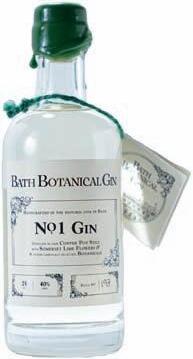
bathbotanics.co.uk
This No.1 Gin is a 40% abv London Dry Gin, with hand-picked fragrant lime flowers and eight carefully selected botanicals. It is distilled, bottled, wax sealed, labelled by hand and batch numbered at the distillery in Prior Park Road, Widcombe, Bath. Priced from £18, it’s available in two sizes, 25cl. and 70cl. Buy direct from bathbotanics.co.uk or at selected retailers around town.
6 Pulteney Bridge, Bath BA2 4AX Web: uptoseven.co.uk
Designed by Up to Seven and handmade in Bath this children's knitted black, blue and white stripe hat makes the perfect gift for any Bath Rugby fan! These adorable, roll edged hats are all knitted in anti-tickle wool, and can be machine washed at 30 degrees.
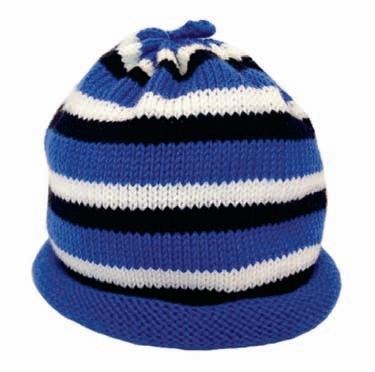
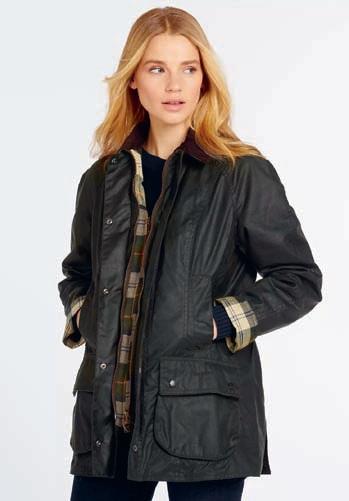
1 Pulteney Bridge, Bath BA2 4AX Web: wadswick.co.uk
Barbour Beadnell Jacket
Based on Barbour’s iconic wax jacket style but cut to a more flattering silhouette, the Barbour Beadnell is the perfect versatile, all-season jacket. Similar designs for men are also available at Wadswick.
Web: antongrain.com
Love art? Love architecture? Then you’ll love Bath-based artist Anton Grain’s finely crafted architectural paintings! A qualified architect, Anton produces beautiful images of classical buildings. Each image is painstakingly drawn, then carefully rendered using a traditional India ink wash technique, onto the highest grade watercolour paper. Offered as limited edition prints or fine art prints in a variety of sizes, each image brings out the unique beauty of these timeless buildings. Let one of Anton Grain’s masterful artworks become your treasured keepsake of this historic Unesco-heritage city.

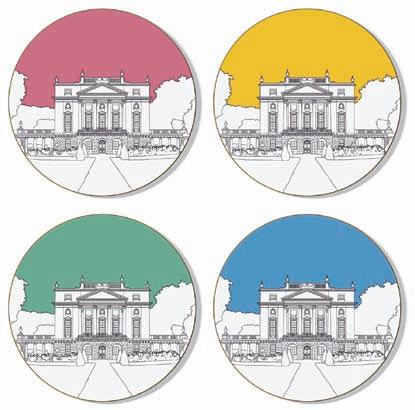
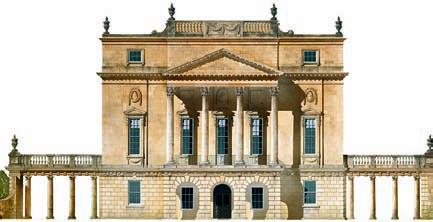

The Holburne Museum Great Pulteney Street, Bath BA2 4DB Web: holburne.org
Exclusive to the Holburne, these beautiful cork-backed coasters have been specially commissioned by top designers People Will Always Need Plates. Perfect for fans of the Museum (aka Lady Danbury’s House) and Bridgerton enthusiasts. £20 for a set of four. There’s also mugs and plates and many more cool gift ideas in the Museum shop.
1 Argyle Street, Bath BA2 4BA Web: bathrugbyshop.com
An absolute must for any visitor to Bath. Take home some blue, black and white with a Bath Rugby replica ball. At the shop you will also find a full range of fantastic gifts and merch including the personalised Bath Rugby shirt option which can be ordered and delivered to you... by airmail if need be.
Bath Abbey, Bath BA1 1LT Web: bathabbey.org
Located on the south side of Bath Abbey, the Bath Abbey Shop offers a wonderful range of products inspired by the stories of the Abbey; from its beginnings as a Benedictine monastery to the coronation of the first King of all England to the present day. Featuring work by many local artists, the shop also has a special focus on Christian women and their small businesses. Alongside the core product lines and an excellent selection of Christian books, there are special souvenirs for different times of the year. Shown here is a Bath Abbey china mug, £14.

Grace & Mabel in George Street brings a sparkle of colour to even the greyest day in Bath –meet Daniela Benson, Shelley Presland and Kirstie Smith, the three sisters who created this innovative clothing store.
One Friday afternoon in 2007 Daniela Benson stumbled across a lovely independent boutique on Regent Street in Clifton, Bristol and discovered that the shop lease was on the market. She approached her sisters Shelley and Kirstie about the idea of taking on the lease and they were immediately excited. The small fashion boutique in Clifton Village established itself quickly, and three years later they opened a shop in Bath. The shops have built a loyal customer following because of their friendly and personal service.
All three sisters have backgrounds in fashion design or retail. Daniela trained in Fashion Design at the London College of Fashion and then set up her own label selling in Hyper Hyper in Kensington. After a career break she went back to study at the University of the West of England, graduating with a first class degree. She then set up her own label and started a handbag business called Hope & Benson. Kirstie went to London at the age of 18 and worked for Whistles for almost 10 years, which taught her everything she knows in retail including window display and merchandising, and later became the manager of Karen Millen in Bristol. Shelley worked at Marks & Spencer, with roles ranging from sales to customer service.
“We love the city of Bath and it was a natural step to open a shop here. There were very few independent boutiques in Bath and we wanted to offer something fun and exciting like our Bristol store. It was also within commuting distance and we felt we could stay in control of the business and remain hands on”, says Daniela.
Grace & Mabel stocks mainly British and European clothing and

looks for sustainable brands, conscious of the significant impact that the fashion industry has on the environment. Some of the brands stocked are B Corp organisations and many of them are adapting more sustainable practices, for example using organic cottons, recycled materials and building more sustainable supply chains. This is not a fast fashion business; the clothes are rather timeless investments with longevity. The sisters also feel strongly about the role of independent retailers within the retail ecosystem, investing as they do in the local economy and the local community.
We love working together as sisters and know each other well enough to use our own strengths to our advantage ❝
The business’s clothing suppliers have agents in London where the sisters do most of the buying, so there is no need to travel to secure the collections, although they did find time to attend the Global Fashion Summit in Copenhagen in 2023. “The Summit has been spearheading the sustainability movement in fashion for the past decade. We went to see how our business can do our bit to accelerate the transition to a more sustainable industry”, says Daniela.
There have been many challenges over the 17 years of being in business, including the ‘credit crunch’, numerous recessions, Brexit, a pandemic and the cost of living crisis. But there have been many uplifting times, too –one of the three sisters’ memorable highlights on their retail journey was being invited to the House of Lords for Small Biz100 in recognition of their entrepreneurial journey. Grace & Mabel also work closely with costume designers and stylists and have supplied the clothes for many TV and film productions.
“We love working together as sisters and know each other well enough to use our own strengths to our advantage. We trust one another 100% and share the same high standards and aspirations.
“We all hold the same values in what our business should be. We are best friends who love spending our days together at work surrounded by beautiful clothes, a fantastic team and lovely customers!”, says Daniela.
Grace & Mabel, 3 George Street, Bath; Tel 01225 445511; graceandmabel.co.uk


The Circus features three Classical orders (Greek Doric, Roman/Composite and Corinthian) one on each floor
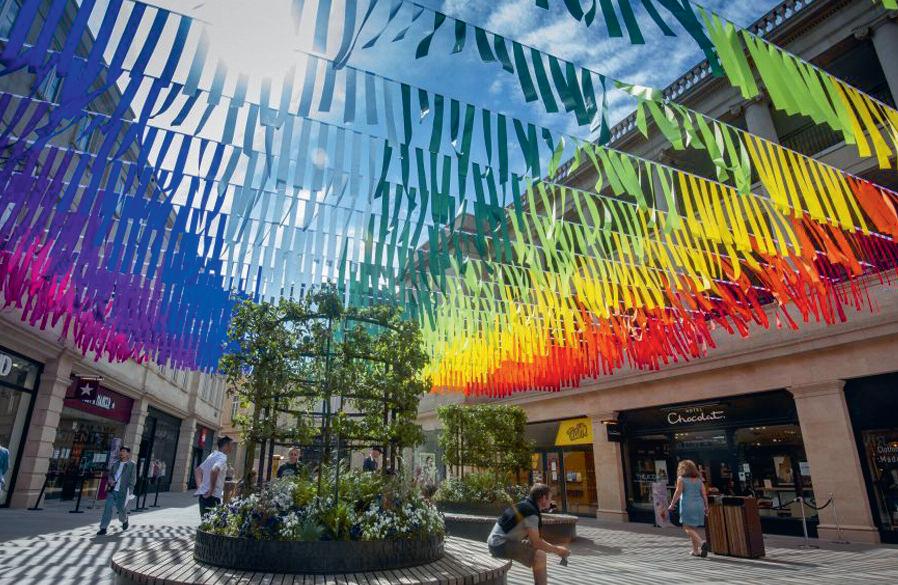

BATH AQUA GLASS

MALLORY, BRIDGE STREET
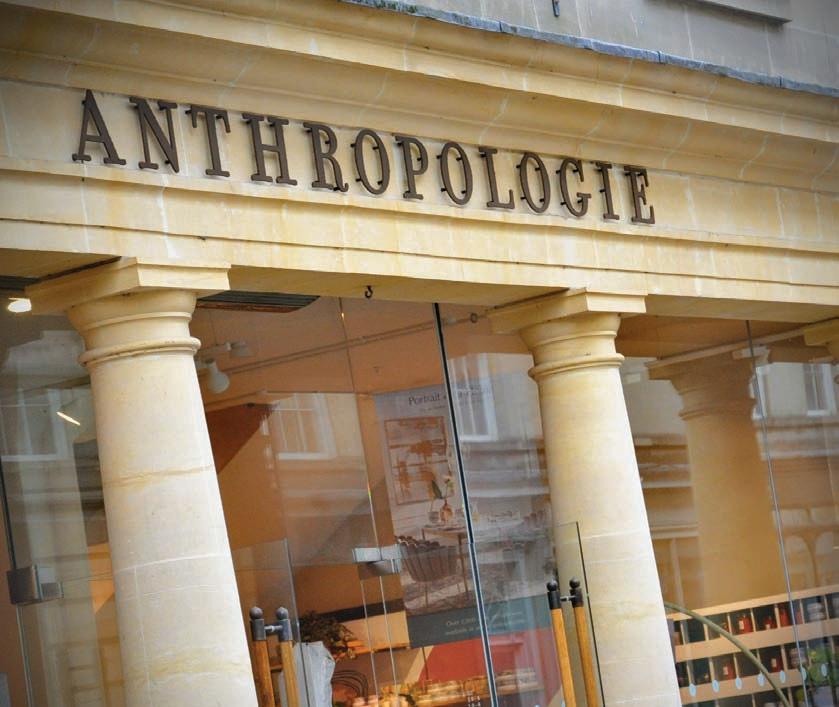
ANTHROPOLOGIE, NEW BOND STREET


 WADSWICK COUNTRY STORE, PULTENEY BRIDGE
DRESSING ROOM, QUIET STREET
WADSWICK COUNTRY STORE, PULTENEY BRIDGE
DRESSING ROOM, QUIET STREET
Bath’s best shops
Whether you crave a fast fashion fix courtesy of the biggest high street names or fancy an elegantly paced, inspirational browse around an eclectic range of independent traders, Bath offers a unique blend of shopping experiences. Melissa Blease guides us through the streets paved with shops
Great shops are a primary reason why people love to visit Bath, shop in Bath, and choose to work or live in Bath. Interesting, designer, luxurious, cool, or just downright eccentric, our independent shops sell beautiful things with a customer service that is rarely found elsewhere. There’s a compelling argument that indirectly these indie emporiums and little shops contribute more to the city’s economy than the high street chains. While broader market forces continue to challenge retailers, Bath remains one of the finest shopping destinations in Europe.
One of the best aspects of Bath’s commercial centre is that everything is easily walkable –in no more than 30 minutes you could make one end to the other. To really enjoy the city, however, you need to meander down little streets, get slightly lost, find beautiful shops and make purchases by happenchance. So let the joy begin...
To help you get your bearings, let’s start at the south end of town, the spacious SouthGate area –just across the road from Bath Spa train and coach stations. This is home to multiple shopping opportunities including familiar high-street stores such as Apple, Boots, Urban Outfitters, Oliver Bonas, Tommy Hilfiger, Hollister and H&M and a recently opened super-sized Zara store are at the heart of one of the west country’s glossiest shrines of merch. As you stroll along the swanky pedestrianised thoroughfares that lead north from the SouthGate complex, a myriad of independent retailers, market traders and buskers happily sit alongside branches of M&S, Primark, Clarks, COS and more, contributing to the unique retail landscape that shoppers love about Bath.
The further up town you go, the many stylish shops and watering holes towards the northern aspects of the city centre tend to be housed in the kind of historic buildings that make Bath so unique.
Around and about the centre of town, there’s a picturesque conurbation of cute little passages and byways. Both the supercharming Northumberland Passage and the uniquely pretty undercover arcade The Corridor flaunt an enchanting selection of independent shops. The wares include must-have accessories, quirky galleries, a branch of organic remedy and skincare specialists Neal’s Yard, and a number of long-established, Bath-based goldsmiths and jewellers such as the Gold and Platinum Studio and Nicholas Wylde’s enticing emporium. Between them is the Coeur de Lion, officially the smallest pub in Bath. For the gentleman about
town, if a quick haircut or wet shave is needed then a Turkish barbershop adds a lively dash of international character.
Across the main shopping street at the end of Northumberland Passage and The Corridor, and you’ll find yourself bang on track for a bustle around the historic Guildhall Market (read on to find out more) on the High Street. Amble through the market, exit via Grand Parade, and you’ll find yourself taking in the spectacular weir views, adjacent to... Ah, Pulteney Bridge: Bath’s very own, utterly enchanting version of Florence’s Ponte Vecchio. The bridge was designed in 1769 by Robert Adam, opened to the public in 1770 and is today lined with a fascinating collection of unique shops including an antique map shop, children’s clothing specialist Up-toSeven, a gorgeous flower shop (Pulteney Bridge Flowers), the curiously trendy boutique Found, the fabulous Wadswick Country Store at one end and Honey Willow jewellery at the other, a few doors down you’ll find the official Bath Rugby shop.
On Bridge Street (on the city centre side of the Pulteney Bridge area, on the corner of the High Street) you must take time to discover Mallory, arguably Bath’s (and the West Country’s) most glamorous jewellery and watch emporium, established in 1898 by Edward Palmer Mallory. Today, Mallory – which remains very much a family business – enjoys legendary status across the globe as an ultimate destination for exclusive timepieces and jewellery, and specialists in all manner of luxury gifts and accessories rarely seen outside London. Prepare to be dazzled here.
Back on the northerly track, Milsom Street is home to the House of Fraser store Jolly’s (originally the oldest department store in the UK, established in 1831) and a classy array of super-chic, big-name fashion retail outlets nicely balanced by a handful of quirky independent outfitters, gift shops and homeware stores such as Portman boutique, Mulberry, Cream Cornwall, and OKA.
Over the road from Jolly’s, you’ll find Milsom Place: a quiet cobbled courtyard and home to a variety of great restaurants and high street flagship stores including Hobbs and Phase Eight while Green Street (adjacent to Milsom Place, and officially part of the ‘Milsom Quarter’) is one of the city’s prettiest thoroughfares, lined with independent traders including, Minerva Art supplies, British Shoe Company and Amathus, a specialist wine and drinks retailer. Meanwhile, New Bond Street (parallel to Green Street) is lined with yet more fashionable pitstops including, Anthropologie, Albaray, Sea Salt, L'Occitane and chic skincare sanctuary Space NK Apothecary, Aesop, Jo Malone and Penhaligons – but we still haven’t blown the shopping budget yet. ➲
Take left at the bottom of either Green Street or New Bond Street and you’re perfectly placed for a stroll up Broad Street, home to Rossiters of Bath, (the eclectic and quirky department store known as the Liberty’s of the west country), the lovely houseplant shop Chapter 22, Always Sunday (really cool homeware) Tilian Kids and stylish boutiques Boho and Aspiga. Next take a turn into the Walcot Street/London Road area, known locally as Bath’s Artisan Quarter. Here you’ll find some of the funkiest indie trading posts in town specialising in everything from vintage clothes to stylish interior stores and, taking in all manner of foodie havens along the way including the odorous yet beautifully stocked Fine Cheese Company and veggie/vegan Harvest, homeware store Graham and Green, as well as the fun and funky Yellow Shop for pre-loved vintage and retro style clothing.
Heading back up to the city’s northern slopes, the elegant George Street flaunts an eclectic mix of good deli’s, coffee shops, the excellent Grace and Mable boutique as well as cool charity shops, and a strip of nightclubs and winebars. Meanwhile the pretty pedestrianised lane that is Bartlett Street (just off George Street) is home to a number of glam-but-accessible boutiques, a wonderful antique centre and unique lifestyle space: The Loft, formerly a Victorian department store, where businesses share floorspace and features the popular Café Lucca, and designer women’s clothing by Blue and the Loft’s own über-cool home and interiors department. Needless to say there are so many more great little shops and boutiques that are worth discovering; Women’s fashion at Kimberly, beautiful lingerie and swimwear at The Dressing Room are a must and finding them and many more as you zig-zag the city is a true testament to the joy of serendipity.
Farmers’ markets have earned near-legendary status in foodie circlesand the original – and, many would argue, still the best of the bunch – is based at Bath’s historic Green Park Station and was formally established there in 1997, making it one of the longestrunning farmers’ markets in the UK. Popular this bustling hubbub of food-based fabulosity offers a wide selection of traders, all of whom are local to Bath. An ever-evolving selection of largely organic, seasonal produce proliferates at the market every Saturday morning, supplemented by themed markets including the weekday mini-markets and the excellent Bath Contemporary Artists Fair (every 2nd Sunday of the month) there’s also antiques, vegan and other ad-hoc markets to enjoy each month. See the full line up on the website: www.greenparkstation.co.uk
For those of us who like to shop the old fashioned way, the Guildhall Market is a veritable treasure house of delights. Baubles, beads and bows; pet food, mop buckets and second-hand books; feather boas, handbags and old fashioned humbugs; deli food, cheese specialists and exotic delights: the oldest trading epicentre in the Heritage City offers the kind of “I didn't know how much I needed one of those until I found it here” experiences that online, supermarket or even high street shopping can never provide. Meanwhile, Walcot Street’s popular Antique and Flea market offers a unique selection of clothes, antiques, books, crockery, collectables and more every Saturday morning.
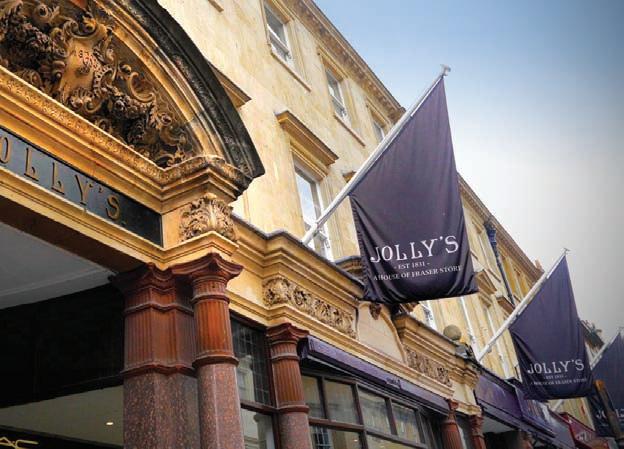



 NICHOLAS WYLDE, NORTHUMBERLAND PLACE
NICHOLAS WYLDE, NORTHUMBERLAND PLACE






A city of great shops
Essential, interesting, designer, luxurious, cool or just downright eccentric... our retailers sell beautiful products with a customer service that is rarely found elsewhere. The Postcard Guide promotes a selection of our favourite shops and stores that make the Bath one of the finest shopping destinations in the country.
14 Cheap Street / 15 Abbey Churchyard, Bath BA1 1NA Tel: 01225 789931 105 – 107 Walcot Street, Bath BA1 5BW Tel: 01225 428146 Web: bathaquaglass.com
Bath Aqua Glass is a friendly local company creating handmade glass right in the centre of the city. From beautiful blown pieces and bespoke windows to delicate jewellery and ornaments, the range on offer is exceptional. The Walcot Street studio is open for viewings seven days a week, where you can watch expert glassblowers create works of art using ancient techniques and even have a go! Afterwards, wander down to the Abbey Churchyard shop and select a souvenir or two from the many stunning pieces available there. For a genuine gift from Bath, look no further than Bath Aqua Glass.
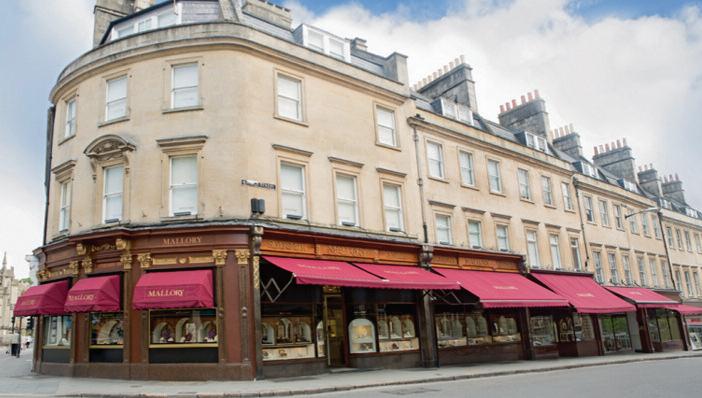
1 – 5 Bridge Street, Bath BA2 4AP Tel: 01225 788800 Web: mallory-jewellers.com
Mallory is renowned as Bath’s destination jeweller. Now in its fifth generation, it is one of the country’s oldest family-owned and run jewellers, established for 125 years in its original Bridge Street premises. Today it boasts one of the largest in-house workshops in the UK, employing goldsmiths trained to the highest calibre, who create the most exquisite bespoke jewellery, as well as fully accredited watchmakers, who are qualified to maintain the finest of timepieces. Inside the showroom you will find a majestic emporium of fine and contemporary jewellery, watches, and luxury gifts and accessories from the world’s most exclusive brands. The imposing frontage may look daunting, however Mallory’s offerings encompass something to suit all pockets, with international names such as Patek Philippe, Rolex, Omega, Tudor, Fabergé, Chopard, Marco Bicego, Montblanc, Tag Heuer, Longines, Breitling, Georg Jensen, Fope and Mikimoto, as well as an extensive collection of jewellery designed by Mallory.
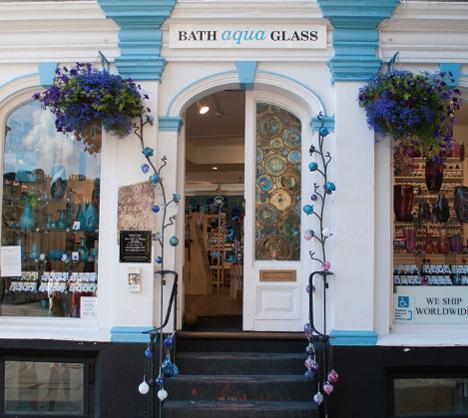
5 Upper Borough Walls, Bath BA1 1RG Tel: 01225 259602 Web: magalleria.co.uk
Magalleria is a unique store selling the largest collection of international, independent and niche print magazines in Europe, and arguably anywhere. Based in central Bath, Magalleria imports magazines, journals and zines from all over the world (many exclusive) to showcase the most interesting and hard to find titles from indie magazine and book publishers. Interest in creative print is very strong, with new entrants and established publishers alike now able to access modern production technologies that ensure today’s magazines are better geared to make reading a more tactile and visually pleasurable experience than ever before. With knowledgeable staff and offering strong depth in art, design, interiors, fashion, lifestyle, food, travel and literature, Magalleria is packed with information, ideas and inspiration.
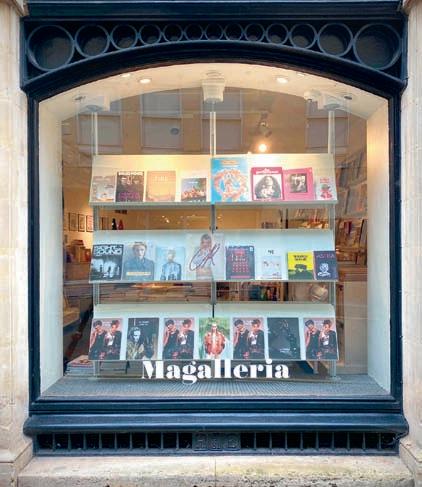
8 Pulteney Bridge, Bath, BA2 4AX
Tel: 01225 422339 Web: honeywillow.com
Honey Willow is a Bath family run jewellery business on historic Pulteney Bridge, handcrafting meaningful, personalised jewellery celebrating loved ones and life’s milestones.
Started online in 2010 by local mum, Rhiannon Hamilton, the business is named after her two daughters: Honey and Willow.
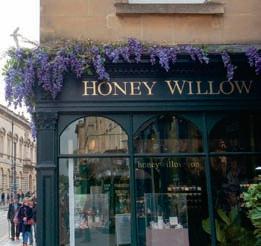


Honey Willow now have a shop on historic Pulteney Bridge, with a workshop nearby, where the jewellery is made by a team of creative local makers. Jewellery made to order, with a small selection available to purchase in the shop. For a memento of your time in Bath visit the shop on Pulteney Bridge of find the full range on the Honey Willow website. Open: Monday 10am-4pm & Wednesday-Saturday 10am-4pm. Discount code for 10% off : POSTCARD10
Bath BA1 1LT
Tel: 01225 422462 Web: www.bathabbey.org
The Abbey shop, located on the south side of Bath Abbey, is a treasure trove of souvenirs and Christian gifts. The gift shop tells the story of the Abbey through its product ranges, with a Benedictine monk range, tales of Tudor days and comes right up to date with gifts depicting the West Front in a rainbow of colours. Featuring many local artists, the shop also has a special focus on Christian women and their small businesses. Alongside the core product lines and an excellent selection of Christian books, there are special souvenirs for different times of the year.
7 Broad St, Bath BA1 5LJ Tel: 07955 658061 Web: www.aspiga.com
Aspiga, an award-winning sustainable independent B-Corp certified fashion brand is a one-stop shop for summer chic and holiday style. Its success highlights that fashion made fair, and designed beautifully, with respect to the environment and those who make the clothes, is not just feasible or achievable but in high demand. Aspiga has proudly outfitted these shops with nearly all reused and repurposed materials.

Aspiga is a leader in British sustainable fashion and in 2022 was awarded B-Corp, recognized to be one of the highest global accolades in ethical and sustainable practices. New pieces for SS24 include a stunning block-print collection of organic cotton dresses, a new range of easy to wear cheese cloth pieces, fabulous frocks for all the summer events and a one-stop holiday wardrobe.
12 Northumberland Place, Bath BA1 5AR Tel: 01225 462826 Web: nicholaswylde.com
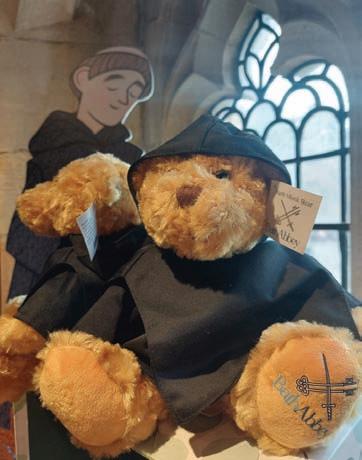

The south west’s leading designer jeweller, award-winning Nicholas Wylde has been designing original, high-quality jewellery since first opening his Bath store in 1987. He has built up a reputation for designing outstanding pieces; from one-off commissions to larger corporate orders – all handmade, with great passion, in the workshop on the premises. An added cool factor: Nicholas Wylde offers his own patented diamond cut, the dazzling Wylde Flower Diamond®, with more cut facets than a brilliant cut diamond for that extra-special sparkle. You won’t find this gemstone anywhere else in the world. For vibrantly unique designs and excellent service from knowledgeable and helpful staff, Nicholas Wylde is a perfect destination for anyone looking for that truly unique piece of jewellery.
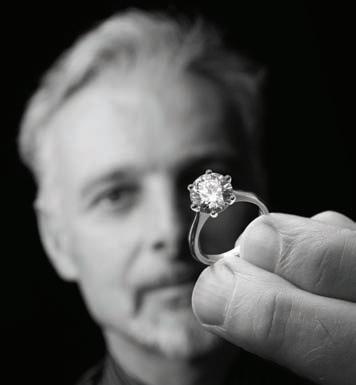
28 Milsom St, Bath BA1 1DG Web: portmanboutiques.co.uk

Founded by Nickie Portman in 2011, Portman Boutique is the place to find something unique, bold and beautiful to wear and love. You’ll find a carefully curated collection of Nickie’s favourite styles, many designed in house, to see you through every season. From Italian and Parisian French fashion to the Nickie Portman Jewellery collection and accessories, Nickie sources and designs beautiful collections with her stylist’s eye. Nickie and her team select every item based on what they truly love to wear. They buy seasonally based on the latest trend-led silhouettes and love to add their particular sense of style to every collection. Whether you’re treating yourself to a new accessory to brighten your wardrobe or are treating a friend to some jewellery to brighten theirs, you’ll find the perfect piece.
28 & 31 Brock Street, Bath BA1 2LN Tel: 01225 334234 Web: beaunashbath.com
Antique lovers, shopping for fashionable quality pieces has never been easier! Beau Nash has over 1000 quality antique silverware, furniture, mirrors and objet d’arts with regular deliveries to London & efficient global shipping. With personalised service by Ron, Cynthia & their team, shopping for useful & stylish antiques is fun and easy. Situated between the Circus and the Royal Crescent, you can also see a recently-discovered Georgian kitchen in the basement of their furniture shop. They are one of the loveliest shops to visit in Bath and is a must-see on our list.

9 Abbey Churchyard, Bath BA1 1LY
Tel: 01225 470072
Web: jodycory.co.uk
Jody Cory is an independent jeweller and member of the National Association of Goldsmiths with more than 25 years’ experience. From her shop and workshop in Abbey Churchyard, Jody and her team create beautiful, unique pieces which are the perfect way to mark any special occasion. Friendly advice is available seven days a week from a team of highly skilled goldsmiths working in extremely covetable silver, gold and platinum and using personally selected rare gemstones. Old or broken treasures can be repaired or remodelled to become exciting new pieces to be enjoyed all over again and a free design service is available. Jody also offers restringing, rhodium plating and valuations. Her shop in the Abbey Churchyard offers skilfully crafted handmade jewellery from inexpensive silver pieces to diamond-set engagement rings and wedding rings in traditional and contemporary styles to suit all taste as well as a variety of highly interesting work from other UK designers.

14 New Bond St, Bath BA1 1BE Tel: 01225 410090 Web: penhaligons.com
British perfumery Penhaligon’s was established in 1870 by William Penhaligon. Originating as a barbershop, Penhaligon’s offered its first fragrance in 1872, Hammam Bouquet, inspired by the neighbouring Turkish Bath and its sulfurous steam. The company’s bestselling fragrance, 1902’s Blenheim Bouquet, broke with the prevailing floral trends of its day to enchant with zesty citrus, spices and woods. In 1956 Penhaligon’s was granted a Royal Warrant for the manufacturing of toiletries. The company specialises in fine, traditional perfume ingredients and techniques. Penhaligon’s today offers a line of bath and body care products and candles to complement its fragrances.
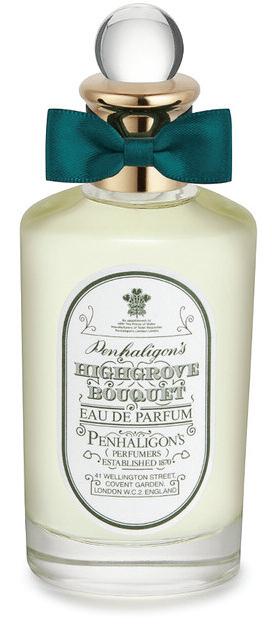
1 –4 New Bond Street, bath BA1 1BE Tel: 01225 335578 Web: anthropologie.com
Anthropologie in Bath is a wonderful, one-of-a-kind destination for those seeking rich collections of clothing, accessories, gifts and home décor inspired by fashion, art and entertainment. Products are sourced by buyers and designers who travel the world to uncover unique, special items and often collaborate with upcoming talented artists. The result? An eclectic assortment that includes clothing, accessories, beauty, found objects, gifts and more, with influences ranging from vintage to global. A visit to Anthropologie will reveal exquisitely crafted treasures waiting to delight.
9 – 11 Walcot Street, Bath BA1 5BN Tel: 01225 339009 Web: thebathhatcompany.com

The Bath Hat Company has been a reputable provider of exceptional hats for the past three decades and has an extensive collection that will cater for every occasion. The bespoke hats are crafted with meticulous care and attention to detail by a team of skilled artisans, and are designed to make you stand out from the crowd. For women, choices include elegant accessories for a formal affair, functional hats for a sunny outdoor excursion, or cosy headpieces for the colder months. For men there is a diverse array of top-notch caps, from the timeless appeal of fedoras to panamas and trilbies. The shop also provides professional hatstretching services to guarantee a perfect and comfortable fit.
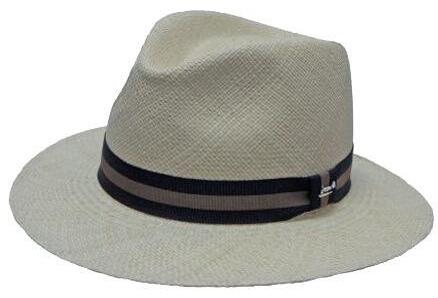
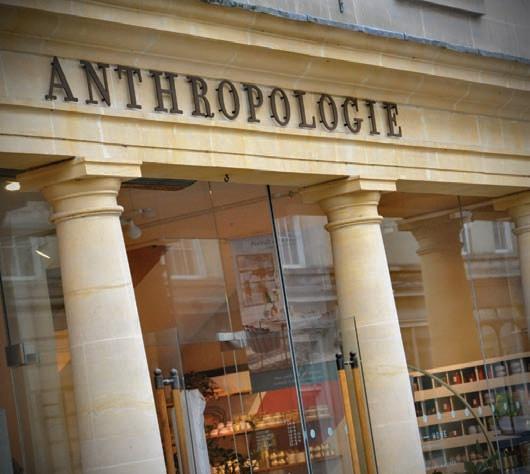
29, Milsom Street, Bath, BA1 1DG Tel: 01225 592164 Web: creamcornwall.co.uk
Inspired by the Cornish coast, Cream Cornwall makes luxury and exclusive homewares for people who love to be surrounded by beautiful things. Featured on homewares and fabric, their unique designs transform ordinary objects into statement pieces. Cream Cornwall’s overarching motto is ‘Beautiful things, beautifully made’ and Rebecca and Allison, the co-founders of Cream Cornwall, are committed to producing quality and unique homewares that inspire. The two women are passionate keeping production as local as possible, with their candles, diffusers, lampshades and cushions all made locally in Cornwall. Both Rebecca and Allison maintain the importance of having physical stores, and their shops in Falmouth, St Ives and Bath beautifully showcase the wide range of products.
7-8 Abbeygate St, Bath BA1 1NP Tel: 01225 436678 Web: georgefisher.co.uk/shops/bath
Started in 1957 in the Lake District, and recently opening in the heart of Bath on Abbeygate Street, George Fisher has over 60 years’ heritage and experience in equipping outdoor adventures - from walking to camping to watersports, and anything in between. Bath is surrounded by beautiful countryside which makes it an ideal base for outdoor enthusiasts to enjoy the nearby walks and trails. George Fisher offers a carefully curated selection of the world’s most exciting outdoor brands including; Patagonia, Arcteryx, Rab, Berghaus, The North Face, Passenger, Fjallraven, Merrell and much more, so whatever your adventure, George Fisher has you covered.
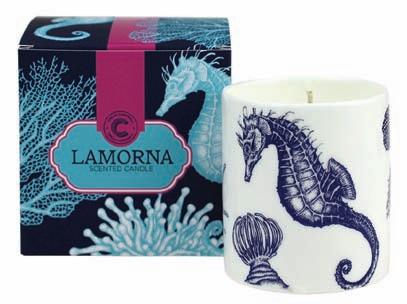
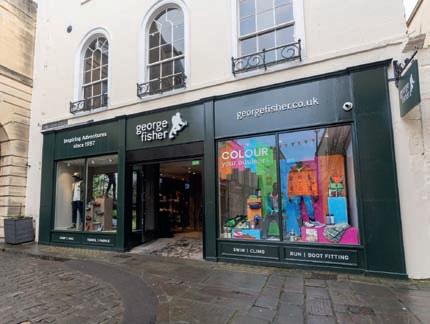

24 New Bond Street, Bath. BA1 1BE
Tel: 01225 967714
Web: Albaray.co.uk
Albaray is a contemporary, womenswear brand on a mission to make stylish dressing more sustainable.
Launched in 2021, Albaray offers versatile and effortless collections that are always thoughtfully designed and responsibly made. From everyday dresses, perfect jeans, easy to wear separates and basics that will elevate your look all designed to complement your existing wardrobe.
Visit Albaray’s recently opened store on New Bond Street to see the full Albaray collection.
11 Pulteney Bridge, Bath BA2 4AY
Tel: 01225 464013 Web: nigeldando.co.uk
3 George St, Bath BA1 2EH Tel: 01225 445511 Web: graceandmabel.co.uk

Sisters Shelley, Daniela and Kirstie established Grace and Mabel in Bristol in 2007. Once a single small boutique in Clifton Village, Grace and Mabel grew quickly and a second shop opened in Bath in 2010. Grace and Mabel offers a special level of service and a wonderful shopping experience for clothing, accessories and lifestyle goods from top European, Scandinavian and British brands. Today, Grace and Mabel is just as exciting as it ever was. One of the West’s most distinctive shopping destinations, it continues to offer pieces that have been individually handpicked from the world’s top designers. The mantra is “We buy only pieces we like, we are very selective. It’s all about quality and individuality”
Nigel Dando began his career after he gained a national goldsmiths diploma before going on to study gemmology at the Sir John Cass College of Art, Whitechapel. Today he sells an eclectic mix of new, pre-owned and vintage jewellery, and has a particular interest in pieces from the 1920s to 1960s. Together with ranges of contemporary silver jewellery at affordable prices, many of which are one-off pieces, the emphasis is on quality and style. He also buys gold and silver items in any form or condition. Nigel also sells investment precious metals at what he believes to be the most competitive prices in the city. Being one of the few provincial members of the London Diamond Bourse, Nigel offers undeniable expertise and value. He also offers a valuation service.


13 Milsom Street, Bath BA1 1DD Tel: 01225 786900 Web: houseoffraser.co.uk
Jolly’s is one of the oldest department stores in Europe. James Jolly first took retail premises back in 1823, before his son Thomas became the driving force behind the business, pioneering fixed price merchandising. Now restored to its 19th-century glory by owners House of Fraser you’ll find the full spectrum of desirable goods, from homeware and accessories to cosmetics and fashion. The magnificent beauty hall is full of luxury brands. Jolly’s has always had retail innovation at its heart and retains its place as the jewel in the crown of the city’s stores.
6 Pulteney Bridge, Bath BA2 4AX Tel: 01225 422333 Web: uptoseven.co.uk
Have you found this beautiful shop on Pulteney Bridge? Here the team makes and sells lots of dresses, reversible dungarees, hand-knitted woollies and of course the store’s famous and incredibly cute hats; strawberry, Christmas pudding, Bath Rugby and more. Up to Seven is a major stockist of Frugi and Kite, organic cotton, fairly traded clothes for babies and children and always has lots of appliqued T-shirts, dresses, hats, baby gifts and dinosaurs. If you haven’t been in or if you are looking for a baby gift, a frock for a special occasion or comfy clothes for everyday, then pop in to Up To Seven to find the perfect solution.

10 Margaret’s Buildings, Bath BA1 2LP Tel: 01225 571711 Web: homefrontinteriors.co.uk
Homefront Interiors is a small independent gift and homewares store which though small in size packs a punch with its wide range and regularly updated stock. The store follows a simple ethos to source ethically made and sustainable products with as many local brands as possible. With a clever mix of work by local artists and makers, displayed alongside handmade fair-trade products from around the world, Homefront aims to support the small producers and minimise environmental impact. The shop is a treasure trove of beautiful things - handmade, fair trade, recycled, or made from sustainable materials. The aim is to be the destination store in Bath for hand-picked special gifts and unique finds for your own home.
7 Quiet Street, Bath BA1 2JU Tel: 01225 330563 Web: dressingroombath.com
Since first opening in Bath in 1985 The Dressing Room has maintained its reputation as the ‘go to’ place for the finest in lingerie, beach and nightwear. While offering the most exquisite lingerie collections from the likes of Marie Jo, Aubade, Lise Charmel, Empreinte and Prima Donna, the shop also has a wide range of basic T-shirt bras and invisible briefs. The beachwear collection is available all year round and features brands such as Melissa Odabash, Maryan Mehlhorn, Roidal, Anita, Gottex and Miraclesuit. The Nightwear selection includes silks from Marjolaine and Luna di Seta, robes from Louis Feraud, Diamond Tea and Clara Rossi and cottons from Hanro – amongst much, much more. With experienced and professional staff ready to help you, why not go along and have some fun?
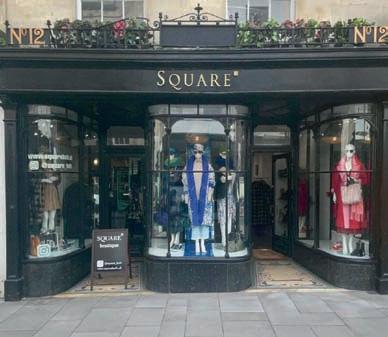
12 New Bond Street. Bath. BA1 1BE Tel: 01225 464997 Web: square.store


Established in Bath in 1981 selling selling Vivienne Westwood garments, Square is an award-winning designer ladies boutique. Over the last 40 years Square has worked with most brands and designers including Ozbek, John Flett, Fendi, John Galliano, Marc Jacobs, Prada, Gucci. Dolce and Gabbana, Chloe and YSL. The store is in a listed building in the centre of Bath and was once occupied by Mary Shelley and Percy Bysshe Shelley. Famously Mary Shelley wrote the first five chapters of Frankenstein there. In recent years Square has specialised in contemporary brands and with excellent personal customer service it is the ideal shop to look for that extra special something for any occasion.
Trim Street, Bath BA1 1HB
Tel: 01225 466817 Web: Kimberly.co.uk
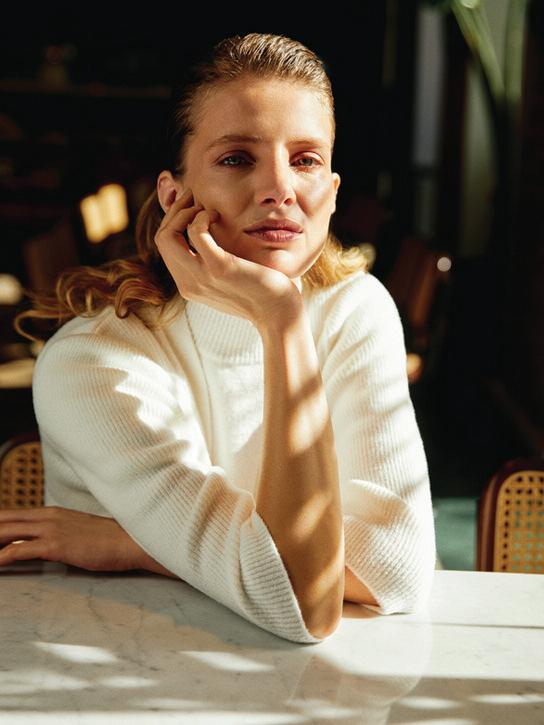
Kimberly has stocked some of the world’s finest Designers for over 40 years. The shop has established itself as a must-go-to store for every day luxury wear or for that special occasion. Current designers include: Amina Rubinacci, Max Mara, Le Tricot Perugia, Kinross, Luisa Cerano, Cinzia Rocca and more.
On the arrival of new season collections, they are photographed in the inhouse studio and sent by email in book form to her established clients, to give a taste of the wonderful clothes available in store.
25 Union Passage, Bath BA1 1RD
Tel: 01225 464781 Web: thesilvershopofbath.co.uk
This little gem of a shop continues to be one of Bath’s favourite gift and jewellery stores and is still a family-run and independent business. You’ll find it tucked away just a minute walk from The Abbey and The Roman Baths. The shop is a firm favourite with visitors and residents alike and has a reputation for great customer service. With Bath’s largest selection of silver jewellery with prices ranging from £5 to £500, the staff work hard to source a wide selection of pieces with some ranges being handmade by local jewellers. With a small workshop on site, The Silver Shop also offers a charm soldering service for customers. Make this your first stop if you’re looking for a gift for someone special or just to treat yourself to a piece such as a clock or a candle, a christening gift or even a Charlie Bear, it is certain to have something for you. Open Monday - Saturday 9:30 - 5:30

1 Pulteney Bridge, Bath, BA2 4AX Web: wadswick.co.uk
Recently joining the row of shops on Bath’s iconic Pulteney Bridge, Wadswick has in its collection of men's and women’s fashion and accessories, some of the world’s best-loved country brands including Holland Cooper, Barbour, Schöffel, Fairfax & Favor, R.M. Williams, Ariat and Yeti. Wadswick specialises in the country lifestyle and their new boutique in Bath builds on over thirty years of country heritage from their flagship store near Corsham, the popular market town seven miles east of the city. There you will find a large clothing collection, a huge range for equestrians and pet lovers, a shooting simulator and a smart, contemporary restaurant. In Bath, their chic range of clothing is perfect for those looking for that smart-casual feel that will take you around the city and into the countryside in style.
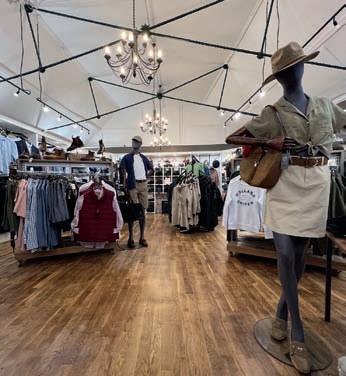


3 Pulteney Bridge, Bath BA2 4AX Tel: 01225 463693 WhatsApp: 07376 416833
Web: icarusjewellery.com
Icarus Jewellery is an independent silver jewellery shop located on Pulteney Bridge in the heart of Bath, and offers a great selection of handmade unique designs from their store and online shop. Owner Dilek Köroğlu designs and makes some of the handmade silver jewellery pieces in the shop and is always happy to show you more of any particular style you desire. You are also very welcome to discuss custom orders for bespoke designs. The shop is something a little bit different and a place to be surrounded by beautiful things.
19 Northumberland Place, Bath BA1 5AR
Tel: 01225 462300
Web: goldandplatinumstudio.co.uk
Goldsmith and gemmologist Michael Parsons and his team run a delightful independent studio. He specialises in handmaking one-off engagement rings and wedding rings, as well as offering a wide range of individual pieces. Michael and his team undertake all types of commissions on-site as well as carrying out remodelling and repairs. In addition Gold & Platinum Studio showcases a selection of independent designer jewellers. A superb choice to suit all budgets. Michael has been trading in Bath for over 40 years and has an enviable reputation for quality service. A visit is a must for jewellery lovers and anyone looking for a special gift or thinking of having a piece of jewellery made.
33 High Street, Bath BA2 4AW
Tel: 01225 460808
Web: bathguildhallmarket.co.uk
Bath Guildhall Market is the oldest shopping venue in the city and today a colourful group of 20 or so stallholders trade in this jewel of a building in the heart of the city, just 80 yards from Bath Abbey and opposite the famous Pulteney Bridge. Offering virtually everything you need under one roof, plus service with a smile and the kind of old-fashioned personal attention you find when shopping at a family-run business. You’ll find haberdashery, hardware, partywear, pet supplies, foodie treats and everything in between.
4 Burton Street, Bath BA1 1BN Web: jimmyfairly.co.uk
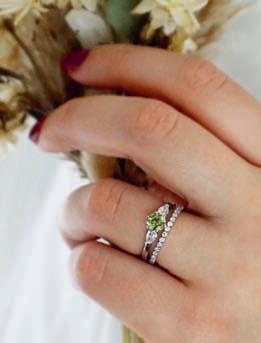
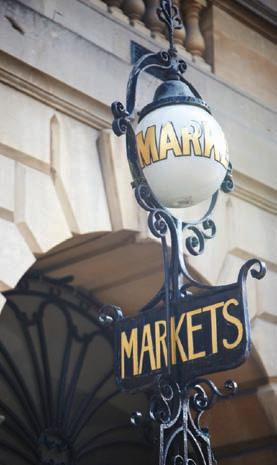
Founded in 2010 by Antinon Chartier, a 23 year old psychology student with a passion for entrepreneurship, the concept was simple: high-quality glasses, fair prices, a positive social and sustainable impact. Over a decade later, little has changed. Jimmy Fairly now has more than 126 stores across France, The UK, Belgium, Italy & Spain. Moreover, Jimmy Fairly is successfully bringing back great style and a smile to the eyewear world. Every two months, a new drop lands. Agile in their creative process, Jimmy Fairly constantly offers the latest trends to their customers in limited edition styles, always designed in their Parisian studio. Jimmy Fairly now has stores located in both Bristol and Bath.
9 Milsom Place, Bath BA1 1BZ
Tel: 01225 333693
Web: chaniibshoes.com
Chantal Pilon, the visionary founder of Chanii B Shoes, departed her prestigious senior design career to create a brand that marries luxury with comfort and quality. With a legacy steeped in her family's footwear excellence, she was driven to counteract the compromises of mass production. Chanii B emerged as a beacon of superior materials and exquisite craftsmanship. Celebrating individuality, the brand has flourished over twelve years into an international sensation. From the flagship store in Bath, UK, to the dazzling debut at New York Fashion Week, Chanii B epitomises timeless elegance and unparalleled quality, redefining luxury footwear.
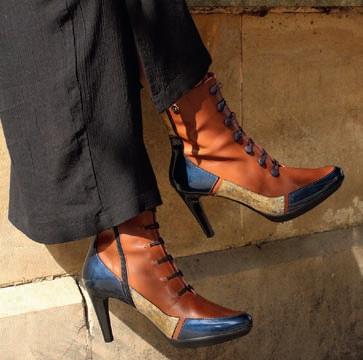
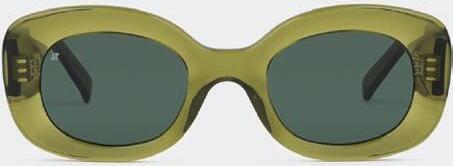


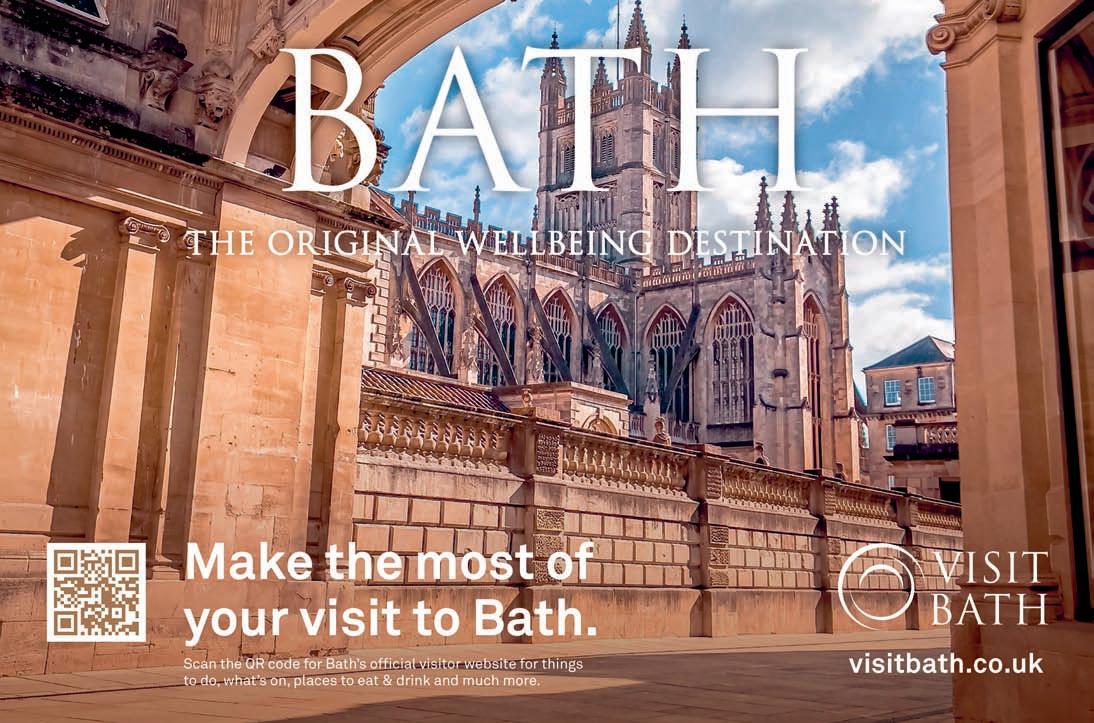
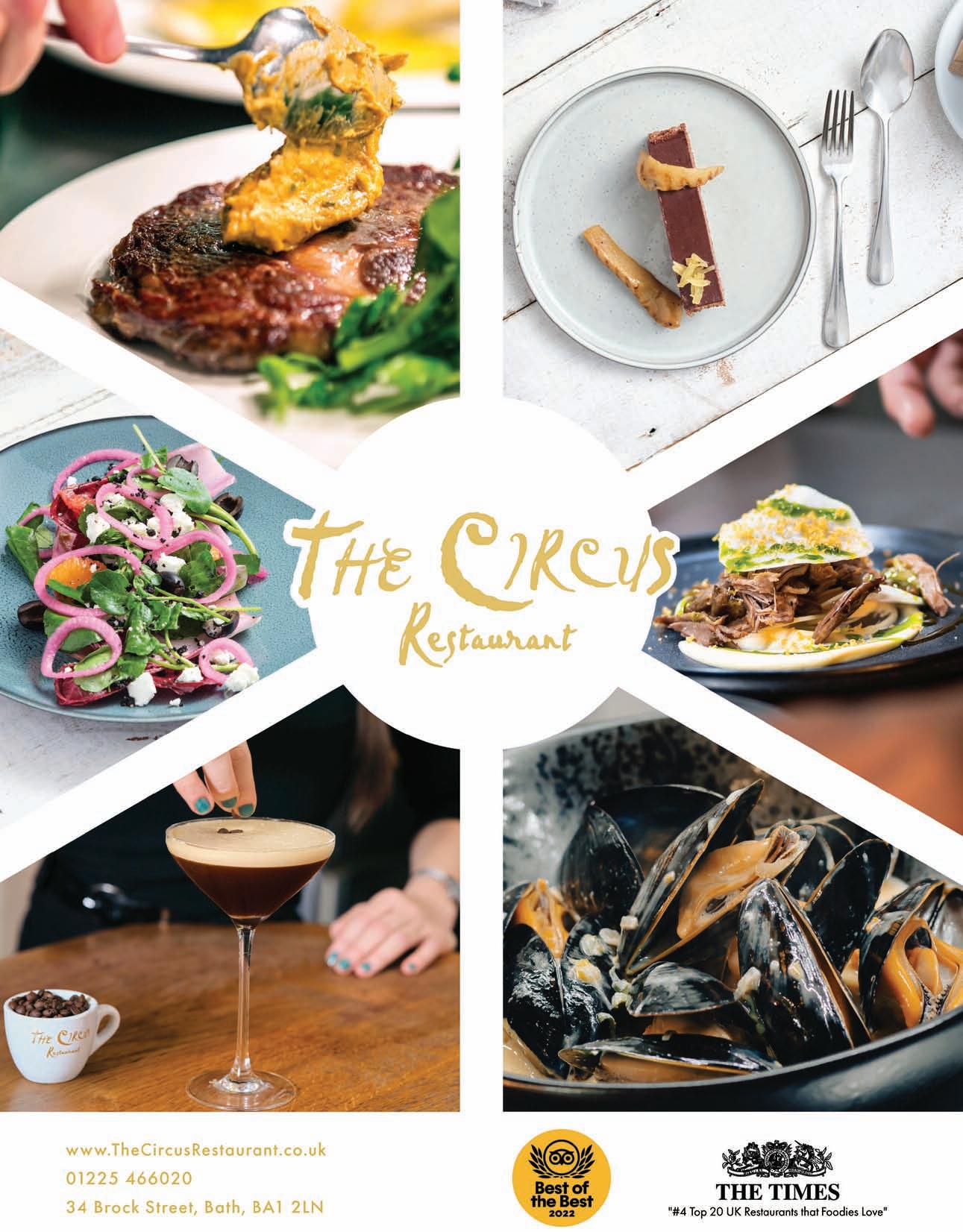
Wherever you are there are a surprisingly high number of peaceful green havens within easy walking distance around Bath. As a local resident and writer, Claire Louise Cohen has walked all of them, and shares her love of our city’s green and pleasant open spaces
The architect of New York’s Central Park, Frederick Law Olmsted wrote that he “did not see parks as just vast meadows, but rather as places of harmony; places where people would go to escape life and regain their sanity.”In Bath it is easy to take a break from the hustle and bustle of city life. Wherever you are, there is always a lovely, well maintained park or public space nearby.
SYDNEY GARDENS
Let’s start with the oldest – Sydney Gardens, at the far end of Great Pulteney Street, is the only remaining Georgian park Created in the late 18th century as a Georgian pleasure garden, it was a centre for musical entertainment, art exhibitions, fireworks, public breakfasts and promenading. The gardens were Jane Austen’s favourite place to walk when she resided in Bath. She used to take walks in the labyrinth, now long gone, but the gardens still slope upwards from the rear of the Holburne Museum (formerly the public entrance to the gardens) towards the Great Western railway line. The gardens, mainly lawns and flowerbeds, are good to combine with a canal walk. The Kennet and Avon Canal path can be accessed through an iron gate towards the top of the park.

HENRIETTA PARK
Hidden behind the north façade of Great Pulteney Street lies Henrietta Park which can be accessed from various gates including one on Henrietta Street. This park is flat so it is perfect for a gentle stroll to admire its many trees, shrubs and flower beds. Within it, the small George V memorial garden, now redesigned as a sensory garden, is full of scented flowers and shrubs. The park was created to celebrate Queen Victoria’s Diamond Jubilee, on land bequeathed by a Captain Forrester who left it to the city on the condition it wasn’t built upon.
South of Pulteney Bridge, Parade Gardens is a park on the banks of the river Avon, which was originally an orchard of the nearby abbey. All visitors can view it easily from the colonnade which affords beautiful views of the gardens, the river, the bridge and the weir. In the summer it comes to life as pretty, award-winning flower beds make a splendid show and its bandstand is the centrepiece for musical events of all kinds.
If you wander along artisanal Walcot Street from the city centre you will see a park sloping down steeply on your left. There is an entrance gate close to St Swithin’s Church, where The Paragon slopes down to meet Walcot Street. Go through the gate and you will find yourself climbing up the park’s shaded paths, a pleasant short cut up to the lower slopes of Lansdown Road. If you don’t fancy the climb, then plan your walk in the opposite direction. Over 100 Georgian buildings, originally an extension of Camden Crescent, fell down the hill in a series of landslips in 1881. The council quickly decided to turn the whole area into a park, a pleasant area and short cut between two busy roads.
Gravelled walkways, trees and grassy lawns make this small ce ntrepiece a popular resting point for tourists and office workers. Queen Square, with its paths radiating from a central obelisk, and surrounded by historic buildings designed by John Wood the Elder, still exude the elegance of Georgian Bath.
To find vast amounts of green space, head for Victoria Park to
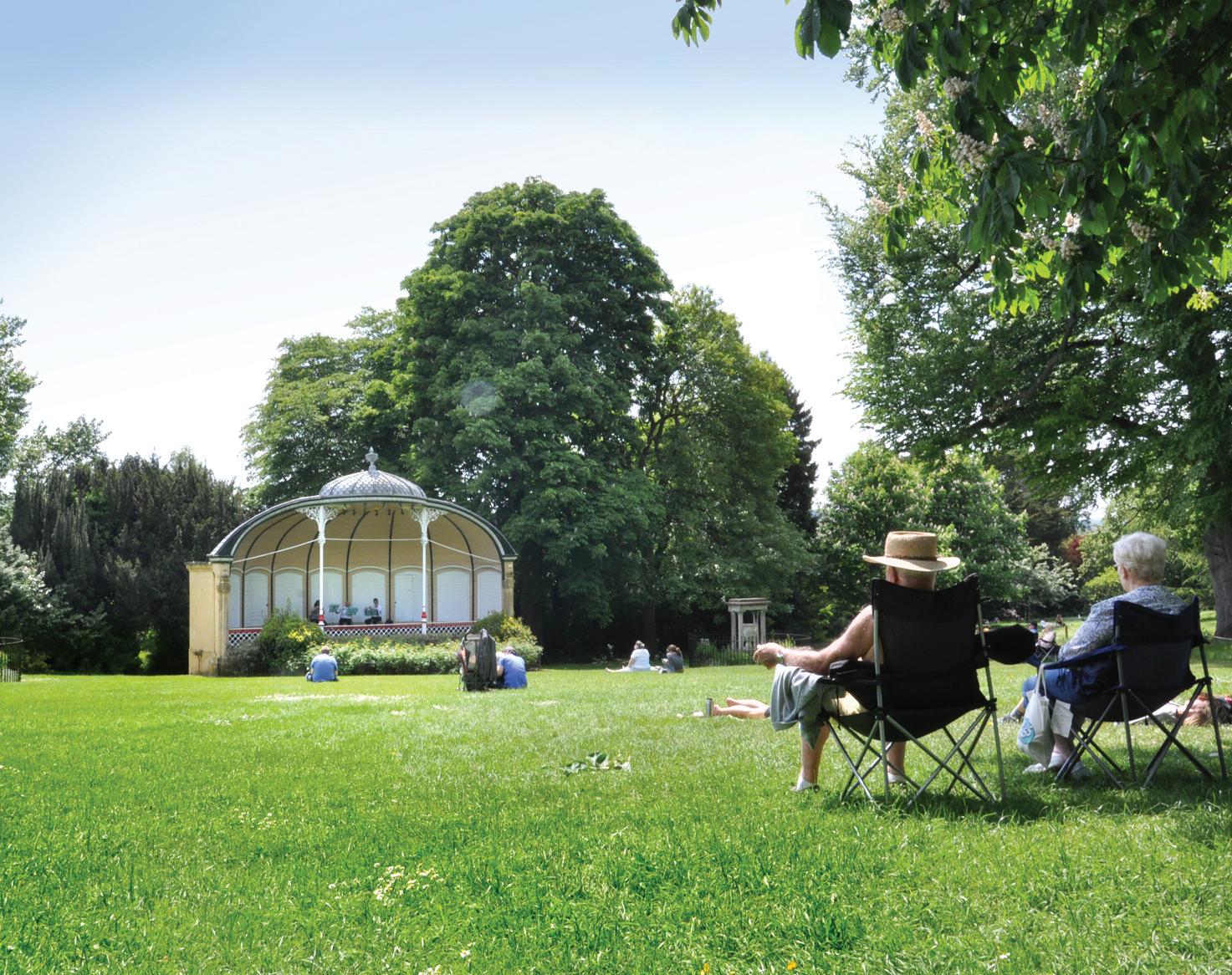
ON A WARM, SUNNY DAY THE BANDSTAND IN PARADE GARDENS
the north west of the city centre. If you can’t find the entrances, ask any local, but just ask for Victoria Park. No one refers to it as Royal – although it was opened by the then-future Queen Victoria when she was a princess, aged just 11. In the western half are the Botanical Gardens, the children’s playground, a duck pond and a huge area of grass where hot air balloons are launched on clear warm days. The children’s playground offers an incredible array of outdoor play adventures for young children.
On the eastern side of the park, you can use the crazy golf course or have a game of tennis, and there’s a café nearby. The best view is the one from Royal Avenue looking north towards the sweep of the Royal Crescent. Worth going for that view alone, and if you have time the Botanical Gardens is a must.
A spectacle of colour at any time of year, The Botanical Gardens are tucked away in the north west corner of Victoria Park, one of Bath’s hidden gems. Planted in 1887, these beautifully landscaped gardens boast a fine collection of plants, shrubs and trees, as well as a fish-filled pond, and make you feel a long way from the city. The Roman temple was relocated here after the 1924 British Empire Exhibition, where it was the city’s exhibit.
The gate close to the temple gives access to the Great Dell across the road, which has many interesting North American trees.
Also to the west, but closer to the river, is an expanse of grass known as Green Park. It is ideal for a quick walk or a sit down after a visit to the market stalls at Green Park station. Green Park now adjoins the new Riverside Walk, some parts are still under construction but a promising addition to Bath’s green spaces. Wide paths, stone steps and many young trees are already in place, so you can wander along it following the river and it will bring you gently back to the hubbub of the city.
The Riverside Walk brings you close to the bus station, so if you have time you can hop on a number 3 or 4 bus which will take you up a steep hill to Bear Flat on the south side of the city. Get off at Shakespeare Road and a five-minute walk up this road will bring you to the main gate of Alexandra Park. From the park, which is situated on the summit of the wooded hillside you can see from the river, there are magnificent views to enjoy. The highest viewpoint over the city offers a fantastic opportunity to take a wonderful photograph of Bath.
Melissa Blease explores the history and reinvention of Bath’s most eclectic museum and discovers Italian maiolica; works by Gainsborough, Pieter Brueghel and Turner; Meissen porcelain; vases by Josiah Wedgwood as well as a world-class exhibition space for contemporary art

When it’s not busy stealing the limelight in Netflix’s hit series Bridgerton as Lady Danbury’s majestic abode, The Holburne Museum on Great Pulteney Street is also home to one of the most fascinating museum collections in the west country.
Bridgerton (which returns to our screens for a third season this summer) used the building’s splendid facade as the backdrop to many spectacular and iconic scenes, making it a ‘must-visit’ place for all fans of the show. Its location is on one of the finest Georgian thoroughfares in Bath and is surrounded by glorious greenery, adjacent to the former 18th-century Sydney Garden Vauxhall.
Originally designed as a grand hotel in 1794, the impressive facade of the Holburne Museum fronts a diverse collection of fine and decorative art, spanning centuries of culture. The collection is beautifully laid out in equally beautiful surroundings that seamlessly incorporate award-winning archit ect Eric Parry’s impressive 2011 extension, respectfully integrating contemporary themes against a backdrop of historic tradition.
There’s a richly textured wealth of artistic treasures to explore at the Holburne, ranging from grand portraits and Old Masters; imposing historic furniture and domestic furniture; to tiny, highly detailed miniatures; intricate jewellery; and sparkling antique silverware. The impressive former ballroom on the front upper level of the building is used to display ceramics and porcelain from the Renaissance to the Georgian era. This can be browsed and considered under the watchful gaze of portraits of 17th and 18thcentury high society on the walls. On the top floor, the museum offers the opportunity to discover more about Bath’s history as a fashionable, creative destination ; examples of works by former Bath resident Thomas Gainsborough can be found here, alongside canvases by Stubbs, Zoffany and Ramsay.
But whichever of the many displays captivate you on any level of the museum, views across either Sydney Gardens (to the rear) or all the way down magnificent Great Pulteney Street itself (to the front, from the ballroom) offer captivating works of living art in their own ri ght.
The Holburne Museum is most definitely a family-friendly zone, offering free activities inspired by current exhibitions, activity
drawers are conveniently placed throughout the extension galleries and family trail suggestions –including a mapped-out ‘voyage’.
Meanwhile, the museum’s award-winning, fully-licensed garden café –serving an inviting variety of seasonal, freshly prepared food including fabulous homemade cakes –opens out to the historic Sydney Gardens, and the museum shop stocks a range of books, gifts, homeware, station ery and stylish souvenirs.
The building now known as the Holburne Museum was originally designed by Thomas Baldwin as a two-storey hotel to serve the adjacent pleasure gardens (Sydney Gardens) in 1794. But after Baldwin was bankrupted, plans for the original hotel crumbled. In 1796, a new foundation stone was laid, marking the beginning of a brand new project designed by Charles Harcourt Masters. The new hotel opened in 1799 and became popular with visitors to the pleasure gardens and galas. Most notably the latter were planned to coincide with the birthdays of George III and the Prince of Wales, and the opening night of the annual Bath Races and public breakfasts. Jane Austen and her family often attended the public breakfasts –when they first arrived in Bath in 1801, they took lodgings at 4 Sydney Place, just over the road.
The hotel closed in 1836 and became a private lodging house. A third storey was added, and the two watchmen’s boxes that bookend the entrance/exits to the museum today were added around 1840.In 1830, Sir Thomas William Holburne and his three unmarried sisters took up residence little over a mile away from Great Pulteney Street, at 10 Cavendish Crescent. Holburne – a former naval officer and Bath ‘gentleman of means’ – packed his modest townhouse with souvenirs, artworks, knickknacks and cultural/social paraphernalia collected throughout his naval career on a series of Grand Tours to Europe in the 1820s.


When Holburne’s aunt Catherine Cussans died in 1834, several trust funds bequeathed by Catherine allowed Holburne the means to expand his collection and to make frequent purchases at local auction houses, shops and sales. Supplemented by inherited family treasures –including portraits, porcelain and silverware –he added all manner of diverse artworks and social memorabilia to his hoard. These included miniatures, books and furniture, Roman coins and seals, 17th and 18th-century tableware and Chinese armorial ceramics... Holburne’s tastes were eclectic, and his collection became increasingly unique.
Holburne died in 1874, aged 81. In 1882, his sister Mary Anne Barbara Holburne died, and bequeathed her brother’s collection of over 4,000 pieces to the people of Bath, intending the treasures to form “the nucleus of a Museum of Art for the city of Bath”. The Holburne Museum opened to the public in 1893, and since then, a further 2,500 plus objects have been acquired.
In 1955, Ernest E. Cook – grandson of travel entrepreneur Thomas Cook – donated 10 paintings including works by Gainsborough, Stubbs and Turner to the museum. In 1963, former museum trustee J MacGregor Duncan bequested a collection of early Meissen porcelain and, in 1944, another trustee James Calder donated a comprehensive collection of English 18th-century porcelain to supplement the museum’s existing collection of Chelsea, Derby and Worcester.
In 2008, the Holburne Museum closed its doors to the public to instigate major redevelopment work. This included refurbishment to the galleries and public spaces, and a brand new extension designed by world-acclaimed British architect Eric Parry. In 2011, the Holburne’s revamp was unveiled, revealing purpose-built temporary exhibition and teaching spaces, collections stores and a café.
The Byam Family by Thomas Gainsborough (1727–1788), oil on canvas, c.1762-66. On long-term loan from the Andrew Brownsword Arts FoundationDetail of vase by Josiah Wedgwood (factory of), Jasperware, about 1780

Seven works by Thomas Gainborough including his ethereal Lady in a Blue Cloak, Johan Zoffany’s The Auriol and Dashwood Families (a snapshot of Colonial life in 1780s Bengal), The Somerset Maugham collection of Georgian theatrical portraits, three works by Pieter Brueghel the Younger and Thomas Lawrence’s Study for Arthur Atherley, which is somehow all the more powerfully characterful for being a preparatory work-in-progress.
The intricate, elaborate, richly detailed Beadwork Basket (artist unknown), part of the Holburne’s significant collection of 17thcentury embroidery.
There is also Italian maiolica everywhere. Holburne was a big fan of the uniquely beautiful, richly decorated Italian tin-glazed pottery dating from the Renaissance period.
Last of all the museum shop is packed with we ll-curated gift ideas and art books, all inspired by the collection and from exhibitions past and present.
Visit: The Holburne Museum, Great Pulteney Street, Bath BA2 4DB
Tel: 01225 388569
For admission prices and information on special exhibitions and eventsvisit website.
Open daily: 10am to 5pm (Sundays and Bank Holidays 11am to 5pm)
Closed 24, 25, 26 Dec and 1 Jan.
Web: holburne.org
Mr Doodle! Museum Mayhem
3 May –1 September
Here is the first-ever UK museum exhibition of internationally renowned artist and internet sensation, Mr Doodle.
Born with an innate passion for doodling, Mr Doodle, also known as Sam Cox, has captivated viewers worldwide with his unique artistic vision. After studying Illustration at the University of West of England (UWE), his prodigious talent, often labelled as ‘Obsessive Compulsive Doodling’, has propelled him to global fame. Characterised by black ink on a white background, Mr Doodle’s graphic style conjures up a mesmerising world of quirky creatures and anthropomorphic forms, using ink pens and spray paint to weave together what he describes as “graffiti spaghetti”. The selection of Mr Doodle’s personal sketchbooks will provide the starting point for a show that will fill the gallery and spread across the walls, floor and ceiling of the Holburne Museum, and beyond into the city of Bath.

Henry Moore in Miniature
3 May –8 September

This exhibition offers a survey of Moore’s sculptural output from his earliest works through to his last years, in which nothing is more than 30cm in size. The first exhibition of its kind, it will include works from every decade of Moore’s career, from the 1920s to the 1980s.
At the heart of Moore’s practice from his earliest years to the end was the directness of working on a small scale, whether it was carving small stones or pieces of wood, casting lead, modelling in clay or, as was usual in later years, modelling in plasticine or plaster around a found stone or bone to be cast in bronze.
Presented in partnership with the Henry Moore Foundation, Henry Moore in Miniature will include over 60 of Moore’s works that can fit in the hand. There will be maquettes for some of his best-known public sculptures alongside lesser-known works.
Photograph by Morgan Davies © Mr Doodle Image credit: Henry Moore, Recumbent Figure, 1938. Reproduced by permission of The Henry Moore Foundation
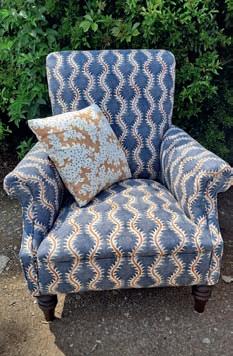
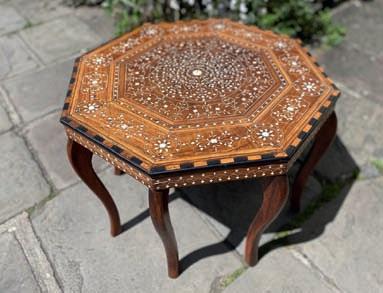

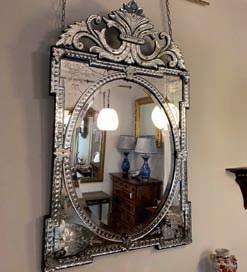


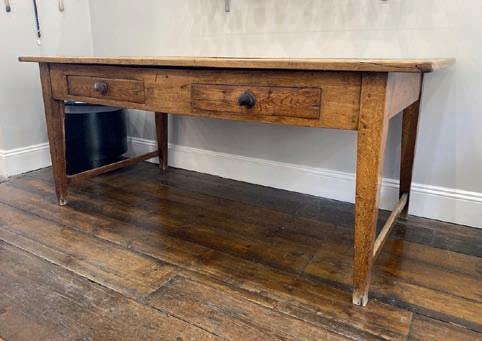



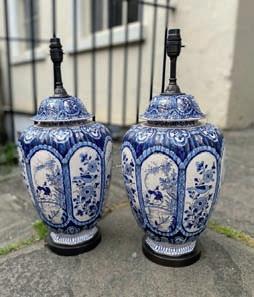
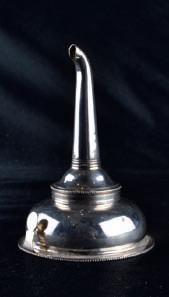


Bath offers a diverse variety of cultural delights. Melissa Blease explores the city’s very own public art museum dedicated to paintings, sculpture and decorative arts
The Victoria Art Gallery is one of Bath’s most loved cultural attractions and the most popular art gallery in the region with an outstanding collection of 1,500 decorative art treasures and paintings on permanent display
Since it opened its doors to the public in 1900, the gallery space within this subtly monumental Victorian building has become intrinsically woven into the fabric of day-to-day life in Bath, remaining as consistently popular with locals as it is with Heritage City visitors, some 160,000 of whom browse the gallery’s collections every year.
The airy, spacious two-storey building houses a huge collection of paintings, sketches, sculpture, artefacts and decorative art treasures dating from the 15th century all the way to the present day, showcasing all kinds of fascinating treasures from paintings by former Bath resident Thomas Gainsborough and lively satires on Georgian life in Bath by highly acclaimed Georgian

caricaturist Thomas Rowlandson to a pot by Turner Prize winning contemporary artist Grayson Perry, and a selection of World War I recruitment posters. Eclectic? Yes indeed – but in the most intelligently curated, enlightening way.
The gallery’s ground floor space hosts exhibitions that change on a regular basis (generally around every two months) for which an entrance fee is charged, while the permanent collection on the first floor is free to enter. The breathtakingly elegant marble hallway and grand staircase area that links the two floors could be described as a work of art in itself; once navigated, the upper-floor collection brings five centuries of European art together across two rooms in a gracious space flooded by natural light, offering an atmosphere of calm contemplation in which to browse, pause and generally enjoy the culturally enriching experience. It’s an experience for all ages to enjoy, too; families with children in tow are encouraged to immerse themselves in art here (little people love the ‘Art Cart’ available in the upper gallery, full of drawing materials and related activities such as interactive art trail suggestions to capture their attention) and the gallery is proud to be a Children’s University learning destination. Meanwhile, full disabled access and free talks for visually impaired visitors on selected Mondays throughout the year ensure accessibility to all.
There isn’t an on-site café but there are plenty to make full use of in the nearby vicinity before or after your visit, and a coinoperated drinks machine and chill-out zone can be found in the gallery’s Rotunda.
Before you leave, be sure to make time to visit the ground floor shop to browse a uniquely charming selection of books, arty gifts, postcards, greetings cards and collection/exhibition catalogues.
Today a Grade II* listed building, the Victoria Art Gallery’s original edifice was designed in 1897 by John McKean Brydon, a Scottish architect who developed a reputation for his expertise in designing public buildings including the St Peter’s Hospital in London’s Henrietta Street (Covent Garden) and Chelsea Public Library on London’s King’s Road.
In 1891, Brydon won a competition to enlarge Bath Guildhall – a project that forms a continuous building structure that includes the covered Guildhall Market, the Bath and North East Somerset Council chamber and the city’s Register Offices.

Built in 1900 to commemorate Queen Victoria’s diamond jubilee the Victoria Art Gallery offered a public library downstairs and a gallery upstairs, but was expanded in 1990 to house and display only works of art.
Work by painters including Thomas Gainsborough, Thomas Malton and Thomas Barker – all of whom have strong connections to Bath – offer a unique insight into the changing lives and landscapes of the people and places in and around the city of Bath through the ages.
Every year, the Victoria Art Gallery showcases work by the cream of the regional contemporary artistic talent, hosting the annual Bath Society of Artists exhibition and offering members of the public the opportunity to vote for their favourite artwork. The BSA was founded in 1904 and many distinguished painters including Patrick Heron, Mary Feddon, Howard Hodgkin and Walter Sickert have exhibited with the society.
In 2023, the Victoria Art Gallery hosted an exhibition with internationally renowned colour expert and fabric designerKaffe Fassett ( Timeless Themes ) and fellow American mosaic artist Candace Bahouth (Enchanted Visions) showcasing 23 of Kaffe’s large new quilts, following on from another shared exhibition in 2018, A Celebration of Flowers, which attracted 44,509 visitors.
Take a stroll around the Victoria Art Gallery’s exterior and you’ll find Anglo-Italian sculptor Andrea Carlo Lucchesi’s statue of Queen Victoria. There are also friezes of classical figures by fellow New Sculpturist George Anderson Lawson on either side. Inside, Grayson Perry’s Map of Days – purchased by the Art Fund and the Friends of the Victoria Art Gallery – is a fascinating portrayal of the inner working of the artist’s mind, interpreted as a walled city. A few steps away, the historic caricature collection offers a unique

perspective on the artistic interpretation of day-to-day life, putting the spotlight on the Georgian-era Bath social scene and often set against familiar Bath cityscapes such as the Assembly Rooms and the Pump Rooms.
Elsewhere, you are greeted in the entrance hall by local artist Sophie Ryder’s playful yet powerful bronze sculpture Lady Hare on a Dog, and don’t miss JW Turner’s haunting, dramatic West Front of Bath Abbey, the ethereal Adoration of the Magi (attributed to 15th-century painter Hugo van der Goes) and a wondrous, highly important portrait of Henry VIII, which has been dated to the mid16th century. Meanwhile, the eclectic array of British porcelain, delicate Georgian perfume bottles and tableware, Bohemian glass and pottery dogs in the gallery’s Decorative Art Collection offers an art gallery version of an Aladdin’s Cave.
Not sure which corner of the gallery to explore next? Regular Collection Highlight Tours and Art Store Tours offer visitors the opportunity to join a curator on guided strolls around the gallery’s permanent collection and/or behind the scenes – visit the website for full details and forthcoming dates. The guided tours are free.
Visit: The Victoria Art Gallery, Bridge Street, Bath BA2 4AT
Open Tuesday to Sunday from 10.30–5pm (closed 25, 26 Dec and 1 Jan)
Standard ticket price, adult: £10, student: £9, child age 6–18: £3.50
Web: victoriagal.org.uk
Tel: 01225 477233
Toulouse-Lautrec and the Masters of Montmartre 26 April –29 September
Discover the sights and sounds of Toulouse-Lautrec’s thrilling Bohemian Paris in this dazzling exhibition of works by Toulouse-Lautrec and the Masters of Montmartre.
With bright colours and bold lines, ToulouseLautrec's striking artwork captured the essence of turn-of-the-century Parisian nightlife. More than 30 pieces from his career, including his first poster of the Moulin Rouge and the cancan dancers of La Troupe de Mademoiselle Eglantine, will be shown alongside works by other celebrated artists of the day. Steinlein’s iconic Tournée du Chat Noir, an advert for Ruinart champagne by Alphonse Mucha and theatre posters by Jules Cheret will feature with eye-catching work by other masters of Belle Époque Paris.
Don’t miss the only chance to see Toulouse-Lautrec’s complete collection of posters exhibited together in the UK.
 Small Harbour Scene by Paul Klee (1879–1940)
© Victoria Art Gallery, Bath and North East Somerset Council
Small Harbour Scene by Paul Klee (1879–1940)
© Victoria Art Gallery, Bath and North East Somerset Council

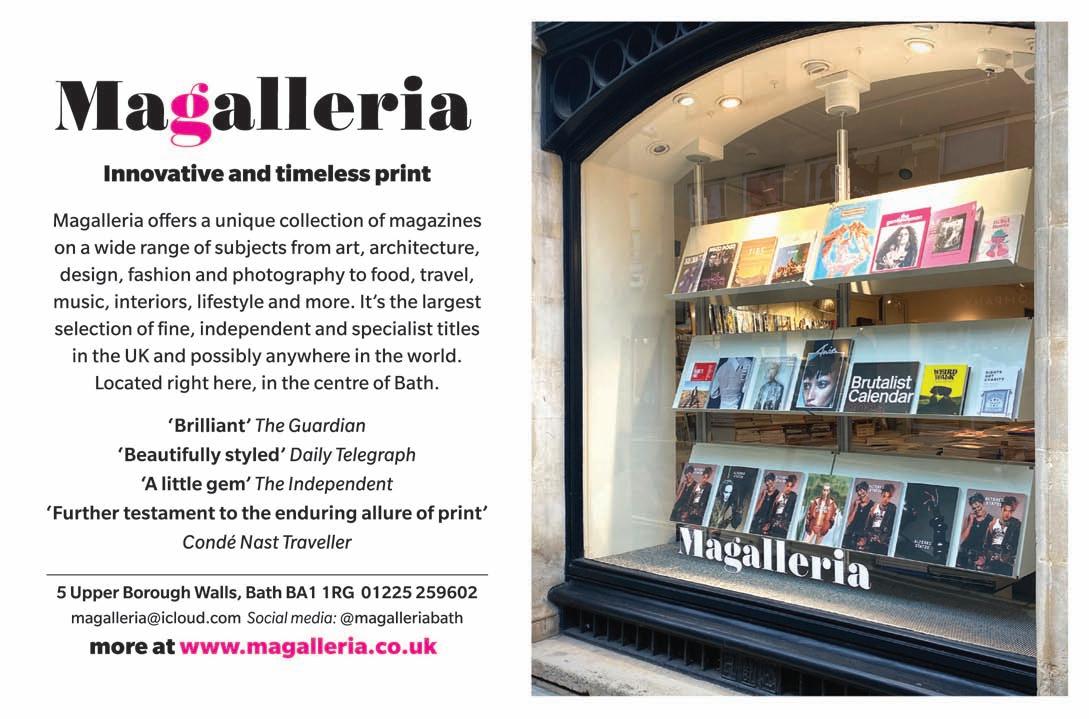
Bath can boast so many independent galleries as well as wonderfully talented working artists and craftspeople. We can choose to visit the galleries of contemporary artists who combine their studio with a gallery space or see high profile works and an eclectic range of craftwork from different makers, including jewellery, ceramics and art prints. Here are some of the places to visit for uplifting creative inspiration or for one-of-a-kind gift shopping

5, Cleveland Terrace, Bath BA1 5DF
Open Monday – Saturday 10.00am – 4.00pm Tel: 01225 427008 Web: penciltree.co.uk
12-13 York Street, Bath BA1 1NG
Open Monday – Saturday, 10am – 5pm and by appointment Tel: 01225 464850 Web: beauxartsbath.co.uk
Founded in 1979, Beaux Arts is the longest established commercial gallery in Bath, and is the sister gallery to Beaux Arts in Mayfair. The gallery specialises in the very best in contemporary painting, sculpture and studio ceramics. Works by well-known artists of the 20th century such as Dame Elisabeth Frink, Sir Terry Frost and Dame Lucie Rie rub shoulders with new luminaries like Nathan Ford, Helen Simmonds, Anna Gillespie and Akiko Hirai. Beaux Arts has a well-earned reputation for curating exciting exhibitions. Artists’ work is given plenty of wallspace and, with its high ceilings and numerous rooms to explore, the gallery is light, airy and an ideal environment in which to enjoy beautiful and thoughtprovoking works of art.
Pencil Tree is a contemporary art gallery selling original art, and limited edition giclée prints, by Paul Jackson. Paul's work is influenced by mid-century design and Californian surf culture. His large abstract pieces draw on the proportions, colours and style of the period.
The gallery is open 10-4pm Monday-Saturday, please call ahead if you're making a special visit.
For original paintings Pencil Tree is happy to bring a selection to your home, so you can be certain of your purchase.
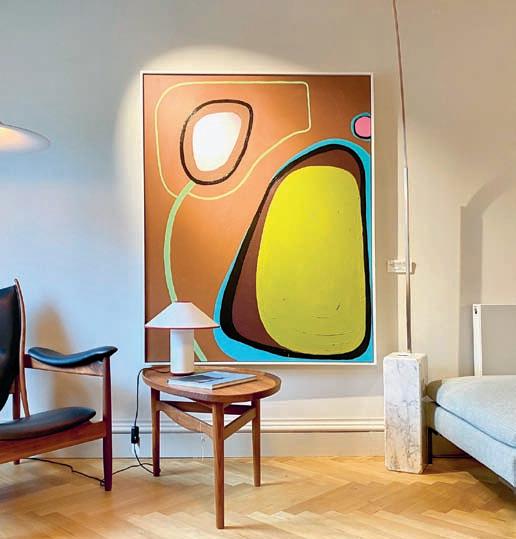
9B Margaret's Buildings, Bath BA1 2LP
Open Monday- Saturday 10am-5pm
Tel: 01225 319197
Web: galleryninebath.com
Founded in 2005, Gallery Nine’s current director Bo Collier whose gallery experience spans 30 years specialises in studio ceramics, jewellery, textiles paintings and original artists prints.
Pieces are selected for their quality, originality and craftsmanship. The gallery is frequented by collectors, tourists and local customers alike.
The gallery curates an exciting exhibition programme three times a year in spring, summer and at Christmas focusing on unique and affordable original British craft and contemporary works of art.
The gallery supports the future of it’s artists, established artists and wide ranging potential of emerging and new talents.
Gallery Nine can be found in Margaret Buildings , a charming Georgian street with independent shops and galleries.
by Louise Young Garnet


Every second Sunday of the month. 10am –5pm Web: bcaf.co.uk
Like Sunday mornings at the artist square in Montmartre Paris, step into a world of creativity and imagination at the award-winning Bath Contemporary Artists’ Fair (BCAF), where artistic expressions come to life in the heart of the historic city. From April-December, every 2nd Sunday, under the grand canopy of the historic station roof you can browse vast display of paintings, photography, sculpture and ceramics all for sale by talented artists from across the region and beyond. Since its creation in 2021 BCAF has supported over 2000 spaces to exhibiting artists! Make a day of it and enjoy the foodie treats to found at the station too.
14–15 Walcot Buildings, London Road, Bath BA1 6AD Tel: 01225 920210 Web: thebathpictureframer.co.uk
If you’re travelling in and out of the city along the London Road, you may well be distracted by the beautiful, stylish window displays at The Bath Framer. Owner Kelly has poured her enthusiasm and creativity into this friendly boutique picture framers that has a quirky, tastefully decorated front of house and an amazing naturally lit workshop. It’s a joy to visit for customers wanting to see how frames are created. Since opening, the business has gone from strength to strength, building a client list of local residents and businesses based in Bath, Bristol and beyond. The bespoke framing service is tailored to suit all individuals’ needs and you may well be tempted by the carefully selected range of gorgeous cards, gift wrap and stationery which perfectly reflect Kelly’s taste and eye for design - and check out these framed, super cool old bus route signs for a great treat to take home.

Melissa Blease gives us an introduction to the American Museum & Gardens at Claverton Manor
For more than 50 years, the American Museum & Gardens has attracted visitors from across the world to experience the impeccable reconstructions of the rooms of 19th-century American family homes, the vast collection of American decorative arts, crafts and textiles, the array of American Folk Art, and the captivating gardens. And Claverton Manor – the grand, imposing mansion in which the museum is based – has a fascinating history all of its own.
Early owners of the estate (dating back to the early 17th century) include British MP Sir Edward Hungerford (d.1607). Ralph Allen –postmaster, philanthropist and former owner of Bath stone quarries, from which most of Bath's most iconic, historic buildings were built – purchased the manor in 1758, restoring and rebuilding it, and creating a peaceful retreat away from the city centre. Although Allen spent most of his time at his Palladian-styled mansion at Prior Park, he visited Claverton regularly and established a tree-lined road that linked the two properties.
During the ownership of the Skrine family in 1897, the gardens were the venue for the first public speech by Winston Churchill; a plaque outside the main entrance marks this historic moment. In the years that followed, the house was the headquarters of an RAF
barrage balloon group during the Second World War and after the Bath Domestic Science College used the manor as a hall of residence until 1956.
The American Museum story itself begins in 1958 when British antiques dealer John Judkyn and the American psychiatrist and collector Dr Dallas Pratt (partners in both their personal and professional lives) purchased Claverton Manor and eventually turned it into a museum to celebrate American decorative arts and furniture.
With the help of furniture restorer Nick Bell Knight and Ian McCallum, who became the museum’s first director, the team worked tirelessly to transform the manor from a state of neardereliction while collecting artefacts and recreating period rooms from old American houses from centuries past, each carefully selected component (including panelling and floors shipped to Britain enabling period rooms to be painstakingly recreated in perfect detail) testifying to the artistry and history of American artisans and domestic life.
The American Museum & Gardens opened its doors to the public in 1961. Some 57 years later, the American Museum Gardens were transformed by Washington DC-based landscape gardeners Oehme, van Sweden, marking the company’s first UK commission. The £2m

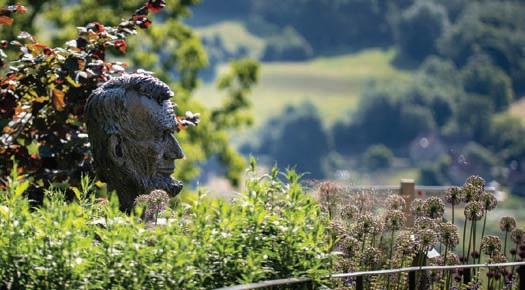
makeover and refurbishment was unveiled by gardener Alan Titchmarsh in 2018.
Today, the American Museum and Garden is home to many thousands of items that tell the story of the lives of American people from the earliest settlers all the way up to today both inside and out, while keeping the UK abreast with American contemporary culture.
This year a special exhibition celebrates an epic journey through the diversity of American landscapes, history and culture with a new family-friendly exhibition that’s forever American. With an immersive gallery of bill board posters and imagery, music and neonlighting effects; American Road Trip presents the origins and stories behind the cultural phenomenon and transports us on a journey of discovery across thousands of miles along Route 66 and beyond. Runs until 31 December 2024.
The American Museum’s permanent collection includes Dallas Pratt’s map collection (one of the great collections of Renaissance maps) and a dedicated Textile Room showcasing early examples of whole-cloth quilts (including Hawaiian and Amish pieces), appliqué work and a selection of Navajo and New Mexican weavings, rugs, coverlets and samplers. The American Folk Art Collection, meanwhile, is considered to be the greatest of its kind in Europe, featuring portraits, monumental sculptures and stunning carvings, while several immaculately recreated, evocative period room sets allow visitors to step back in time and experience domestic American history in wholly authentic detail.
Regular events at the American Museum include weekly pop-up talks and guided garden walks, live music s essions and barbecues. No visit to the American Museum, however, is complete without a refreshment pitstop to sample the authentic flavours of America whilst taking in the panoramic views across Limpley Stoke Valley in the American Garden Deli followed by a bout of retail therapy in the Gallery Shop.
The American Museum and Gardens, Claverton Manor, Claverton, Bath BA2 7BD
Tel: 01225 460503
Open: Tuesday-Sunday from mid-March to end of December, also Bank Holidays and Mondays during local school holidays. For specific opening times for different parts of the site, admission prices and accessibility details, visit the website.
Web: americanmuseum.org
Perched on an east-facing limestone bluff adjacent to the main building itself, The American Museum Gardens encapsulate the USA’s garden design revolution borne of trailblazing Washington DC-based landscape architects Wolfgang Oehme and James van Sweden (OvS).
OvS sought to rebuke the tyranny of the lawn and ‘foundational planting’ and instead to evoke the grandeur of the American prairies and introduce a new palette of plants. The 2.5-acre New American Gardens at the American Museum was opened in 2018 and offers visitors the unique opportunity to browse the designs that represent the OvS vision.
The design hinges on the circuitous Winding Way pathway that took inspiration from Thomas Jefferson’s Monticello and connects the gardens (including a children's garden), arboretum, house, exhibition space and café, with wheelchair and buggy-friendly access encouraging every visitor to see everything on offer, with the wilderness trail and surrounding parklands offering potential for further exploration.
Splashes of vibrant colour nestle in all the borders, native American fauna adds fascination, swathes of grasses and plumes whisper on the breeze and heavy-set blooms add depth and gravitas, alongside glorious panoramic views of the Limpley Stoke Valley and a turf amphitheatre nestling into the natural topography, used to host outdoor music and theatre events at the museum.
Six larger-than-life bust sculptures of key figures from American history are featured along the garden's pathways, including President Abraham Lincoln and Founding Father Alexander Hamilton, created by British sculptor Angela Conner.
The museum’s head gardener Andrew Cannell has made extensive changes to the Mount Vernon Garden, following new research into how President George Washington’s garden looked during his lifetime; the Parterre now features 2,100 Buxus microphylla ‘Herrenhausen’ plants laid out as an enormous fleur-de-lis, paying homage to the Marquis de Lafayette – a French aristocrat and military officer who led American troops in the Continental Army during the War of Independence, and who became a lifelong friend of Washington.

Jane Austen is one of Bath’s most famous former residents, but in her real life, as in her novels, she was aware of the contrast between the splendid and the seedy in the city, says associate professor in 18th and 19th century literature, Dr Felicity James
Adreary, rainy November afternoon in 1797. A carriage bumps over the wet streets, dodging rumbling carts and drays. The young women inside look at one another with eager excitement. Everything seems to promise pleasure, from the bawling of the newsmen, muffinmen and milkmen, to the chinking of pattens as ladies dash from shop to shop, clutching their bonnets against the rain. The carriage pulls up at Number One, Paragon Buildings. Jane Austen, 21 years old, had arrived in Bath.
Jane, Cassandra and their mother stayed with their wealthy relatives, the Leigh-Perrots, in Paragon Buildings, where their gouty uncle came every winter to take the waters. The city had special significance for the Austen family – Jane’s mother and father had met there and had married there. It came to have a role in Jane’s creative life, since both her first and last full-length novels were inspired by the city: Northanger Abbey , begun in 1797, and Persuasion in 1815. They feature very different heroines, but they both show Austen’s fascination with the social panorama Bath provided.
In Northanger Abbey the heroine Catherine expresses ‘eager delight’ on arriving in Bath – ‘her eyes were here, there, every where, as they approached its fine and striking environs’ – and she breathlessly visits all the tourist attractions. This reflects Austen’s own excitement in her early encounters with the city. Her letters to Cassandra about her adventures in Bath in 1799 are written in lively, sociable, holiday spirits, reporting to her sister on the latest fashions – would Cassandra prefer flowers or fruit as a decoration for her new hat? Jane used to attend evening entertainments, including a grand gala with music, illuminations and fireworks in Sydney Gardens. The concert promised to be tolerable – after all, she writes, tongue-in-cheek, ‘the Gardens are large enough for me to get pretty well beyond the reach of its sound’ – and the fireworks turned out to be ‘really beautiful’.
Moreover, the circulating libraries of Bath could feed the Austen sisters’ fondness for up-to-date books, shared by the heroine of Northanger Abbey . Catherine’s trips to the Pump Rooms, the Upper and Lower Rooms, and the baths are underscored by her addiction to the wild Gothic world of 1790s novels. ‘Yes, novels,’ exclaims Austen, ‘…in which the greatest powers of the mind are displayed’.
Austen had clearly also learned to read the dangerous side of
the city. As historian Peter Borsay points out, the Bath which appears in Northanger Abbey has two sides: ‘a place of potential and opportunity which nurtured good and evil alike’. In the 1987 BBC production grotesque socialites lurk in the Pump Room, bewigged and bonnetted, their wrinkles slathered over with rouge, while wicked seducers hover on the sidelines.
Andrew Davies’ delicate adaptation for ITV in 2007 shows a more romantic side of Bath, albeit with a dangerous undertow of flirtation. Candlelit, soft and rosy, it contrast s vividly with the dark, sexy horror of Catherine’s dream-life, inspired by Mrs Radcliffe’s romances. The innocent Felicity Jones floats along in pale muslin as Catherine. She looks, as Davies admits, ‘slightly too pretty for Catherine’, but amply brings out the eager happiness of this first encounter with Bath.
Northanger Abbey is a tale of teenage excitement, but Austen’s return to Bath as a setting for her later novel, Persuasion , is subtler, deeper and sadder. At 27, Anne Elliot has lost her bloom. Faded, ‘haggard’, she seems to have said goodbye to her hopes of marriage when she turned down her first suitor, Wentworth, faced with the disapproval of her snobbish family. Now, eight years on, Wentworth is back, prosperous, happy and successful. But he has not forgiven Anne, who had ‘used him ill’ – she has to watch silently as he flirts with the pretty young Musgrove girls.
This story of lost love and regret has long been linked to Austen herself – Jane was haunted by her own earlier love affairs –nostalgic memories which feed into Persuasion.
Anne’s dislike of Bath – uprooted from the country home she loves, forced by family circumstance into ‘something very opposite from her inclination’ – has als o been taken to be Austen’s own view. Although she enjoyed her visits to the city, moving there permanently, on her father’s retirement from the vicarage at Steventon, seems not to have appealed. Her sister-inlaw Mary Lloyd Austen reported that Jane was ‘greatly distressed’, and her great-nephew claims, ‘The shock of the intelligence was so great that she fainted away’.
She seems to have ceased writing during those years in Bath. Save one abortive effort, The Watsons, her creativity seems to have been put on hold from 1801 until 1809, when she moved with her mother and sister in a house on her brother’s estate in Chawton, Hampshire.
Jane’s six completed novels were all revised or written at Chawton – at her death, she was just coming into her prime as a
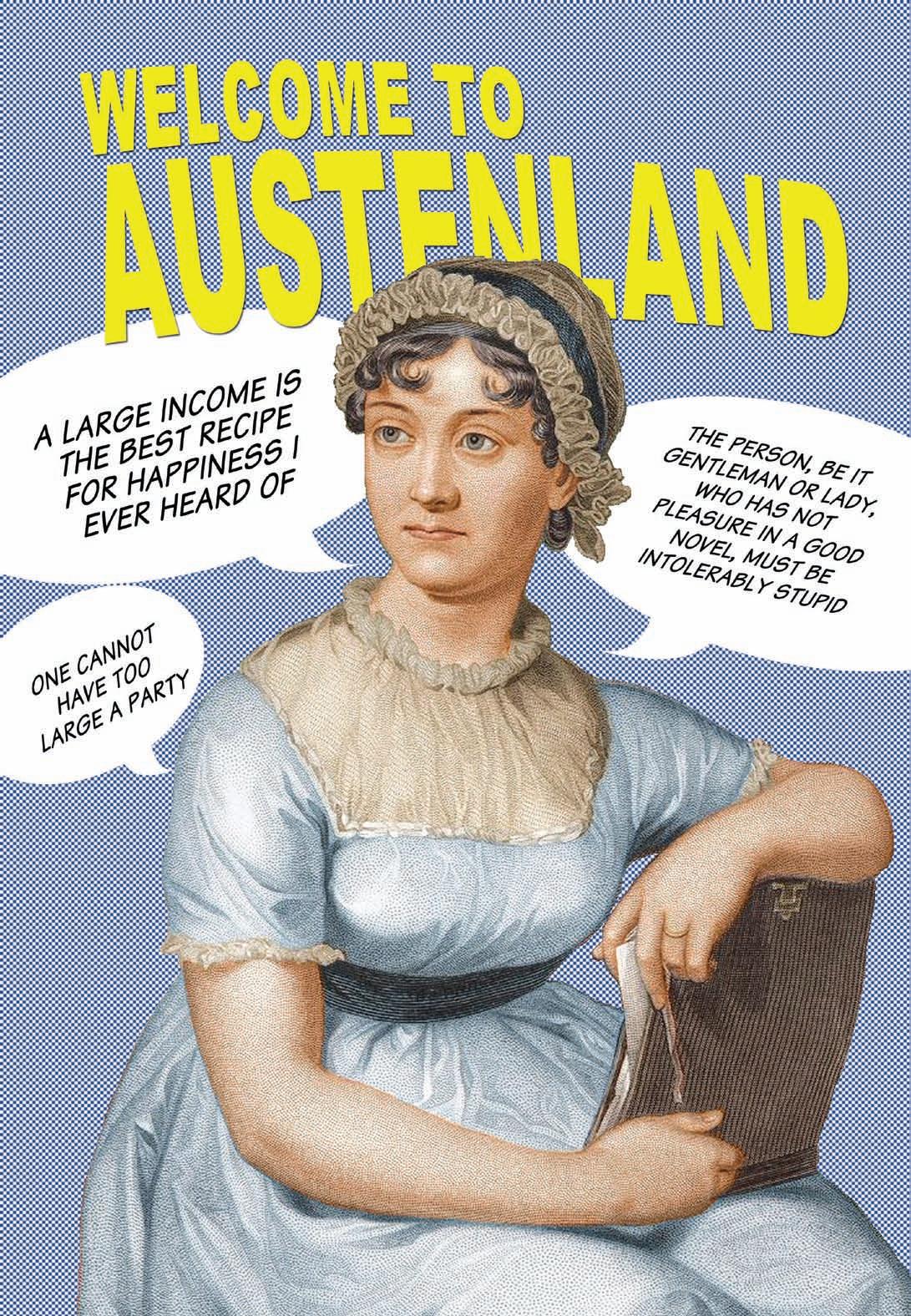
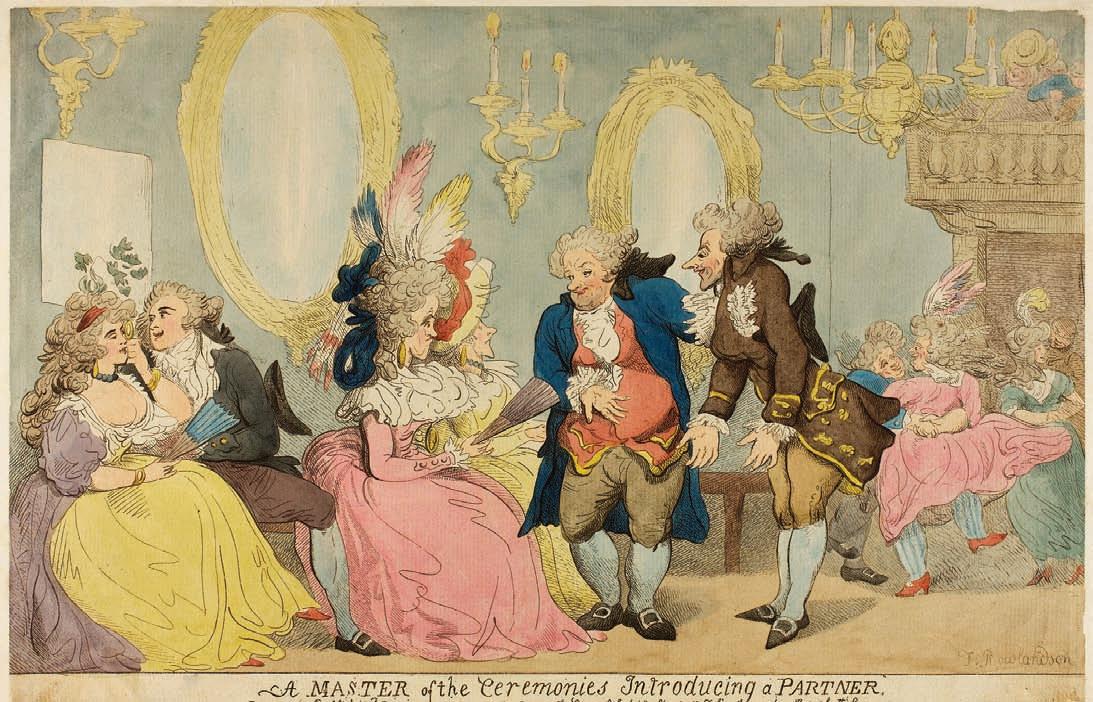
writer. Her masterpiece Emma took just over a year to write, from 1814 to 1815; Persuasion was written at a similar pace and finished in August 1816, and she had begun another novel, Sanditon, when she died. These last works, lively and experimental, tackle social transition and change much more openly than Austen’s previous novels. While Persuasion’s Captain Wentworth has made his fortune in the Napoleonic Wars, the titled Elliots have sunk into debt and have to leave their ancestral home to go and live in Bath.
Bath itself has also changed. When Austen visited in 1799, she had been happy to stay in Queen Square. But the Musgrove sisters in Persuasion, won’t settle for such a backwater. ‘We must be in a good situation,’ they tell their father, ‘none of your Queensquares for us!’
Other, more fashionable visitors had deserted the city altogether, in favour of new spa towns. Even in the 1790s, despite the lively social gatherings depicted in Northanger Abbey, the city was already sinking into decline as a fashionable destination.
By 1801, after the Austens’ move, Jane was reporting on the poor showing at the dances: ‘Think of four couples,’ she tells Cassandra, ‘surrounded by about a hundred people, dancing in the upper rooms at Bath!’
This view of Bath is seconded by Anne Elliot, who shies away from what she terms the ‘littlenesses’ of the town, its petty snobberies and vanities. Her father delights in courting titled acquaintances, and expressing his disdain for his fellow spagoers. He is inordinately proud of his rented house in Camden Place – showy and expensive, but built on unstable ground which meant that the upper crescent could never be completed. It’s the
perfect symbol for his superficial vanity. Anne, on the other hand, seeks out the less fortunate, spending her time in the cramped rooms of her invalid friend, and persisting in her ‘disinclination for Bath’.
But it is Bath that finally allows Anne her happy ending. Here she meets Captain Wentworth once again. In an apartment at the Whit e Hart, he pens his declaration of love, and in the ‘comparatively quiet and retired gravel-walk’, between Queen Square and the Royal Crescent, they finally share their feelings, looking only at each other, ‘seeing neither sauntering politicians, bustling house-keepers, flirting girls, nor nursery-maids and children’. Perhaps this is a clue to Austen’s own view of the city. While she takes a sceptical l ook at its sauntering, flirting bustle, she finds a place for her romance within it.
Bath prompted her earliest novel, and inspired her as a mature writer – it produced a sparkling comedy and a story of love and loss. From irrepressible flirts and Gothic villains, to the heartfelt love of Anne and Wentworth, the city was a lifelong source of inspiration for Jane Austen.
Visit the Jane Austen Centre in Bath for a snapshot of life during Regency times and explore how living in the city affected Jane Austen and her writing.
Jane Austen Centre, 40 Gay Street, Bath
Tel: 01225 443000
Web: janeausten.co.uk
Situated on Bath’s historic Pulteney Bridge, Nigel Dando began his career after he gained national Goldsmiths Diploma before going on study gemmology at the Sir John Cass College of Art, Whitechapel.
Today he sells an eclectic mix of new, pre-owned and vintage jewellery and has a particular interest in pieces from the 1920-1960 era together with ranges of contemporary silver jewellery at affordable prices, many of which are one-off pieces, the emphasis being on quality and style.
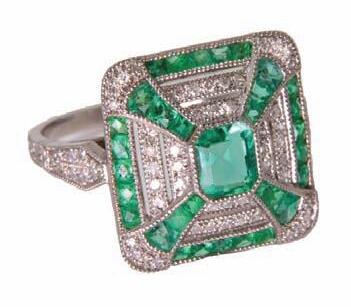
Another facet of the business is the buying of gold and silver items in any form or condition. Nigel also sells investment precious metals at what he believes to be the most competitive prices in the city. Being one of the few provincial members of The London Diamond Bourse, Nigel is in daily contact with the market. which enables him to offer undeniable expertise and value. He also offers a valuation service.
11 Pulteney Bridge | Bath | BA2 4AY | Tel: 01225 464013
Wednesday-Friday: 10.30am-4.30pm. Saturday: Occasionally or by appointment 10am -1pm
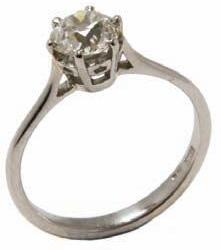












To experience the best of the afternoon tea tradition, why not indulge yourself with a trip to one of Bath’s finest hotels or visit one of the quaint tearooms?
Beau Street, Bath BA1 1QY
Tel: 01225 358888 Web: thegainsboroughbathspa.co.uk
What could epitomise ‘the Bath experience’ more perfectly than taking an afternoon tea in the classic, yet irrefutably modern Gainsborough Bath Spa Hotel? This is an experience for both locals and visitors. Your traditional afternoon tea will be served in the glamorous atmosphere of the fashionable Canvas Room, where you can sit, chat and enjoy the stylish surroundings.
The delectable selection of sandwiches, scones, cakes and refreshments comes with the additional option of Champagne if you wish to make your experience that little bit more indulgent. Afternoon tea at The Gainsborough is £38 per person, or £56 with a glass of Champagne, and is served every day from 3 – 5.00pm. Booking is essential.

39 Milsom Street, Bath BA1 1DS
Tel: 01225 307100 Web: theivybathbrasserie.com
A fashionable and sociable affair, The Ivy Afternoon Tea is the perfect mid-afternoon treat. Enjoy freshly baked scones, finger sandwiches, and exquisite cakes and tarts crafted with the finest ingredients. There’s fresh takes on classic sandwiches, including The Ivy 1917 Cure, smoked salmon and cream cheese finger sandwich, a sumptuous grilled chicken and truffle mayonnaise brioche roll and a pickled cucumber, courgette and basil double decker. For the sweets; a fun garden planter chocolate pot, a beautiful floral passion fruit choux puff and a blossom red velvet cupcake are followed by a refreshing Meadow green juice. Finally, no afternoon tea would be complete without warm fruited scones served with clotted cream, preserve and fresh strawberries. £29.95 includes a choice of teas or add a glass of Champagne for £39.95.

16 Royal Crescent, Bath BA1 2LS
Tel: 01225 823333 Web: royalcrescent.co.uk
Relax in the beautiful location of the iconic Royal Crescent Hotel & Spa and catch up with friends over a chilled glass of Champagne and a delectable selection of scones and sandwiches.
The hotel’s unique choice of three afternoon teas include beautiful finger sandwiches, delicate cakes and savouries, the finest world teas and some of Bath’s best scones and buns.
This most decadent of British traditions is complemented by the option of adding some sparkle to the occasion with a flute or flight of Taittinger Champagne. Afternoon Teas, (including a dedicated Children’s Afternoon Tea) are served daily between 1.00pm and 4.00pm in the new Montagu's Mews’ bar, restaurant and dining terrace –or on a warm day in the glorious garden. £45 per person or £22 per child.

The idea of afternoon tea was introduced to England by Anna, the seventh Duchess of Bedford, in 1840. The Duchess would start to feel hungry around four o’clock in the afternoon, but the evening meal in her household was served fashionably late at eight o’clock, leaving a long period of time between lunch and dinner. The Duchess asked that a tray of tea, bread and butter (the latter a relatively new innovation by the Earl of Sandwich which involved putting a filling between two slices of bread) and cake to be brought to her room in the late afternoon. This became a habit and she began inviting friends to join her.
There are few hours in life more agreeable than the hour dedicated to the ceremony known as afternoon tea
– HENRY JAMES –
This pause for tea evolved into a fashionable social event. Soon the upper classes and society women would change into long gowns and put on gloves and hats for their afternoon tea which was usually served between four and five o’clock in the drawing room, or in the garden on a warm, sunny day.
Traditional afternoon tea consists of a selection of dainty sandwiches (thinly sliced cucumber sandwiches should always be included) and scones served with clotted cream and preserves as well as a selection of cakes and pastries. Tea grown in India or Ceylon is poured from silver tea pots into delicate bone china cups.

North Parade, Bath BA1 1LF
Tel: 01225 461603 Web: abbeyteabar.com
Whether seeking a moment of relaxation or a sophisticated social gathering, The Abbey Tea Bar promises an experience like no other. Combining the timeless elegance of the Abbey hotel with the exceptional quality of the Hope and Glory 100% organic, awardwinning tea brand, The Abbey Tea Bar promises a unique and unforgettable experience for tea enthusiasts and connoisseurs alike. Guests can enjoy the opportunity to indulge in a curated selection of premium teas - sourced from the finest tea estates around the world - to partner with a delectable slice of cake or a tasty sandwich or two. The full afternoon tea experience makes a wonderful occasion, priced at £30, it offers a selection of finger sandwiches, warm scones (served with preserves and clotted cream) and a delightful selection of mini cakes. Open daily from 11am – 5.30pm, with an evening menu served from 5.30pm – 9pm The Abbey Tea Bar invites guests to embark on a journey of discovery through the world of fine tea.
Colerne SN14 8AZ
Tel: 01225 742777 Web: lucknampark.co.uk
Indulge in a traditional English afternoon tea at this 18th-century mansion set in 500 acres of magnificent gardens and parkland. Tea at Lucknam Park is a firm favourite, whether it’s for a special occasion or a treat after shopping in Bath, which is only six miles away. You will be able to escape the city and enjoy a full English afternoon tea from £48 per person, (£68 with a glass of Joseph Perrier Champagne) served in the library or drawing room overlooking the gardens, or on the terrace on a warm day. Afternoon tea is available Monday to Sunday 1.30 –3pm, Reservations are recommended.
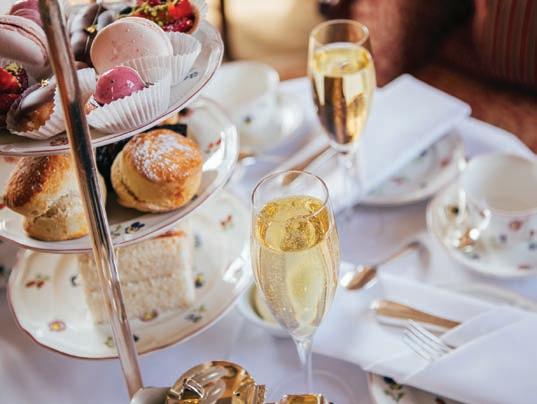
Refined but welcoming; genteel but with a polished background buzz of conviviality – no visit to Bath would be complete without a visit to the Pump Room. Melissa Blease explores this exclusive comfort stop
If a tour of the Roman Baths complex is integral to your discovery of Bath, a refreshment break at the Pump Room (under the same roof) is equally unforgettable. It’s possible, however, to indulge your senses in this elegant, neo-classical salon as a stand-alone, relaxing refuelling zone – as indeed, many Bath locals do, maintaining a Heritage City tradition that began more than two centuries ago.
This bastion of good taste has offered a civilised backdrop to all manner of social intercourse events since 1799. Opening early for breakfast, morning coffee and brunch before afternoon tea (a nd evening dinner during the summer months), the atmosphere is defined by the exquisitely dignified surroundings with sparkling chandeliers, Corinthian columns and tables adorned with crisp linen and gleaming tableware. Once at your table, polite, efficient staff cater to your every whim, while the Pump Room trio or a pianist provide elegant musical accompaniment. It’s a room with a view, too – either a cross the Roman Baths from the windows towards the rear of the salon, or over Abbey Square from tables towards the front of the building.

The thirst for ‘partaking of’ the thermal waters of Bath – once believed to offer healing properties – became so popular during the late 17th century that a pump was installed to allow public access water sourced directly from the spring. In the early 18th cent ury, British physician and philanthropist William Oliver persuaded the Bath Corporation to erect buildings where the drinkers could be sheltered – a popular initiative that included the main Pump Room and the Hetling Pump Room, today the location of the Thermae Bath Spa Visitor Shop.
As the popularity of Bath as a spa destination grew, the Pump Room could no longer accommodate the scores of people keen t o drink the water, so multiple extensions and improvements were made to the building.
Along with the Lower Assembly Rooms and Sydney Gardens and hotel, The Pump Room eventually completed the triangle of locations that drew Georgian ‘high society’. The original Pump Room building was designed by John Harvey to specifications requested by Bath’s Master of Ceremonies Beau Nash in 1706, before the discovery of the Roman remains. The foundations of the Roman temple precinct were discovered during preparatory excavations for designs by Thomas Baldwin who took the project over from John Harvey, but whose designs were also never completed. When Baldwin was declared bankrupt in 1793, his long-time rival (and official city architect) John Palmer continued the scheme to his own plans. The Pump Room was opened to t he public by the Duchess of York in 1795 and finished in 1799.
Live music has been performed here since the opening of the original building in 1706, a tradition upheld by the highly acclaimed Pump Room Trio (the longest established resident ensemble in Europe) today, while the original Pump Room Orchestra is believed to be the first resident band in the country to play in an assembly room. When Baroque composer Handel visited Bath in 1749, he collaborated with Bath-born composer and organist Thomas Chilcot in support of the Pump Room band, English tenor and musician Thomas Linley and astrologer/ composer William Herschel both played in the band during the 1760s, and Gustav Holst was a guest conductor during the early 20th century. The Pump Room became a restaurant during the Second World War, and escaped destruction during the Baedeker Air Raids on Bath in 1942.
Historical figures who have visited To take the waters include Jane Austen (who used the backdrop as a setting for key scenes in



both Northanger Abbey and Persuasion), Charles Dickens (whose iconic character Mr Pickwick in his first novel The Pickwick Papers, published in 1836, was urged to take the waters by his faithful servant Sam Weller), American showman Buffalo Bill and the Ethiopian Emperor Haile Selassie, who spent his exile in Bath between 1936–41.
Morning Bakery, Brunch (and Sparkling Bucks Fizz Brunch) are served in the Pump Room from 10-11.30am, but it’s Afternoon Tea at the Pump Room (always accompanied by live music courtesy of a resident pianist or the famous Pump Room Trio) that’s not to be missed –there are three sittings: 12-1.30pm, 23.30pm or 4-5.30pm.
It’s possible, of course, to simply order a pot of tea and a freshly baked scone and leave refreshed, fulfilled and relaxed. But if you choose to elevate your perspective of afternoon delights to the next level, you’ve most definitely come to the right place; expect to encounter a thoughtful collection of freshly prepared sweet and savoury treats together on one (or possibly several) multi-tiered presentation stands, to be served on exquisite fine bone china. A selection of loose leaf teas or hand-roasted coffee comes as standard and can be refille d as many times as you wish. Searcy’s – the catering company hard at work behind the scenes here are also renowned for their incredible range of Champagnes.
It’s possible, too, to take a free sample of the mineral-rich spa water on which the city’s original foundations were built, freshly drawn by a ‘pumper’ from an ornate fountain at the epicentre of the dining room – but be warned: it’s an acquired taste.
The Pump Room, Abbey Church Yard, Bath BA1 1LZ
Open daily (closed 25 and 26 Dec). Morning bakery and brunch, Afternoon Tea, and Summer Evening Dining (See website for times)
Book a table online or tel: 01225 444477 Walk-in tables are available daily
Web: thepumproombath.co.uk
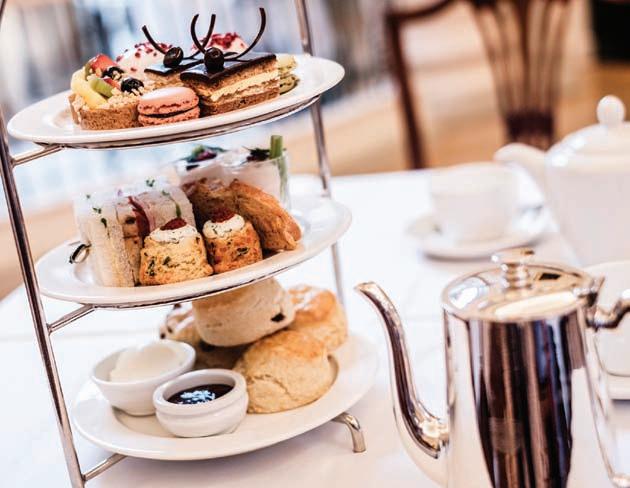

Singer and guitarist Steve Robinson has been busking in Bath for 36 years. Simon Horsford asks him about his musical influences, his playing history and his connections to Bath... and to LA.
Music is in Steve Robinson’s DNA. The singer/ guitarist has spent his life playing on stage, in studios, or on the street and his distinctive gravelly voice and mop of dark grey hair have made him a familiar sight in Bath where he has busked for 36 years.
We arranged to meet in a coffee shop near his regular pitch at the bottom of Milsom Street and when I told the barista, she said “Oh, I know him, he’s great.” Robinson has that effect on people; the local shops and cafés often keep an eye on his guitar and amp when he takes a break – like now as he orders a cup of tea.
“I love performing, and busking is the best form of free advertising,” the Doncaster-born musician tells me. He dates his relationship with Bath back to one night in 1988 after playing a gig at the now defunct Moles club with his then band Over The Moon. “It was 2am and we were all stood on the wall overlooking Pulteney Weir, seeing the lights, and I looked at the lads, there were five of us, and I said, ‘I don’t know about you but I’m staying here.’” And that’s what he’s done ever since – getting married and raising two children.
“I come from a family of musicians,” says Robinson, who was born in 1963. “My dad was a singer and guitarist and had a few singles in the sixties under the name Billy Fontaine. My mum was also a singer and did big band stuff. When we moved to Durham, at that time there was the shipyards, coal mines and steelworks and they could get work five or six nights a week at working men’s clubs.”
Back then, these were “tough gigs”, but it was a vibrant music scene. “I started learning the guitar and playing in clubs aged 14. One of my brothers was a drummer and another a guitarist. With the elder one, we’d go and play gigs as a duo. We’d do three clubs in an evening, playing what was in the charts, 20 minutes in each and someone would collect money in a hat and then we’d go back to school on the Monday. My mum and dad also ran a b&b for visiting musicians so I was in my element when they started getting their guitars out and jamming. It was a great upbringing.”
Robinson moved to Hartlepool and started to work for agencies, playing up and down the country and in Europe. He later played in bars in Spain, learning around 150 songs. It was also the period that he was in Over The Moon, playing guitar and doing some vocals. The Bath link came about via the band’s drummer, who at the time [1986] was working in the city as assistant engineer on Peter Gabriel’s So album. “With Peter Gabriel having a voice like 240 grit sandpaper, he was my favourite singer. Anyone like that – Rod Stewart, who had a growly, gritty voice – I was hooked on to them.” The south-west connection led to interest in the band from a Bristol-based
management company and the subsequent gig at Moles.
From then on Robinson has never looked back. “I felt something [down here], an energy. There were lots of musicians. There was Tears For Fears and in Bristol you had bands like Massive Attack and Portishead. We signed to a small label and made an album but it bombed. The rest of the guys got a bit despondent so we went our separate ways [although they did play Glastonbury in 1989 ‘when there were only six stages and I had my name on the t-shirt’]. I stayed with the same management company and became a session player for people. I would play guitar, sing and do harmonies and worked with the Korgis and Andy Cresswell Davis, who’d been in the Korgis and Stackridge.” Robinson then “got lucky” with an introduction to Innes Sibun. “He’d played with Robert Plant and was a blistering guitar player and a great songwriter. I was the front man on five albums, touring Europe and playing gigs in the US with the band.”
He now blends session work with busking, the occasional gig with a band called the Lost Wailers and voice-overs for TV commercials. Robinson then throws a curve ball by telling me he also busks in the US. “I went to Los Angeles 22 years ago with my wife on holiday as she used to live there and saw people playing on the streets and thought we should come back next year. I managed to get on a street fair called Surf City Nights in Huntingdon [down the coast from LA] and they’ve invited me back every July and August ever since. I also play at the Beverly Hills farmers’ market and sometimes in Santa Monica.” It’s quite the double-header: Bath and LA.
When Robinson started in Bath there were just four buskers in the city. Now around 20 share the various select spots (not all at the same time), meeting as is traditional at 10am each morning in the Abbey Churchyard to see who plays where,“It’s all very democratic”. Each set lasts 40 minutes or an hour; Robinson will do three sets on Thursday through Sunday, but not during winter (except during the Christmas market) and hopes there is no rain, wind or roadworks.
Robinson says ever since he’s started performing, he’s always believed in giving his all, “you can’t just use [the stage or street] as a rehearsal place”, and that he “feels the vibe” before deciding what to play. Favourites include Wichita Lineman [the Glen Campbell song was one of the first he learned], Solsbury Hill [Peter Gabriel] and Crowded House’s Weather With You. He does do requests but people are usually reluctant to stop him in full flow and he draws the line at singing hackneyed numbers such as Wonderwall and Sweet Caroline. Robinson clearly loves playing live and I leave him strumming his trusty 1993 Takamine guitar giving an evocative rendition of Elton John’s Rocket Man and think how fortunate it is for Bath that he decided to put his roots down in the city.
Laden with historic legend and offering a gracefully therapeutic experience today, Bath's hot springs are a buoyant natural resource, unique in the UK. Melissa Blease dives into the Thermae Bath Spa
Over the centuries, Bath has been built and developed around the natural, geothermally heated, mineral-rich springs that flow beneath the city’s historical Roman remains. Today, the Thermae Bath Spa – which opened its doors to the public in 2006 –enjoys superstar status at the epicentre of modern-day life in the city, reintroducing the ancient customs of spa culture to locals and visitors alike.
The Ther mae Bath Spa brings together two grand baths, a rooftop pool, a wellness suite, a stand-alone pool on a sacred site,
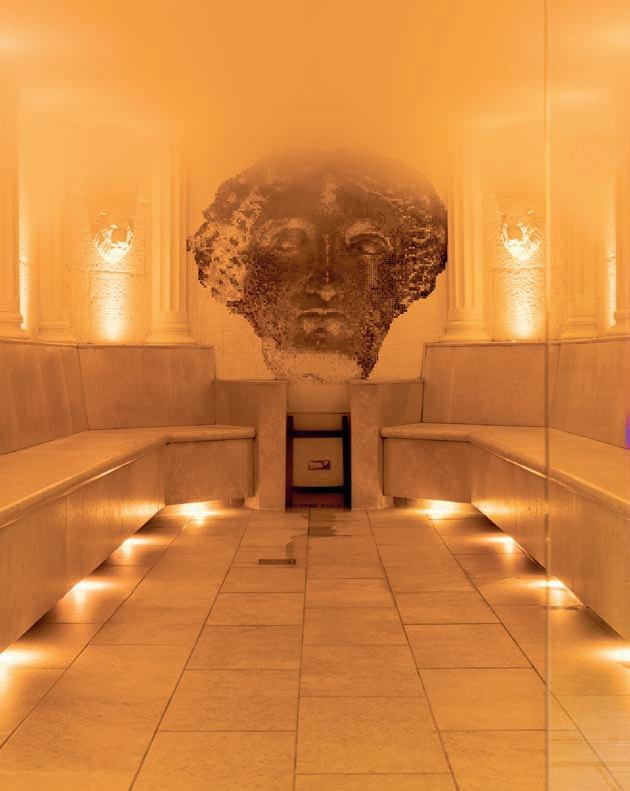
a café, a visitor centre and a shop. This is a sleekly designed complex where spa facilities and state-of-the-art design flourish together against a ‘uniquely Bath’ backdrop. The Spa offers a memorable, relaxing experience for water babies, those in need of refuge from the stresses and strains of modern life and grand design enthusiasts.
The Thermae Bath Spa neither detracts from nor dominates its surroundings; even though the main building is largely wrapped in stainless steel and multiple sheets of glass, the height and scale pay subtle, respectful homage to the surrounding structures.
Although it tops the ‘Must Do’ list for around 290,000 visitors every year, the Thermae Bath Spa attracts locals as well as tourists. The clever layout encourages visitors to wander freely from space to space, so it’s always possible to find yourself a quiet, secluded oasis of blissful tranquility.
A standard two-hour spa session allows you to experience the Thermae Bath Spa at your own pace: make a gentle splash in the glamorous Minerva Bath (the largest of the baths), relax in the multi-sen sory Wellness Suite and float around the spectacular Rooftop Pool, which offers breathtaking views over the city and is naturally warm and steamy at any hour of the day or night.
If you fancy a refreshment break, don’t worry about revisiting your locker for your wallet; purchases at the Springs Café are charged to your TBS SmartBand and paid for on exit. The extensive Spa Treatment menu (which must be b ooked at the same time as a standard spa session) offers around 20 treatments and therapies, ranging from traditional or hot stone massage to pampering face and body treatments. The Thermae Bath Spa’s array of signature treatments includes the exotic Frangipani Delight exfoliation ritual to nourish and cocoon the body in moisture, while buffing the skin to reveal a radiant, renewed glow and harmonised mi nd. Then there is the Inner Peace Massage, the perfect experience for those looking to enjoy some self-care, with a guided inhalation, a relaxing back massage and soothing mud mask on the feet. There are also tempting treatment options for mums-to-be and couples.
Want a quick fix? Pop into the Cross Bath – an intimate, standalone facility with its own open-air thermal bath – for a 90-minute session, and experience instant nirvana.
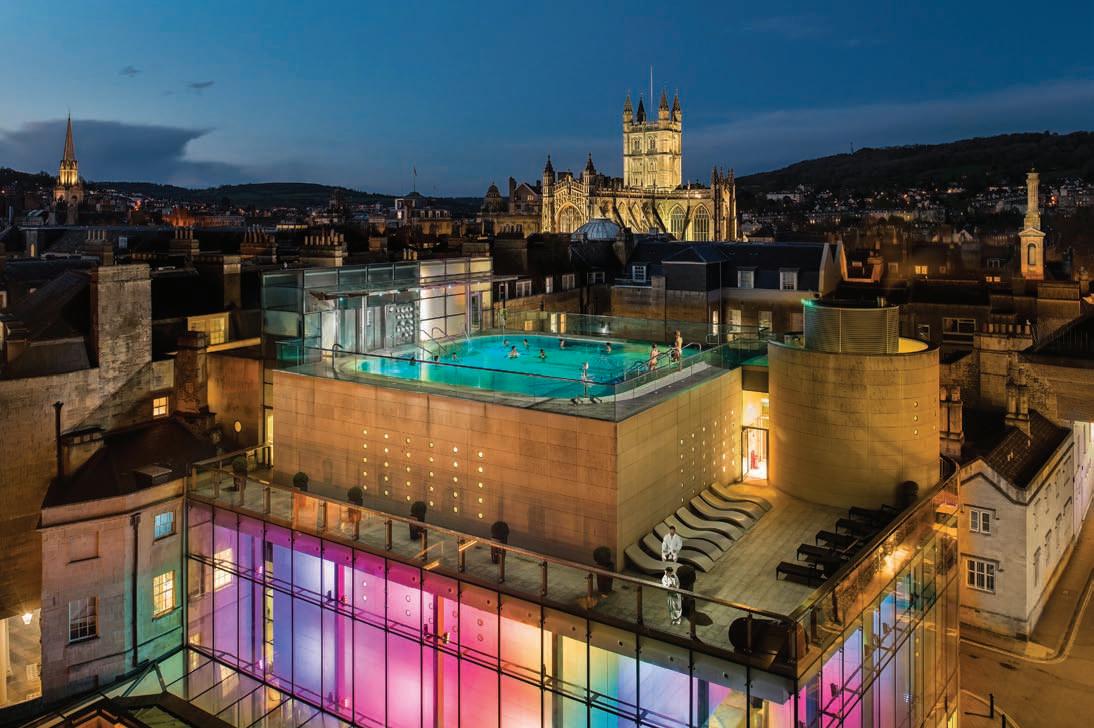
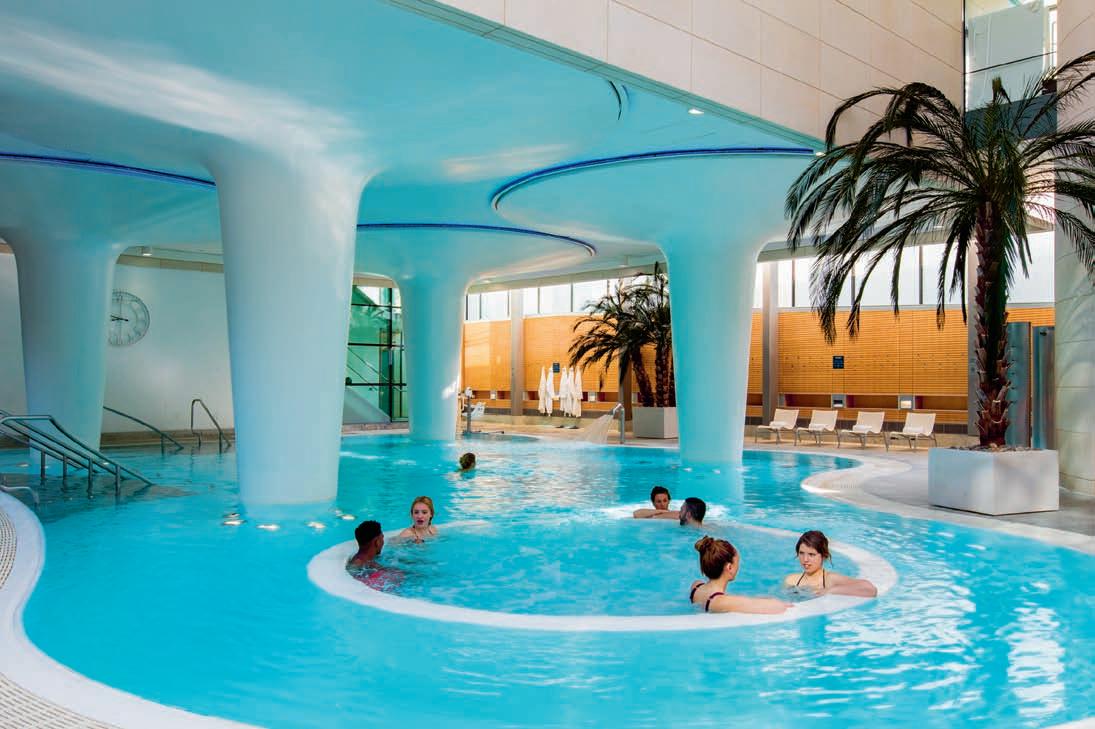
In 1995 Bath and North East Somerset Council applied to the National Lottery for new project funding to regenerate Bath’s reputation as a modern-day spa destination. Two years later, the Millennium Commission granted the Bath Spa Project £7.78m to restore five historic buildings including the 18th-century Hot Bath, the ancient Cross Bath and the New Royal Bath: the stunning g lass and stone edifice designed by internationally acclaimed architects Sir Nicholas Grimshaw and Partners, today housing the main spa complex.
Until the spa restoration was completed in 2006, the thermal waters that flowed from the springs, which naturally contain over 42 minerals and trace elements, was rerouted to pour into the River Avon. Today, over one million litres of this natural resource is use d in the Thermae Bath Spa.
The Hot Bath (a Grade II* listed building) dates from 1777, designed by architect John Wood the Younger. The Cross Bath enjoys designated Sacred Site status within the World Wildlife Fund for Nature’s Sacred Land Project. The original site and
water source has origins that date back to a time and place before any form of records were kept, but he structure that surrounds the C ross Bath was rebuilt by 18th-century architect to the City of Bath John Palmer and his predecessor Thomas Baldwin in 1789 on the site of a medieval bath and on the original more than 2,000-year-old Roman Cistern.
Visit: Thermae Bath Spa, Hot Bath Street, Bath BA1 1SJ
Open daily from 9am –9.30pm, excluding Christmas Day, Boxing Day and New Year’s Day. Christmas Eve and New Year’s Eve opening times are 9am–8pm.
Standard two-hour session £41 (weekday), £46 (weekend), includes use of towel, robe.
See web for special packages and add-on treatments
Web: thermaebathspa.com
Tel: 01225 331234
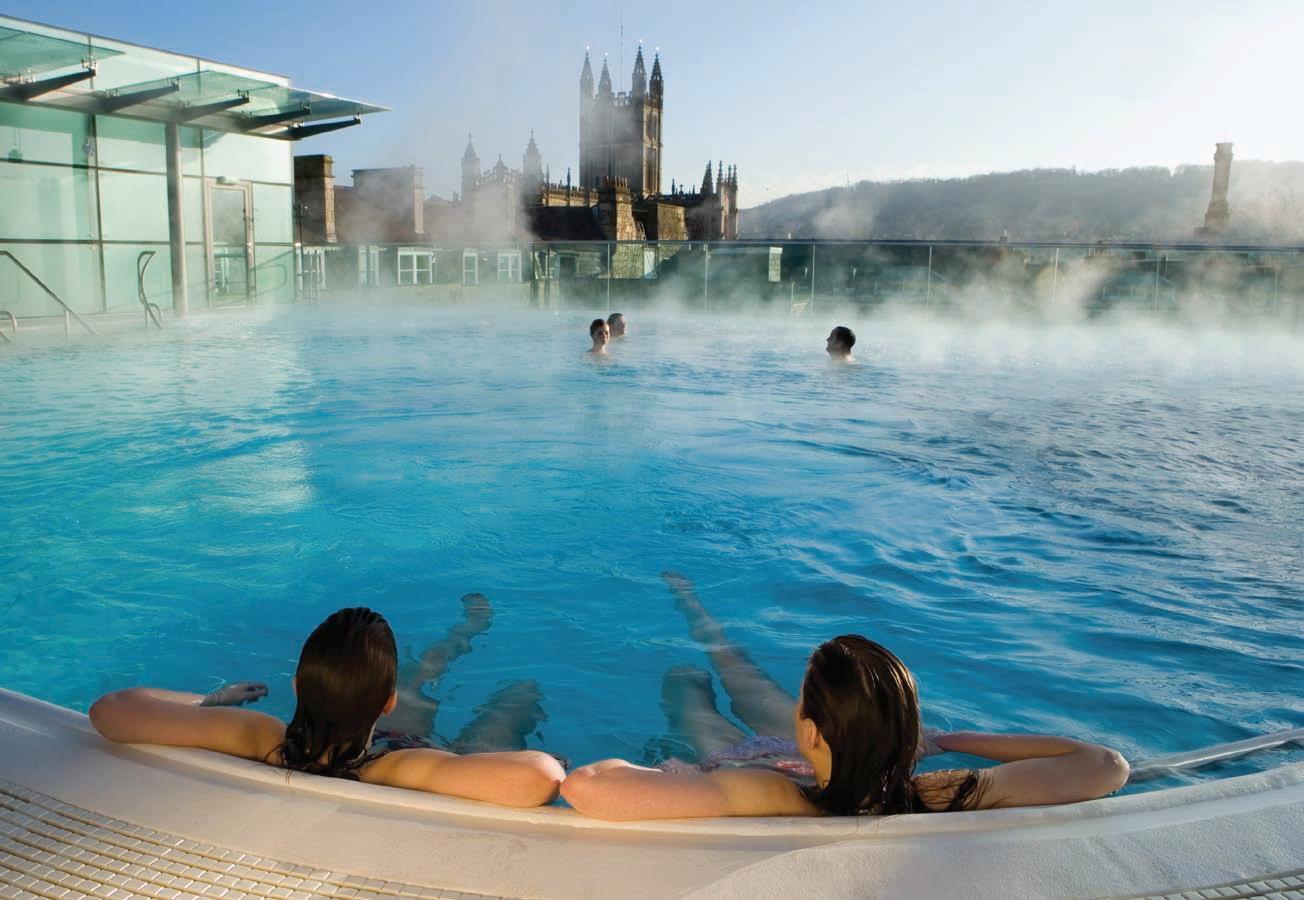



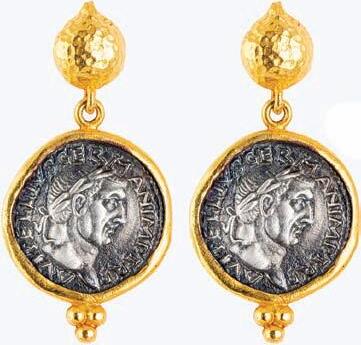
Icarus Jewellery is an independent silver jewellery shop located in the heart of Bath, on Pulteney Bridge and offers a great selection of handmade unique designs from their store and online shop.
Icarus Jewellery has recently released the Icarus Gift Card which can be purchased on their website. The boutique also offers UK and international shipping.

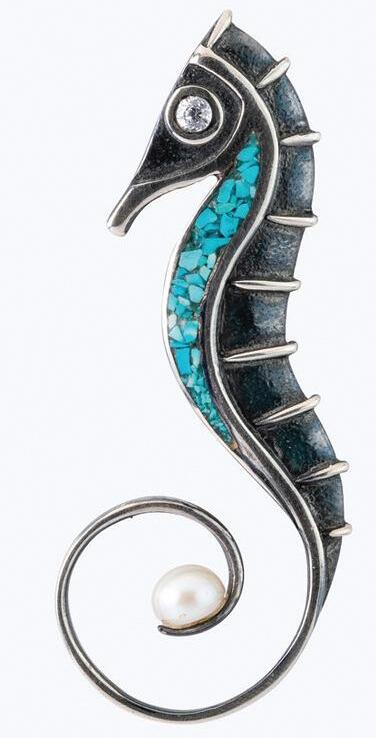
















Salt water plunges, vitamin-enriched facials, pedicures, saunas and steam rooms. Crystal Rose rounds up a few favourite places for a good pampering session
Bath’s spa scene is stacked with world-class pampering possibilities. From the UK’s only geo-thermically heated pool to VIP treatments at first class hotels, the city certainly has a lot to offer. With so many choices, Bath is the perfect place to relax and unwind. Whether you’re visiting for a special occasion or to simply tick it off the must-do list, you won’t find these facilities anywhere else. Book in, turn up and switch off.
There are hydro-spa beds, dual treatment rooms, social lounges, sensory and wellbeing experiences to soothe as well as invigorate. And, if that’s not good enough, how about full use of the fitness facilities, a beauty treatment or timetabled exercise classes? There’s something for everyone, whatever your heart desires and your body craves.
Grab your robe and slippers and dip a toe into our little spa round-up of the best places around. You may be spoilt for choice, but we promise you won’t be disappointed. After all, you have just landed in the city of spas. Enjoy.
Beau Street, Bath BA1 1QY Web: thegainsboroughbathspa.co.uk

James Street West, Bath BA1 2DA Web: apexhotels.co.uk
If it’s heated beds and a pool with a beautiful waterfall feature you’re wishing for then look no further. The Apex City of Bath Hotel offers an oasis of calm in the city. Expect warm ambient temperatures, a relaxing atmosphere and aromatherapy dosing systems, which allow essential oils to be infused into the shower area.
There’s a steam room, sauna and shower experience all situated around the pool area. Look out for the cold bucket treatment that’s designed to rejuventate and reinvigorate tired bodies.
What’s more, you can also head to the state-of-the-art gym within the four-star hotel if it’s a workout you’re in need of. Featuring a range of cardio, free weights and resistance equipment, it’s the perfect place to work up a sweat before unwinding in the spa. Take a break from the stresses and strains of everyday life in this little oasis of tranquility.
As the sole geo-thermically heated pool in the UK, Spa Village Bath at The Gainsborough Bath Spa is unique. Spa Village Bath offers a contemporary perspective on the city's thermal water heritage. Coupled with the historic use of aromatherapy in Great Britain, this spa, set beneath a glass atrium within this hotel, gently supports the brand's philosophy of honouring the healing traditions of the region, while sharing the gift of select signature therapies of the original Spa Villages in Malaysia. With three natural thermal pools of varying temperatures, infrared and traditional saunas, an ice alcove, steam room and elegant relaxation areas, prepare to be truly spoilt for choice. The Gainsborough Bath Spa offers 11 treatment rooms, including a couples room and a VIP suite. Facilities also include a fitness gym and relaxation terrace. The treatments available The treatments available include exfoliant body scrubs, bespoke facials, classic Swedish, deep tissue and bamboo massages.
For complete relaxation, experience a Spa Day package and enjoy the facilities, a 50 minute treatment, a personalised aromatherapy blending session and afternoon tea with a glass of prosecco. Prices from £195 per person.
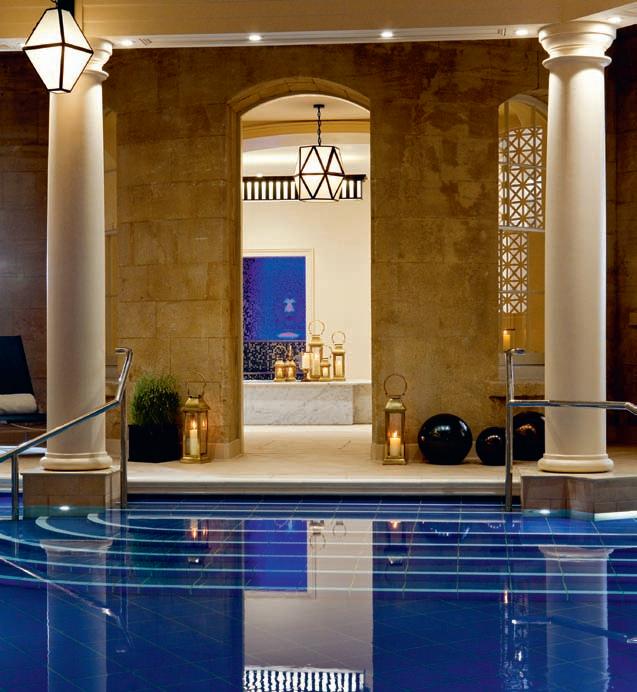

16 Royal Crescent, Bath BA1 2LS Web: royalcrescent.co.uk
Nestled within the opulent surroundings of the esteemed Royal Crescent Hotel in Bath, The Spa & Bath House beckons. Immerse yourself in sheer bliss of the 12-meter heated relaxation pool or for those seeking rejuvenation, the vitality pool awaits, equipped with strategically placed massage jets designed to alleviate the tension that may have accumulated in your back and calves. Fitness enthusiasts will find solace in the fully equipped fitness room, furnished with cutting-edge Power Plate technology, and when it's time to surrender to pampering, you'll discover six meticulously designed treatment rooms, where the expert staff provide a range of rejuvenating therapies from TempleSpa, as well as sumptuous manicures and pedicures by Jessica Nails. For details of the Spa Day packages as well as memberships visit the website and let your journey to tranquillity and well-being begin.
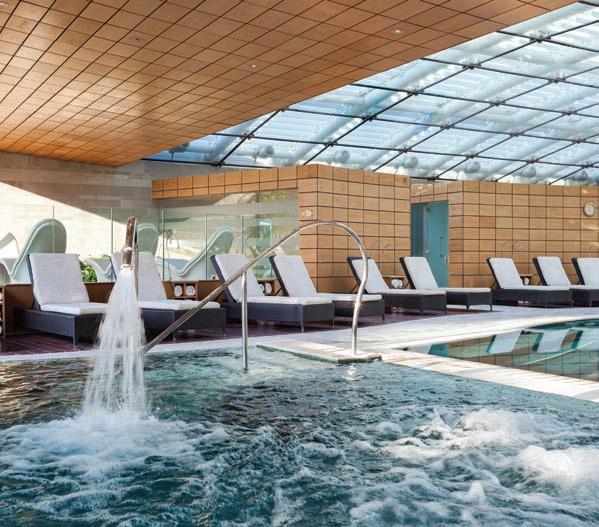
Sydney Road, Bath BA2 6NS Web: macdonaldhotels.co.uk
Escape from reality and take some time out at Macdonald Bath Spa. Using none other than ELEMIS products, your skin is in great hands here. From the signature ultimate wellness face and body treatment to the superfood proradiance facial, the choice is all yours. Or you could put your best foot forward with a 25-minute tension releaser. Men can enjoy a biotec super-charger facial, freestyle deep tissue massage and a high performance skin energiser.
With ELEMIS at the spa’s core, all treatments will provide you with the sanctuary that you deserve. Enjoy state-of-theart gym equipment, a sensuous spa and a gorgeous pool to dip into. Performed on a pear-shaped beanbag that moulds to every bump, there’s also a peaceful pregnancy massage available to restore wellbeing.
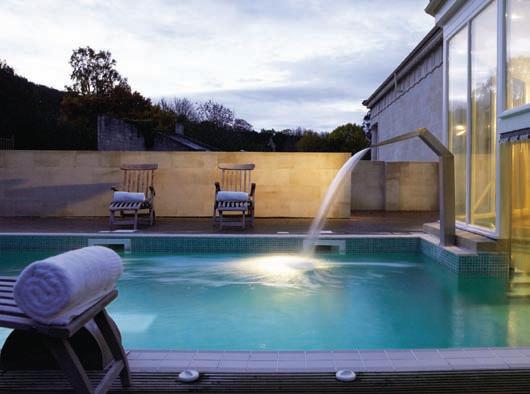
Colerne, Chippenham, Wiltshire SN14 8AZ Web: lucknampark.co.uk
Expect elegant walled gardens, a 20-metre indoor swimming pool, indoor and outdoor hydrotherapy pools, thermal cabins, experience showers and an outdoor salt water plunge pool. Make the most of the surrounding countryside with a calming outdoor yoga class, a workout at the outdoor gym or a relaxing stroll through the charming gardens. The ESPA spa at Lucknam Park has eight treatment rooms where the expert therapists perform a range of personalised and indulgent spa treatments. There’s even a pre-treatment social lounge with a product mixology bar available to help get your experience off to a flying start. A variety of treatments include mother-to-be packages, facials, manicures and pedicures and a body therapy collection. Men can also enjoy a selection of treatments including the ESPA triple effect focusing on the back, face and scalp. Sounds like pure heaven...

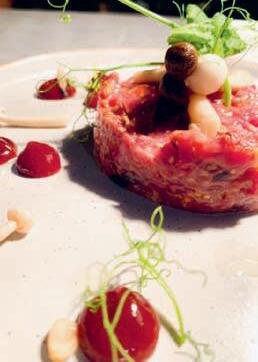



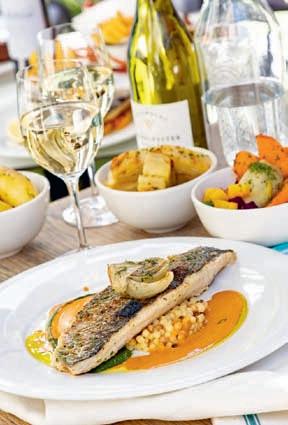


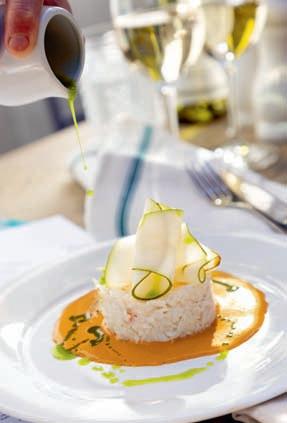

Clayton’s Kitchen is a perrenial favourite for local foodies and discerning visitors to Bath.
Robert Clayton, a Michelin-starred chef and the restaurant’s Chef Patron since its inception in 2012, creates uncomplicated dishes that explore and showcase the freshest and very best ingredients.
Inspired by Mediterranean and modern French cuisine, Robert ensures that every dish is prepared, cooked and presented to perfection.
To view up-to-date menus, the wine list and to book visit: claytonskitchen.com

15A George Street, Bath BA1 2EN 01225 724386 rob@claytonskitchen.com

food & drink
When it comes to eating out, Bath is blessed with a superb range of cuisines and culinary delights from around the world. We go behind the menus of the city’s favourite eateries –tuck in!
Bath is paradise for bon viveurs of every persuasion. There are hundreds of all-tastes, all-budgets, panglobal cuisine opportunities, from Michelin flagship restaurants and cutting-edge media darlings to the perfect post-pub bag of hot chips. Eat on the hoof, or lounging on a plush banquette with views across an awardwinning private garden. Take time out for an impromptu lunch in a cosy cafe, or book a table at the coolest dining room in town. Go sixcourse tasting menu or top up with tapas. Whatever your appetite, just do it – and prepare to indulge your senses.
The lavish, Georgian wake-up call so beloved in Jane Austen’s times still impact on life in Bath today. Breakfast and brunch are big here; from bacon butties or freshly baked pastries to shakshuka via passionfruit pancakes and prosecco.
Several of the establishments that line leafy, historic Kingsmead Square vie for the accolade of serving the best breakfast in Bath. The city centre branch of the Boston Tea Party was one of this small, independently owned chain’s very first establishments. BTP menus are all good stuff, but the all-day brunch menus hold legendary status. Local produce is pushed to the fore at the Kingsmead Kitchen too, while the Society Café (with its amazing coffee –and damned good almond croissants) is a buzzing Bath hotspot from the minute it opens. Most have outside seating and the vibe is oh so Parisienne on a summer’s morning.
According to the little sign hanging on the wall outside the Wild Café (Queen Street), Jane Austen declared the full English breakfast served here to be “the bestest in town.” Okay, so Austen might not have actually said that but the Wild Café’s breakfast menu is, indeed a thing of beauty, try the full English blowout via pancake stacks and eggs royale, Florentine or Benedict. Vegetarian options abound and pretty much everything is made on the premises to order, using local, seasonal ingredients.
Small plates, soups and sarnies make a popular lunch option and Bath will not disappoint in its effort to satisfy every taste, step into a world of culinary delight at Pomegranate Meze, the Greek and Turkish restaurant nestled within the grand walls of a vaulted former chapel in Walcot Street, or try the super Indian kitchen of Bandook in Milsom Place, serving the tastiest selection of small plates and
street food, or go for tapas-style French nibbles and snacks with the cheese and charcuterie boards at Comptoir+Cuisine on George Street. But if it’s a Brit lunch you need, there’s no better place to enjoy the best ever fish and chips than at The Scallop Shell in Monmouth Street - it is just a must when in Bath. For quick bites and take-out sarnies there are brilliant delis to enjoy such as Chandos Deli on George Street, The Fine Cheese Company on Walcot Street, or many of the coffee shops serve locally sourced and wrapped sandwiches, all ready to go, try Picnic Coffee on the corner of Saracen and Walcot Street.
When in Bath you do need to take on some afternoon treats, either to make an occasion of your stay or take a well-earned break from walking the city and boost your energy levels. Nothing beats the prospect of a cosy, treatsome afternoon tea – and variations of the afternoon delights theme are abundant in Bath. Go grand at the Pump Room in Abbey Churchyard –their Beau Nash cream tea includes smoked Scottish salmon and cucumber pikelet with Cuvée Brut. Alternatively try a spectacular assortment of sandwiches, pastries and cakes at the Gainsborough Bath Spa Hotel on Beau Street, or escape the city walls to The Bath Priory (Weston Road) or relish in the splendour of the Royal Crescent Hotel. Go modernelegant at The Ivy Bath Brasserie on Milsom Street with options such as truffled chicken brioche roll and freshly baked scones. Do the Jane Austen-style thing at the Regency Tea Rooms on Gay Street –served by figures in regency regalia, you can indulge in Mrs Bennet’s cake, or sample a characterful taste of the city’s history at Sally Lunns on North Parade Passage (the etiquette here is to eat your bun with a knife and fork). You can also dive into a huge pot of tea and a massive slab of homemade scrumptiousness at Mokoko (Abbey Churchyard), Café Lucca (Bartlett Street) or a pretty, little, sweettreat Mecca that is the aptly-named Sweet Little Things (Lower Borough Walls.) But don’t go overboard because dinner is just around the corner...
BISTROS, PUBS, DINERS, TRATTORIAS AND TAVERNAS – THE WORLD ON A PLATE
Don’t overlook dining at one of Bath’s glorious gastropubs in your search for a superb suppertime experience. The Griffin Inn (Monmouth Street, close to the Ustinov Studio) and the Garrick’s Head ( to the side of the Theatre Royal Bath) is conveniently ➲
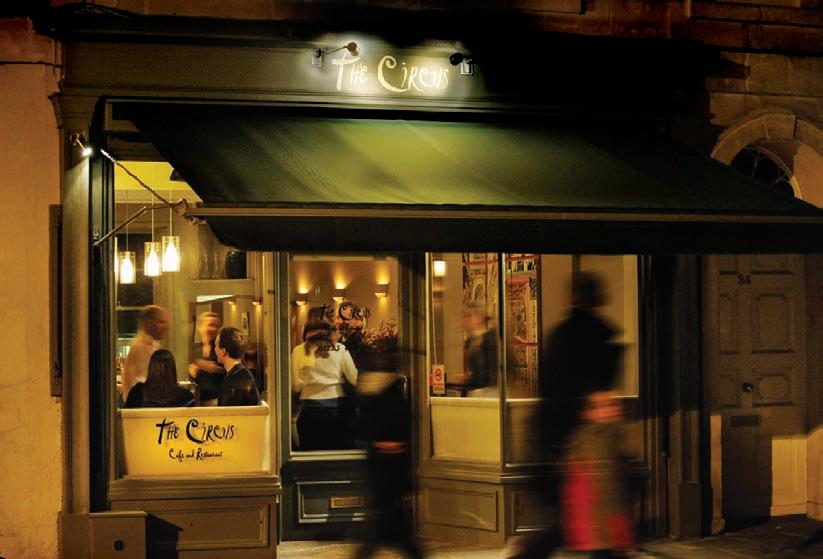
THE CIRCUS RESTAURANT


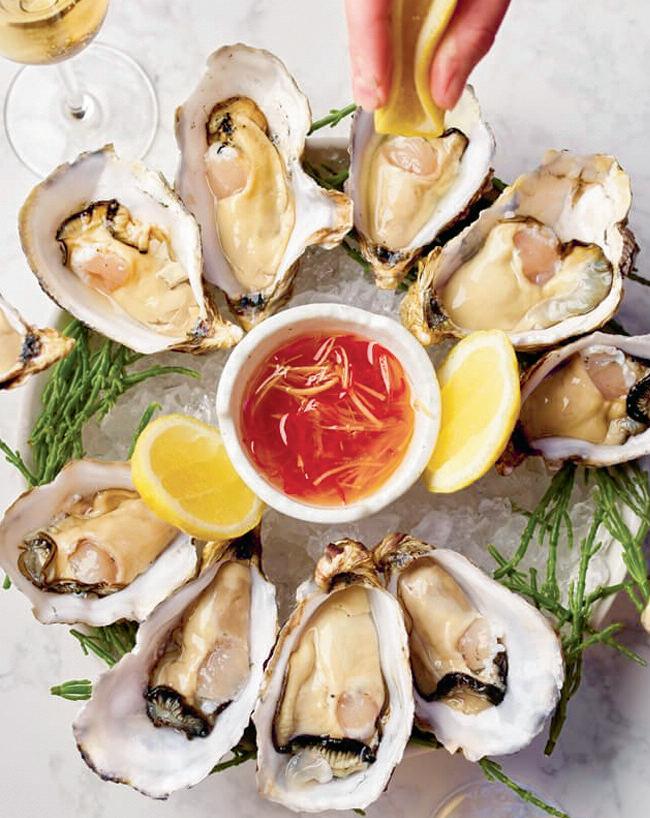


placed for a pre-theatre fast fix, while The Marlborough Tavern (Marlborough Buildings) is just a short hop from the Royal Crescent has one of the best pub menus in Bath. If you want an all-things-to-all-people experience, from upper-crust incarnations of pub classics to full-on foodie fabulous menus, try The Raven in Queen Street –a great pub for a pie and a pint –or the tiny Coeur de Lion in Northumberland Place is a quirky joy.
Many of Bath’s best restaurants are perfect for pre-theatre suppers and early evening dining, there’s the elegant Woods in Alfred Street –a Bath institution, the much reviewed (and revered) Beckford Canteen in Bartlett Street, go French at Boho Marché (at The Francis Hotel), you’ll love the Green Park Brasserie and Bath Pizza Co., both in Green park Station, and the smart Italian bistro La Terra in John Street are all great good places to start; but make some time for the well-loved, delightful bistros of Corkage on Chapel Row or Chez Dominique on Argyle Street... cancel all other plans... you probably want to stay the whole evening.
For a wallet-friendly, casual theme, Dough Pizza (Kingsmead Square and The Corridor) has dough choices including turmeric, hemp and seaweed or try the bargain-priced Yum Yum Thai (Kingsmead Square) –their in-the-wok stir-fries are divine.
Staying with Eastern delights; is Bath’s best Chinese restaurant, Peking is also on Kingsmead Square or the super charming Noya’s Kitchen on St. James Parade offers a delicious Vietnamese dining experience, and then there’s the fine Indian dining at The Mint Room just 10 mins walk from the city centre.
Sitting comfortably between constant delights and best bib‘n’tucker destination diners you can’t go wrong at the chic and stylish Circus Restaurant in Brock Street (leave room for the excellent desserts), The Gaff (Milsom Place) is highly acclaimed with amazing food and the casual elegance of Clayton’s Kitchen is one of Bath’s finest. Hudson Steakhouse (Walcot Street) serve the best steak in town (great cocktails too), but do try the amazing Japanese inspired menu of Robun on George Street - you’ll love it; and just along the road is the Flute Seafood Café and Bar serving fabulously fresh fish plates - wash them down with a glass or two of fizz –what could be better? And with Flute’s super-imaginative all-day menu you’ll be wanting to go there for brunch too.
Many folk visit Bath to pay homage to the big-name chefs who have earned themselves a national reputation. Most recently, superchef Chris Cleghorn has again retained his much deserved Michelin Star for his efforts at The Olive Tree at the Queensberry Hotel. Elsewhere, Robert Clayton at Clayton’s Kitchen, Martin Blake is head chef at Montagu’s Mews at the Royal Crescent Hotel and Hywel Jones at his eponymous Michelin-starred restaurant at Lucknam Park all are well-known as ultimate dining destinations with flamboyant, memorable tasting menu/wine flight experiences that showcase why they are at the top of their gourmet game. There’s no excuse for being hungry in Bath.
Need more inspiration? See our Eating Out Guide - starts on page 106 or visit postcardmagazine.co.uk
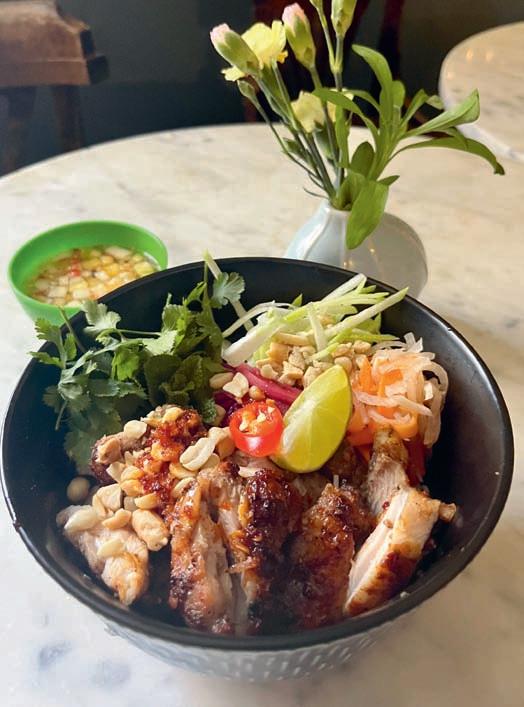
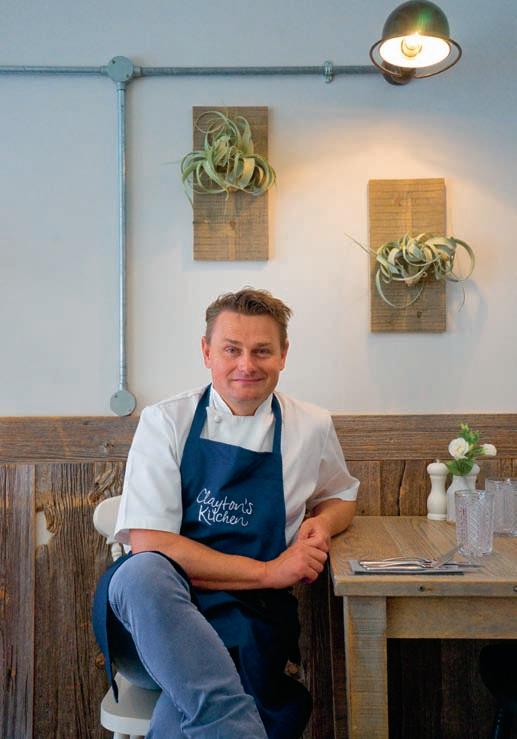

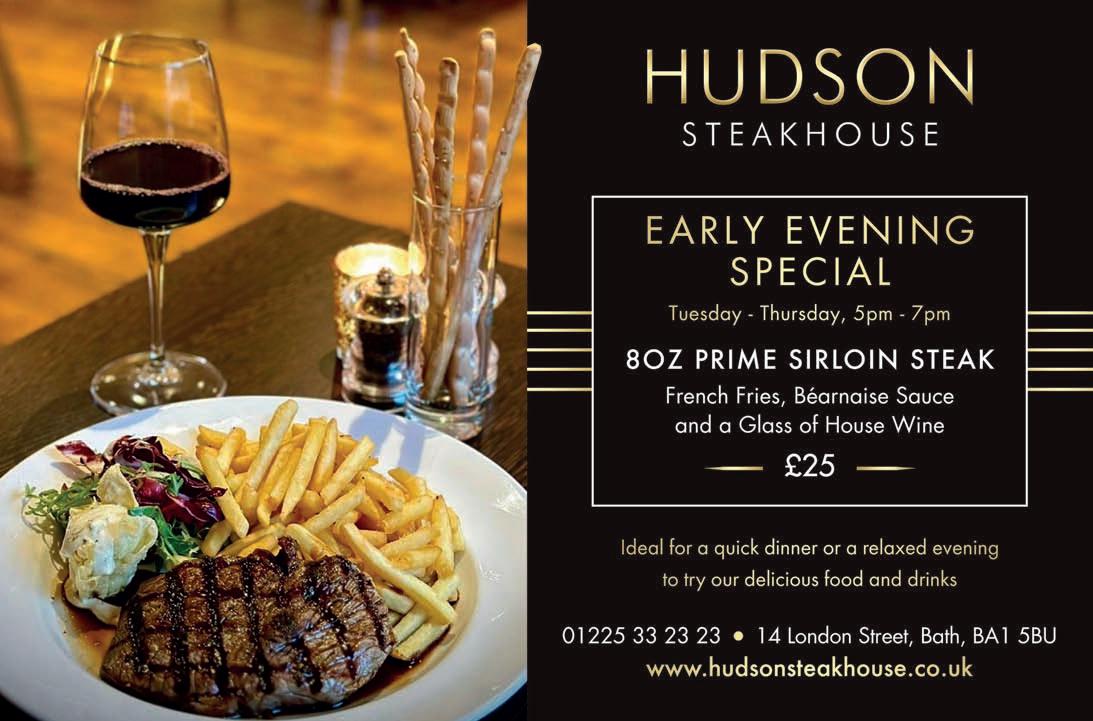

Looking for great places to eat and drink in Bath? Here are our recommendations to the city’s finest foodie destinations to suit your mood, appetite and pocket.
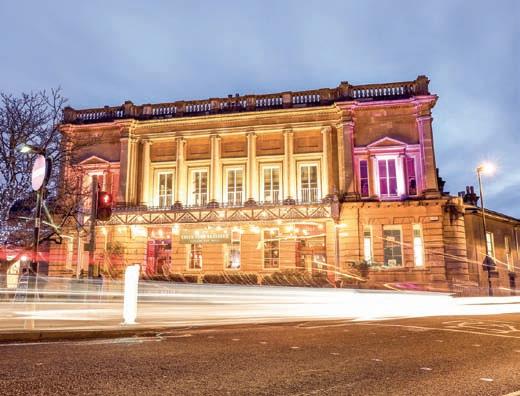
Green Park Station, Bath BA1 1JB Tel: 01225 338565 Web: greenparkbrasserie.com
Having become a must-visit destination over its 32 years, “the Braz” is a lively bar and restaurant with 4 nights of live music every week. Located in a funky old railway booking hall with a casual dining atmosphere and two terraces (perfect for sipping cocktails and watching the world go by) this independent business is proud to serve quality local produce and is also popular for its Sunday Roast and Bottomless Brunch - not to mention it’s sister kitchen Bath Pizza Co. Live music runs every Wednesday, Thursday, Friday and Saturday nights from 6.30pm onwards. Booking advised, walk-ups available.
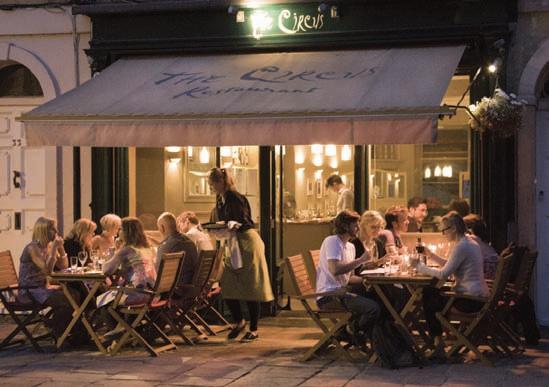
Green Park Station, Bath BA1 1JB Tel: 01225 588886 Web: bathpizzaco.com
It’s a “welcome to the neighborhood party and you’re invited” kind of vibe here. Bath’s must visit pizzeria, Bath Pizza Co is located in the funky historic Green Park Railway Station. Locally loved, Bath Pizza Co have featured in the National Pizza Awards for three years on the spin landing podium finishes in two of them. Swing by when best suits you for alfresco or indoor dining to soak up the busy atmosphere year round; perfect for lazy lunches and buzzing evenings with live music, cocktails, beers and of course… outstanding pizza.

34 Brock Street, Bath BA1 2LN
Tel: 01225 466020 Web: thecircusrestaurant.co.uk
A small, very busy, much-admired family-run business, The Circus Restaurant is one of Bath’s sparkling culinary gems, serving seasonal, locally sourced, freshly cooked English food. It has a carefully chosen wine list, and exceptionally welcoming staff. Set in a fine Georgian house – between The Circus and the Royal Crescent –you will find sensible and honest prices, and you’ll leave wanting to return some time soon. Voted number four in the UK in The Times’ 20 Secret Restaurants That Foodies Love. Open Monday to Saturday, 10am to midnight (closed Sunday). Booking is advised.

22 Monmouth Place, Bath BA1 2AY Tel: 01225 420928 Web: thescallopshell.co.uk
The Scallop Shell is a much-loved AA Rosette fish restaurant, serving lightly battered and grilled fish and chips and seasonal seafood. Flying the flag for a fresh, sustainable catch from UK waters, the menu changes daily depending on the coastal landings, with fish and shellfish displayed for customers to see in an ice-filled roll-top bath. Opt for classic north Atlantic cod loin served with mushy peas and homemade tartare sauce or make it more of a foodie experience with shared shellfish plates or the likes of oysters followed by Cornish monkfish tail or line-caught wild sea bass, with a great selection of wines sold by the bottle and glass. Up on the first floor, find The Little Scallop, an intimate indoor-outdoor dining room and kitchen with a retractable roof and laid-back holiday vibe.
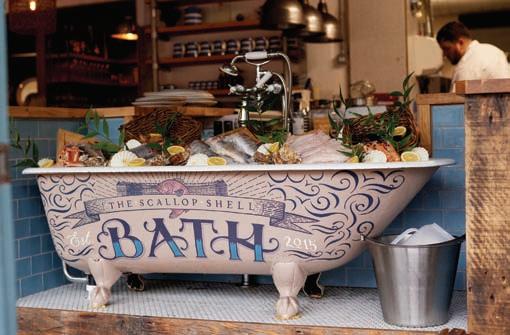
The lavish Georgian wake-up calls so beloved of Jane Austen times, still impact on life in Bath today. For a special breakfast or brunch treat, try the Ivy for a traditional full English, for great Eggs Benedict at WatchHouse or Bandook’s bottomless streetfood brunch with free-flowing prosecco at weekends... Oh yes!

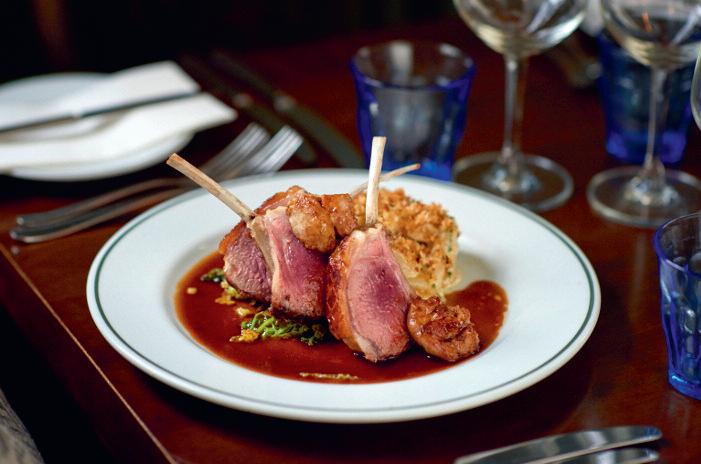
15 Argyle Street, Bath BA2 4BQ
Tel: 01225 463482 Web: chezdominique.co.uk
Ever popular, Chez Dominique is a family-run restaurant serving local and seasonal French and European food. Included in the latest Good Food Guide, it has been granted a certificate of achievement from Hardens for its high-quality food. This cosy, casual bistro is ideally located on the beautiful Argyle Street just over Pulteney Bridge, and the private dining room –comfortably seating eight –overlooks Pulteney Weir. Chez Dominique offers a prix fixe menu at lunchtime, an à la carte dining in the evenings, and there’s also a very carefully chosen wine list. Bookings - lunch: Monday to Saturday 12-3pm, Sunday 123pm. Evenings: Sunday to Thursday 5-9pm, Friday and Saturday 5-9.30pm Enjoy great food and drink in a relaxing and friendly atmosphere.
5 Chapel Row, Bath BA1 1HN Tel: 01225 423417 Web: corkagebath.com
Corkage is an award-winning independent restaurant, bar and bottle shop in central Bath. Think creatively cooked, locally sourced seasonal plates and daily specials, with a broad range of exquisite wines from around the world, by the glass and bottle. You can sip crisp English fizz with a plate of pasta or day boat fish, or go for a multi-course experience, featuring the likes of oysters with Bloody Mary granita, pan fried pigeon breasts with potato terrine, braised radicchio and damson jus and cocoa cheesecake with raspberries and white chocolate. With a beautiful fairy-lit heated terrace and secret courtyard garden, it’s one of those special places to enjoy year-round.
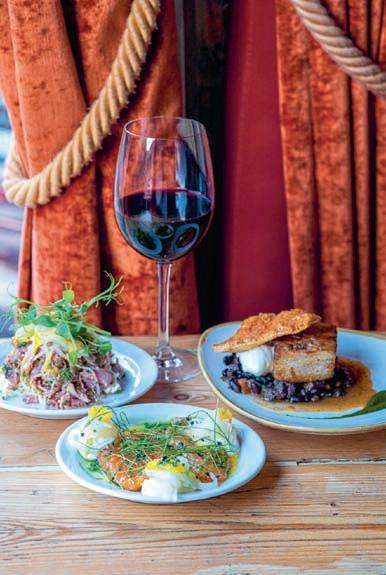


16 Royal Crescent, Bath BA1 2LS
Tel: 01225 823333 Web: royalcrescent.co.uk
Fresh, local ingredients, inspired style and flawless service. Somewhere to relax and enjoy special moments that become lasting memories. Montagu’s Mews boasts a glamourous bar and a stylishly snug and relaxed restaurant; offering a menu that has a strong focus on locally sourced ingredients. Head chef Martin Blake and his kitchen team serve carefully curated seasonal dishes and accomplished tasting menus that elevate classic dishes to sublime new heights. The outdoor dining terrace, complete with cantilever parasols, seasonal heaters and views over the gardens, offers an idyllic setting for alfresco dining.

Lucknam Park Hotel & Spa, Colerne SN14 8AZ Tel: 01225 742777 Web: lucknampark.co.uk
Set among the 500-acre Lucknam Park estate, The Walled Garden Restaurant at Lucknam Park is a foodie dining destination that illuminates the very best local produce, with its own kitchen garden providing vegetables alongside supplies from some of the best farmers in the country. The green, lightfilled dining space has calming, natural views of the courtyard and gardens beyond and has all the romance and serenity of an English country garden. Open daily (breakast 7.30am-10am; lunch 12pm-2.30pm; dinner 6pm-9pm.

4 Princes Buildings, George Street, Bath BA1 2ED Tel: 01225 614424 Web: robun.co.uk
Robun is a celebration of authentic Japanese food and drink, specialising in a modern take on Yakiniku – the art of grilling meat, seafood and vegetables over a traditional charcoal fire. The menu features a range of meticulously crafted dishes using only the freshest and finest ingredients. From delicate sashimi and perfectly grilled wagyu beef, to artisanal sushi rolls and exquisitely presented small plates, each dish is a work of art that showcases the skill and creativity of Robun’s talented chefs. To accompany your meal, there’s an extensive selection of premium sake, Japanese whiskey, and cocktails, handpicked to complement the cuisine. For something special, Robun’s Afternoon Tea swaps sandwiches for sushi and scones for bao buns. This beautifully presented Afternoon Tea features some of the standout dishes from Robun’s menu. Upstairs at Robun, a private dining room and bar is set to host celebrations, events and meetings. The space can accommodate 40 seated or 50 standing guests, with set menus available for parties of eight or more. Set in the heart of Bath, Robun offers an informal yet refined environment to share freshly prepared sharing plates and pairings.

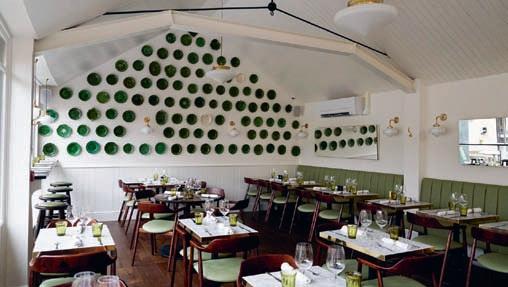
11-12 Bartlett Street, Bath BAI 2QZ Tel: 01225 338470 Web: beckfordcanteen.com
Set in a former Georgian greenhouse, with a pretty garden, Beckford Canteen is a space for people to come together and share the joys of delicious food and great hospitality. Sitting on bustling Bartlett Street, in one of the prettiest parts of Bath, the restaurant offers a light and airy space bedecked with banquettes, leather clad dining chairs and window countertops to watch the world go by. Having recently received a rave review from Giles Coren in The Times, Beckford Canteen is the perfect stop for a quick, tasty bite or a longer, more indulgent dining experience.

1–2 New Street, Kingsmead Square, Bath BA1 2AF Tel: 01225 466377 Web: pekingrestaurantbath.co.uk
Since opening in 1985, this family-run, independent restaurant is the number-one choice for local, authentic Chinese food. The master chef has created an extensive menu of fresh, healthy and innovative dishes selected from Cantonese, Szechuan and Peking cuisines, using local ingredients wherever possible. As well as the traditional flavours of sweet and sour, ginger and spring onion, Peking also offers muchloved lobster and crab dishes. The chef also prepares special dishes on request. The friendly, skilled staff at Peking strive to provide a genuine Chinese experience with a promise to put their hearts and souls into everything they do.
15a George Street, Bath BA1 2EN Tel: 01225 585100 Web: claytonskitchen.com
Clayton’s Kitchen is a firm favourite with locals and a must for visitors to Bath seeking a wonderful culinary experience. This charming, relaxed and stylish restaurant is led by chef-patron Robert Clayton, who has achieved two Michelin Stars while running retaurants in Bath. Inspired by Mediterranean and modern French cuisine, Robert creates uncomplicated but sublime dishes; prepared, cooked and perfectly presented using the freshest, highest quality ingredients. To reflect this, the beautifully compiled menu changes seasonally and is accompanied by an excellent wine list. Enjoy a fantastic lunch or dinner –you’ll want to return. Open Wednesday to Sunday. Weds–Thurs: 12–2.30pm and 6–9.30pm. Fri–Sat: 12–2.30pm and 5.30–10pm. Sun: 12–3pm and 5.30–8.45pm.

7 St James’s Parade, Bath BA1 1UL Tel: 01225 552582 Web: noyaskitchen.co.uk
Noya’s Kitchen serves up delicious Vietnamese home cooking in a stylish and beautiful Grade II listed building in central Bath. Voted one of the UK’s Top 5 Independent Restaurants by Gousto in 2021, and judged Bath’s Best Restaurant in 2022, advance bookings at weekends are essential! Vietnamese food lovers can enjoy delicious dishes like Pho, Vietnamese curries and summer rolls on Tuesday–Saturday from 12–3pm, and Tues–Thurs and Sat evenings from 5.30–9pm. There’s always something new and delicious on the Specials board in the restaurant, or tune in to the social feed for Noya’s Kitchen to hear about them. The menu changes regularly depending on locally sourced ingredients, the weather and Noya’s inspiration. Book online or call in, you’ll be warmly welcomed.
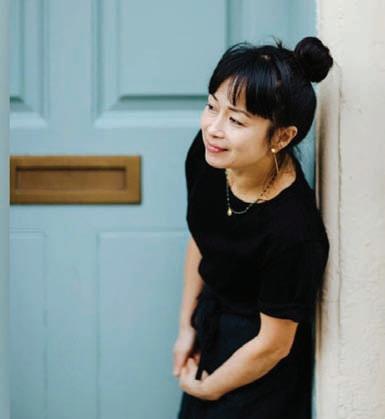

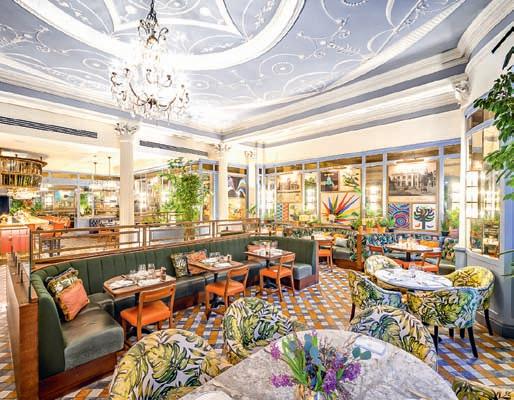
39 Milsom Street, Bath BA1 1DS Tel: 01225 307100 Web: theivybathbrasserie.com
The Ivy Bath Brasserie, located within the heart of the city offers sophisticated and friendly all-day dining to both residents and visitors alike. Situated on the popular Milsom Street, within close proximity to many of the town’s most famous destinations and iconic landmarks. The Ivy Bath Brasserie occupies a beautiful Georgian building with striking high ceilings and original features of the historic banking hall, with the bar and interiors designed by Martin Brudnizki Design Studio. Open seven days a week, there’s an all-day menu, serving modern British classics, including breakfast, weekend brunch, lunch, afternoon tea, light snacks, dinner and cocktails. The Ivy Bath Brasserie is accessible and relaxed, alongside the main restaurant and bar, the venue features a private dining room, as well as a beautiful al fresco terrace.
Lucknam Park Hotel & Spa, Colerne SN14 8AZ
Tel: 01225 742777 Web: lucknampark.co.uk
Restaurant Hywel Jones offers an unforgettable dining experience. Enter through the mile-long driveway lined with beech and lime trees before you commence your evening of fine dining from the seven-course tasting menu or a la carte menu. Executive chef Hywel Jones has held a Michelin Star at the restaurant since 2006 and uses the finest ingredients to ensure the fullest flavours. Supporting and using fresh, local produce helps enhance the subtle flavours of the cooking. Restaurant Hywel Jones is open 6.30pm–9pm from Wednesday to Saturday.


9 Kingsmead Square, Bath BA1 2AB Tel: 01225 422320
14–16 The Corridor, Bath BA1 5AP Tel: 01225 443686 Web: doughpizzarestaurant.co.uk
Proudly independent, family-run pizzerias, with venues in Kingsmead Square and The Corridor, Dough combines years of expertise and the best ingredients to bring you first-rate pizza, every time. With a focus on pizza for everyone, Dough offers 12 alternative health-giving bases, from kamut to hemp, grano arso, multigrain and more, alongside traditional sourdough. Gluten-free and allergy friendly pizzas are a particular speciality. You’ll find all the classics from margheritas to marinaras alongside pizza parcels, star-shaped pizzas and gourmet specials such as The King with mozzarella, porcini mushrooms, paprika prawns, king prawns, rocket pesto, truffle oil, lemon zest and pink pepper, based on seaweed dough. Warm, family-friendly service, dough-spinning entertainment and plenty of Italian charm ensures that any visit to Dough is a memorable one.

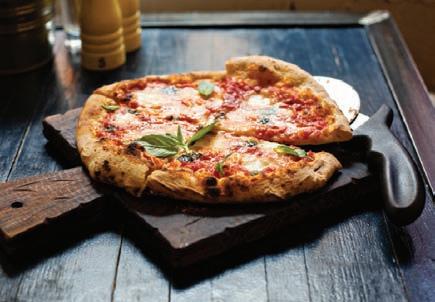
Margherita pizza was named after a queen. In 1889, King Umberto I and Queen Margherita of Italy visited Naples and asked for pizza as a way of escaping the fancy food she was used to eating. She found ‘pizza mozzarella’ delicious, a pie topped with soft white cheese, tomatoes, and basil. So the Margherita pizza came to be.
14 London Street, Bath BA1 5BU Tel: 01225 332323 Web: hudsonsteakhouse.co.uk
Hudson Steakhouse has been serving the people of Bath the best steaks for over a decade, offering its diners prime dry-aged steaks, starters with a fusion influence and classic dishes, all served in a sympathetic conversion of a once-notorious Victorian pub. Owner Richard Fenton took on this run-down building and has created a destination that has consistently won best-restaurant awards locally and nationally. Cocktails, premium beers and world wines are served under sparkling chandeliers and the upstairs grill room has an open kitchen which looks out over Hedgemead Park.
31 Barton Street, Bath BA1 1HG Tel: 01225 463861 Web: pintxobath.co.uk
Pintxo de Bath is an authentically Basque-style tapas and sherry bar in the heart of Bath’s theatre district, tucked away in Barton Street. Pintxo brings a taste of Spain to the city. With a laid-back feel, outside tables and a delightfully sunny sherry garden, it’s the perfect place to spend time with friends, sampling the best sherries, wines and food from the owners’ favourite parts of Spain. Working with a local importer Pintxo has a selection of the perfect wines and sherries to complement great tapas. And if you love sherry there’s a dedicated sherry menu. There’s no reservations, just turn up and the friendly staff will do their best to seat you.



27 Milsom Place, Bath BA1 1BZ Tel: 01225 335509 Web: cote.co.uk
Whether you want to enjoy a tasty treat before a show or celebrate a special occasion in style, you can’t beat the ambiance and authentic French cuisine on offer at Côte Brasserie in Bath. With something to cater to all tastes, including vegetarian, gluten-free and children’s menus, Côte has something for all the family, whether it be breakfast, lunch or dinner. Their lunch and early evening menu is available Monday – Friday until 7pm, and for three courses it is the perfect mid-week or pre-show option. This national chain is always a popular choice.




2 John Street, Bath BA1 2JL Tel: 01225 482070 Web: laterra.co.uk
Having just received its first Rosette Star - La Terra is an independent restaurant in the heart of Bath, run by business partners Vito and Alessandro serving up Italian cooking with a modern approach. Using local and fresh produce, the menu reflects the seasons and highlights many different aspects of Italian dining and is complemented by an extensive wine list covering all regions of Italy as well as serving some classic French and Spanish wines. Service is attentive and friendly, providing a comfortable, happy and relaxed atmosphere. Vito Scaduto heads the front of house and has over 30 years experience managing some of the most renowned restaurants and hotels in the UK, receiving accolades at The Bath Priory, the Three Gables in Bradford on Avon, the Royal Crescent and many more. Running the kitchen is Alessandro Scola, from Lake Como in northern Italy. Alessandro spent his childhood surrounded by people cooking real Italian food, including making fresh pasta with his grandma, so he was always destined to be a top a chef. The food at La Terra is absolutley delicious. Be a customer!

Many of Bath’s best restaurants offer pre-theatre supper deals, and early bird set menu bargains abound between 5.30–7pm, including elegant Bath institution Woods, the brilliant Chez Dominique, Dough Pizza (which has dough choices including turmeric, hemp and seaweed) and not forgetting the tempting gastro menu at Green Park Brasserie, housed in the restored train station ticket hall.
5 George Street, Bath BA1 2EJ Tel: 01225 684733 Web: comptoirpluscuisine.com
Comptoir+Cuisine serves coffee, juice, croissants and pastries, making it the perfect spot for breakfast, a mid-morning snack, or as a welcome respite from the hustle and bustle – to sit and read, or to catch up with friends or colleagues. For lunch and dinner, enjoy nibbles, cheese and charcuterie boards, including the popular baked camembert cheeses, as well as salads and a delicious range of tapasstyle French sharing plates featuring meat, fish,cheese and extensive vegetarian options. Comptoir+Cuisine also offers a selection of Grower Champagnes by the glass, as well as beer and wine. For those who fancy a sweet treat, there is a tasty selection of macaroons and gateaux on offer too. These taste even better when enjoyed with a glass of crisp Grower Champagne for afternoon tea.

18-19 Pulteney Road, Bath BA2 4EZ Tel: 01225 580438 Web: thebirdbath.co.uk
PLATE is a vibrant, community-focused restaurant that serves up delicious, ethically sourced dishes. Sustainability is at the heart of everything they do, which takes pride in supporting local farmers and fishermen. The menu features locally sourced, seasonal ingredients, ensuring a fresh and unforgettable dining experience. Guests can expect classic dishes with a mischievous twist, all crafted to challenge their taste buds. PLATE's commitment to sustainability and community makes it a must-visit destination for those seeking a sophisticated dining experience that is both delicious and planet-friendly.

The Indigo Hotel, 2–8 South Parade, Bath BA2 4AB Tel: 01225 530616 Web: theelder.co.uk
The Elder is a truly elegant restaurant and bar situated in the historic centre of Bath and is the place to enjoy authentic, honest and timeless cooking that uses the British countryside and seas as its larder. Created by owner Mike Robinson, and executive chef Gavin Edney their focus is on sustainability, seasonality and British wild produce. The Elder restaurant is open for lunch and dinner with an à la carte menu enhanced by a beautifully curated wine list. Oysters and Champagne can be enjoyed on the terrace on warm weekend afternoons in the summer and the year-round cocktail list takes inspiration from the classics whilst using the seasons and local ingredients to create utter magic.
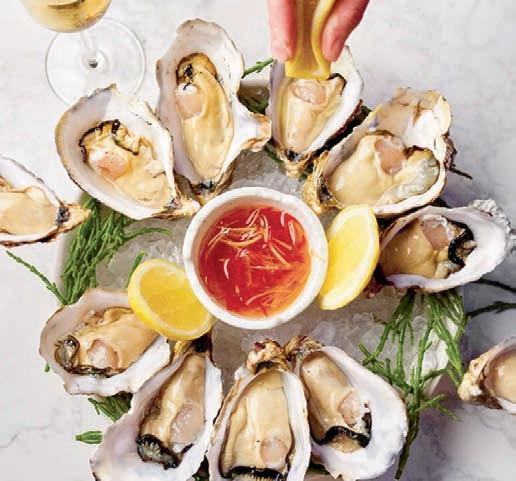
9 Edgar Buildings, George Street, Bath BA1 2EE Tel: 01225 400193 Web: flute-bath.com
Flute Seafood Café and Bar is the new all-day cosy hangout spot tucked snugly into the centre of Bath’s popular George Street. Flute is all about keeping things fresh, fun, and delicious, and serves fabulous breakfasts, exciting cocktails, a large selection of sparkling wines, and the best seafood the city has to offer. Whether you’re looking for an early breakfast, delightful sharing plates and cocktails for a day out with friends, or a seafood meal to remember, Flute has something for everyone. Soak up the Flute experience where awesome food, good vibes, and unforgettable moments come together in perfect sync.

9–13 Alfred Street, Bath BA1 2QX Tel: 01225 314812 Web: woodsrestaurant.com
This is quite simply a Bath institution. With Georgian elegance and a warm informal atmosphere, Woods has created an enviable reputation as one of Bath best independent restaurants, a firm favourite with locals and a must for visitors to Bath. Established in 1979 by David and Claude Price, they work alongside the head chef of 28 years Stuart Ash and Gaston Price who runs the front of house. A truly family-run business offering personal service, dazzling food, modern British cooking with a classic French influence, and sourcing local ingredients to give you a mouthwatering sensation that will leave you coming back for more. The menu changes seasonally with specials of the day. The wines that accompany the delicious dishes are specially selected and tasted by David. Woods caters for all: the small terrace and bar are great to meet friends for a glass of wine, a dish of olives and a catch-up; the main dining room is ideal for intimate or informal dining; and the private room is perfect for corporate entertainment, family celebrations or weddings. Woods also has a Wine Shop and Deli (which runs from Weds to Sat) to eat in or take away, and you can enjoy a Sunday lunch on the first Sunday of every month.


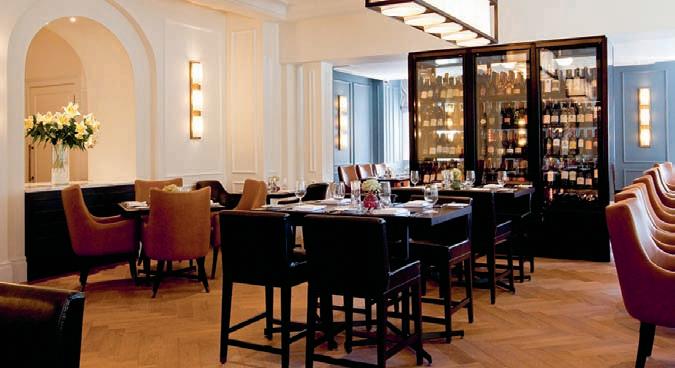
Hunstrete House, Hunstrete, Pensford, Bath BS39 4NS Tel: 01761 490490 Web: thepighotel.com
THE PIG-near Bath is a buzzing restaurant with rooms –with the Kitchen Garden at its heart – nestled between Bath and Bristol on the edge of the village of Hunstrete. With a serious commitment to the community and surrounding area, THE PIG-near Bath celebrates all things Somerset. The food is driven by home grown clarity of flavour, true to the seasons and influenced by location. The Garden and Kitchen teams work hand-in-hand to create the restaurant’s 25 mile menu, which is supported by passionate local farmers and small producers, who supply anything that the team cannot grow or produce themselves. This commitment not only supports their local suppliers, but means they can be 100% honest on the provenance of their ingredients.

The Gainsborough Bath Spa, Beau Street, Bath BA1 1QY Tel: 01225 358888 Web: thegainsboroughbathspa.co.uk
Located right in the centre of Bath at the 5-star luxury Gainsborough Bath Spa Hotel, The Gainsborough Brasserie is now kicking things up a notch with a kaleidoscope of globally inspired gourmet experiences with new flavours where East meets West featuring the freshest and choicest ingredients to make up its diverse spread of gastronomic creations. As well as dining at this stylish brasserie you can take traditional afternoon tea daily in the Canvas Room and beautifully crafted cocktails and drinks are served nightly in the Gainsborough Bar.

Eveleigh Avenue, London Road West, Bath BA1 7JD Tel: 01225 855101 Web: handpickedhotels.co.uk
Relaxed elegance is firmly on the menu at Bailbrook House in Bath, which offers a variety of spaces in which to enjoy modern British seasonal food prepared with passion and served with charm. Drink in the historic period charm of Cloisters restaurant, which takes full advantage of striking architectural features and beautiful views out onto the gardens. An altogether more contemporary space is The Conservatory, a modern setting with plenty of natural light and a summer terrace for peaceful alfresco dining. Characterful royal lounges provide an idyllic spot in which to enjoy afternoon tea, or its private dining rooms are ideal for celebrations and special events. Make magical memories and experience laid-back luxury.

35 Marlborough Buildings, Bath BA1 2LY Tel: 01225 423731 Web: marlborough-tavern.com
Located just a stone’s throw from the Royal Crescent, The Marlborough Tavern combines the atmosphere of a local pub with the food quality of a top restaurant, making it a firm favourite in Bath. The menu uses local produce to create greattasting, simple dishes where the quality of the produce speaks for itself. The Marlborough has held two AA rosettes for food quality since 2009, and features in the Michelin Guide. While it holds accolades for its food, it’s still very much a pub and offers local ales and craft beers. Outside, it boasts a beautiful pub garden – a walled courtyard space that’s just perfect for alfresco lunching and drinking with good friends.

The Indigo Hotel, 2–8 South Parade, Bath BA2 4AB Tel: 01225 460441 Web: brasseriebeau.co.uk
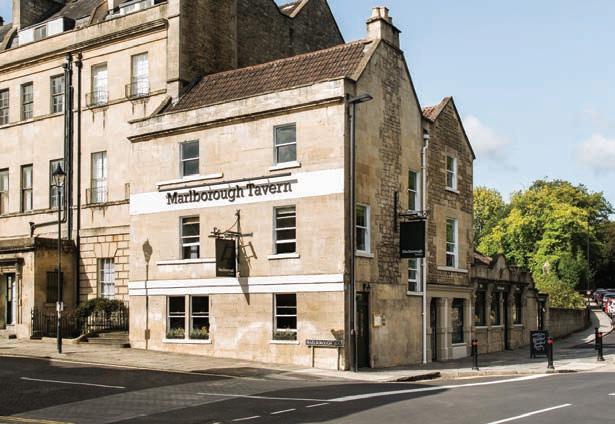
The Queensberry Hotel, 4–7 Russel Street, Bath BA1 2QF Tel: 01225 447928 Web: olivetreebath.co.uk
The Olive Tree is currently Bath’s only Michelin star restaurant, an accolade first awarded in October 2018. Sitting below The Queensberry Hotel, The Olive Tree, in addition to being the city’s most celebrated restaurant, is one of its longest established, offering relaxed fine dining in a contemporary British setting. Head chef Chris Cleghorn honed his skills and developed his own unique style under world-renowned Michelin star chefs. For more than five years he has, with his team, been creating amazing meals using seasonal ingredients from high-quality local producers. The Olive Tree’s wine list is also award-winning; it eclectically balances traditional and new, and the restaurant’s warm opulence perfectly complements the quality and style of food.
Brasserie Beau is the newest Hotel Indigo venture into memorable dining experiences. Created by owner Mike Robinson and executive chef Liam Goldstone, Brasserie Beau champions wild food and support small producers. Being guided by the seasons and availability of ingredients, the menus evolve daily. Diners can enjoy a leisurely brunch, a quality steak or classic Sunday lunch along with an extensive wine list or enjoy cocktails at the cocktail bar. The restaurant can cater for all occasions from large groups to those seeking an intimate setting. Open seven days a week from 12pm to 9:30pm the brasserie offers visitors a sanctuary where they can eat, drink, and unwind away from the bustling city centre.

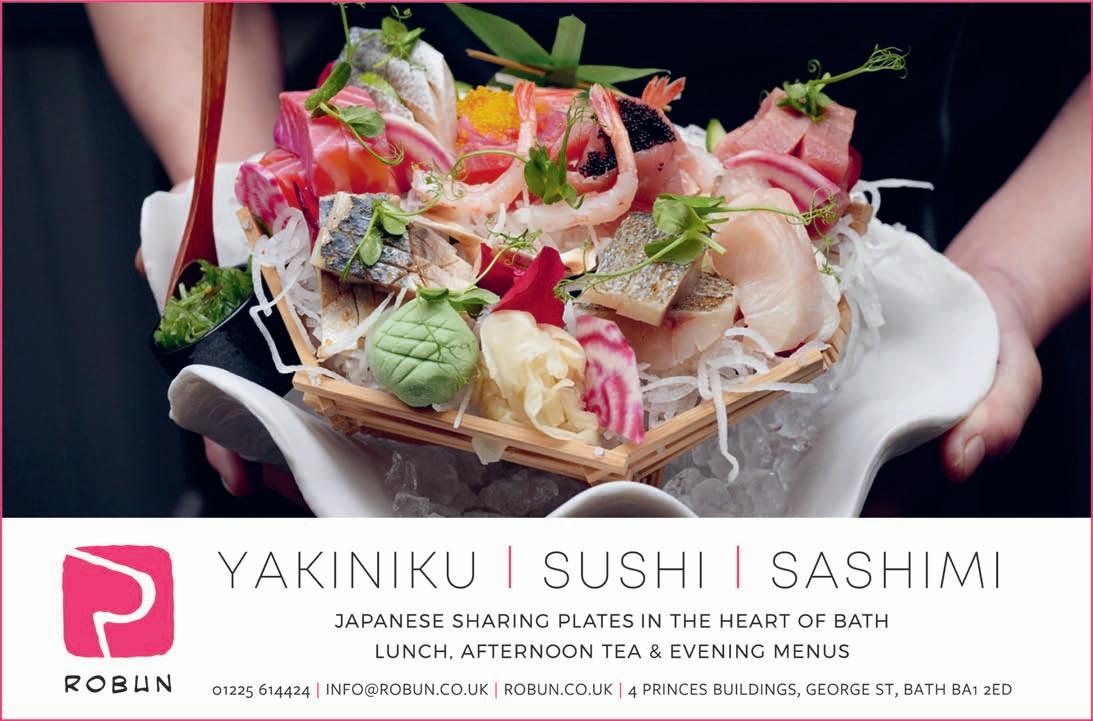


88 Walcot Street, Bath BA1 5BD Tel: 01225 462992 Web: pomegranatebath.co.uk
Step into a world of culinary delight at Pomegranate, the Greek and Turkish restaurant nestled within the grand walls of a vaulted former chapel in Walcot Street. Immerse yourself in the ambiance of this restaurant and its Arts and Crafts-influenced architecture, where history meets the Mediterranean in a perfect harmony of flavours. From savoury kebabs, time-honoured moussaka and lamb kofta to chickpea fritters, baba ghanoush and tzatziki, the menu pays homage to Greek and Turkish traditions, offering a diverse palette of tastes. The food at Pomegranate is authentic, well-curated and served with bundles of flavour, and the prices are highly accessible (two courses £15.95 and three £18.95). Whether you're seeking a romantic dinner or an unforgettable meal with friends and family, Pomegranate promises a warm and friendly dining experience.

Email: info@lechefprive.co.uk Web: lechefprive.co.uk

Abbey Lane, Freshford, Bath BA2 7TBZ Tel: 01225 580439 Web: homewoodbath.co.uk
Homewood, is an elegant, quintessentially English, Georgian house, just a short drive from Bath and set in award-winning gardens and beautiful Somerset countryside. The Olio Restaurant and Terrace serves a modern British and Mediterranean inspired menu where produce is locally sourced and of the highest standard. From generous feasting platters for sharing, there’s great British and Mediterranean favourites as well as classic dishes, indulgent desserts and an unmissable Somerset cheese board. The sunny terrace is just perfect for Summer dining and clever perspex dining domes are available all year-round, providing a unique dining experience in any season. Whether eating in the restaurant, sitting rooms, or terrace, guests enjoy a warm, relaxed atmosphere and a menu packed with Somerset's finest grub.
Since retiring from the well-loved restaurant Casanis, chef Laurent Couvreur offers personal services for special occasions. From cheffing on board Northabout in the Arctic for adventurer David Hempleman-Adams to recreating favourite restaurant dishes in local homes, Laurent uses wonderful local produce to recreate his southern French style of cooking with a twist. Le Chef Privé takes all the stress out of your dinner parties, presenting awardwinning restaurant-quality food in the comfort of your own home. Chef Laurent proudly reads us a note from one of his customers: “Thank you for a truly wonderful evening, I cannot imagine a better way to have celebrated my birthday. The food was (unsurprisingly) marvellous and the entire evening flowed beautifully, from canapés to dessert. All our guests have expressed their delight at the dinner.” He adds, “We look forward to bringing incredible flavours and a ray of French sunshine to our diners’ homes.”
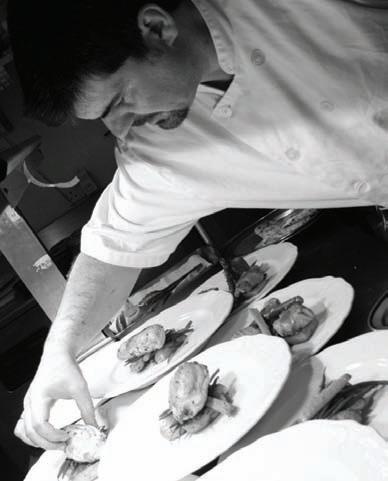

Richard Knighting and Marty Grant’s route into restaurants has been far from traditional, which makes their food and wine experience at Corkage all the more exciting for the journey. Kate Hearst catches up with the multi-talented duo to find out what’s cooking
SStep inside Corkage on Chapel Row and you feel like you’ve arrived in the cosy surrounds of a friend’s house. Rich velvet curtains, acres of warm wood, artfully peeling paint and an instant sense of fun from affable owners Marty Grant and Richard Knighting provide the perfect welcome. Light floods in through skylights in the restaurant space and at this time of year you’ll want to make a beeline for the twinkly terrace and secret suntrap garden.
Interestingly, the weather plays a key role in what’s cooking. “There’s a lot to be said for eating the seasons and what you might enjoy during a particular spell of weather,” says Richard, who leans towards the restaurant side of the business. “I’ve always liked the idea of cooking what’s around, as it’s the way I grew up. It’s lovely to have the world as a market to choose from, but it’s important not
to lose sight of what we produce ourselves and what’s coming fresh out of the water or the land.”
The ever-evolving menu focuses on a key seasonal ingredient –maybe crab, cauliflower or pigeon – cooked simply but always packed with flavour. You’re well advised to order a bit of everything to share so as not to get food envy as mismatched yet beautiful plates waft past your table. “The foundation is simple, classical cooking with influences from all over, using the best ingredients we can get with our own innovative twist,” explains Richard.
Of course, with a name like Corkage, the wine list is anything but an afterthought. The wine selection is one of the biggest – if not the biggest – in Bath, with around 200 bottles, more than 60 of which are available by the glass. The team are walking wine lists, which comes in handy if you don’t know your Burgundy from your Bacchus, or just fancy a steer towards something new.
You have to be a very special breed to care enough to make a really good wine that’s artisan and made with love
As the self-proclaimed ‘original winehead’, Marty handles much of the vinous side of the business. “One of the most interesting things for me are the people who make the wine,” says Marty, who loves a good backstory. “You have to be a very special breed to care enough to make a really good wine that’s artisan, made with love and is a genuine expression of the terroir and where it comes from. The best compliment you can pay a winemaker is that when you drink their wine, you close your eyes, and it transports you to that place. The recognition of signature is the success of the wine. It’s quite visceral, almost emotional when that happens.”
Chat to Marty and Richard over a glass or two and it’s soon apparent that their own route to Bath hospitality stalwarts was far from an easy one. A born performer, Marty grew up in rural Ireland and was on the stage from age four. He went on to gain a degree in environmental science and was on his way to start a research doctorate in Africa when he thought better of it. “I decided to bail and run away and join the circus!” laughs Marty. A self-taught acrobat and part of a physical comedy trio playing all over the world, it was a back injury which ultimately put paid to his stage career. “It was like starting all over again,” he says. “I always enjoyed wine and when I was convalescing, I would often go to chateaus and vineyards and hang out with winemakers. It reignited my passion for the grape.”
Richard grew up in the north-east and has fond memories of picking mussels and eating crab at the beach. “If you’re eating mussels at that age, you’re fairly fearless,” says Richard. Cooking runs in his family, so naturally he went against the grain with a degree in languages before taking various roles in heavy industry to allow travel to far-flung places to experience the joys of the local cuisine. A career break saw a stint as a divemaster and chef in central America before he finally came back to dry land in London to take the plunge into professional kitchens and realise his dream. It was a chance encounter on a job that led him to Marco Pierre White’s Michelin-starred Mayfair kitchen at Mirabelle to meet its executive chef, aged 28. “Phil offered me a job starting the next week and that was that; the oldest commis chef in town,” says Richard. From there, he went on to open the Soho Hotel and worked in private members’ club 50 St James running a three-star menu for high-end guests before his wife Emma brought him to the West Country.
The Bath end of things started at The Marlborough Tavern, when then owners Joe and Justin were just six weeks in and on the lookout for a head chef. “We had a good time,” says Richard, “we went to London and won national competitions, got the rosettes and made the Michelin Guide.” He stayed for six years. Marty was running Gascoyne Place on Saw Close before the two joined forces.
Any long-time fans of Corkage will remember the original pop

up space on Walcot Street, which opened its doors back in 2015 and sadly closed for good with the advent of the pandemic. The duo is rightly proud of the impact it had on the Bath dining scene. “Noone was doing small plates then, certainly not in the way we were doing,” says Marty. “This is a restaurant,” says Richard, indicating the surroundings of Chapel Row, “whereas Walcot Street was more of a bodega, with an open experimental kitchen. “The wine offering was shooting from the hip in a dynamic way,” adds Marty. “It was like a sweet shop of wine and the cooking happened in the room, so you got all the bustle and smells. It was a very active and intimate set-up. You might be sitting next to the guy doing the dishes.”
These days, while Corkage 2.0 is a little more polished, it’s no less forward-thinking. There’s a new head chef behind the stoves, Rob Thomson, conjuring the likes of tandoori poussin with coriander and coconut sauce; silky homemade venison ravioli; and old school comforting classics such as chicken livers en croute with smoked lardons and velvety Riesling cream sauce. The team are young and hip and truly passionate about food and wine, which keeps the business progressing. “We couldn’t do it without a great team behind us,” says Richard. “Our work family is extremely important and the dynamic behind our success.”
With a busy programme of tastings, a new Wednesday wine club, a steal of Friday set lunch to serve hungry punters and a newly revamped outside space to complete, Richard and Marty aren’t planning on standing still anytime soon. “We’re keen to do a new project, in addition to Corkage, and we’re actively looking,” says Marty. If it’s anything like as good as its central Bath counterpart they’ll be on to a winner and I, for one, can’t wait to see where the next part of the journey takes them. Watch this space.
Corkage. 5 Chapel Row, Bath BA1 1HN
Tel: 01225 724386; web: www.corkagebath.com
Instagram: @corkagebath

Monmouth Street, Bath BA1 2AP
Tel: 01225 302829 Web: thegriffinbath.co.uk
Drink, eat and sleep in the heart of Bath. A Georgian Inn with uncommon quality, The Griffin has been welcoming locals and visitors to Bath for nearly 300 years. Tucked a stone’s throw away from the bustling city centre, the pub offers a lively, but laid back space to unwind – over a pint, over a meal or overnight. It’s got outstanding beer, wine and spirits behind the bar, with no end of cosy corners to enjoy them. The food is eclectic and contemporary, and the daily changing menu will be grounded in honest, locally sourced ingredients –it’s also a hot spot for great Sunday lunches. Discover The Griffin’s inviting rooms, each thoughtfully designed to provide a peaceful retreat for its guests

6–7 Queen Street, Bath BA1 1HE Tel: 01225 425045 Web: theravenofbath.co.uk
The Raven is a lovely family-owned free house with a strong sense of its own indie spirit – “we can do exactly what we want to do, and we do!” they cry on the website. Straddling two Georgian town houses on a quiet cobbled lane a few steps from bustling Milsom Street, it’s a traditional sort of place – you won’t find loud music, slot machines or giant TV screens here. Fancy a bite? Go with a piping-hot pie made with the best local meat and veg, on a bed of buttery mustard mash and gravy. There are the classics, of course, like beef and Raven ale, steak and blue, and chicken and mushroom, as well as the amusingly named Kevin Vegan (mushroom, tomato and red wine with baby onions and thyme) and gluten-free options to boot.

Lansdown Road, Bath BA1 5TJ Tel: 01225 482682 Web: hareandhoundsbath.com
Situated in a beautiful location high on Lansdown Hill with stunning views over the Bath countryside. Open daily from 8am (9am Saturday and Sunday), the Hare & Hounds serves homecooked seasonal food all day, every day. With sun terraces, outside bar and decking on the lower garden it’s a glorious place to spend a sunny day. Enjoy the likes of pea and mint arancini, followed by pan-fried duck with dauphinoise potatoes, heritage carrots, raisin puree and damson jus. The new dessert menu features showstoppers like chocolate ganache with a hazelnut tuile, fresh raspberry and white chocolate crumb – as well as crowd-pleasing favourites like sticky toffee pudding. Only a mile from town, it feels like a world away in beautiful countryside. Its location is perfect for visitors heading to or from the M4 motorway to the north of Bath.
1 Lilliput Court, Bath BA1 1ND Web: hideoutbath.co.uk
Opened in 2016, The Hideout is a whisky den which takes its cue from the lawless thieves, highwaymen and opportunists who might have met there in the past. It was the perfect hideout. Seven years on, it still has the feel of one of those ‘secret’ places you don’t want to share, with its cosy, vaulted feel, 300 odd whiskies on the shelf and a forward-thinking team with largerthan-life personalities and a fondness for hip-hop. Of course, you don’t have to be a whisky aficionado to love The Hideout, there are crazy good cocktails –which put it at No.25 in the top 50 cocktail bars in the UK list – beers, ciders and top-notch wines to sip outside in the sunny courtyard too.


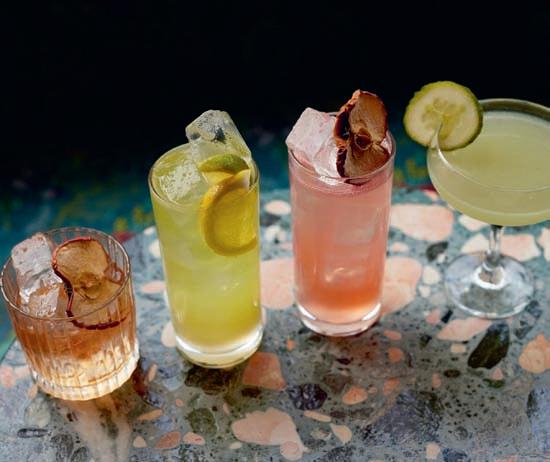
2 Saville Row, Bath BA1 2QP Web: commonroombath.co.uk
One of Bath’s original late-night bars, The Common Room has been an institution on the city's party scene since the 1960s. These days, it's open from 5pm, six days a week (and 10pm on Sunday) and the retro glam surroundings are buzzing well into the early hours. With a love for rum, you’ll find over 150 variations from around the world, alongside a fully vegan cocktail list, an extensive spirits selection, draught beers, cider, fine wines and more. There’s DJ action at weekends, with a host of events throughout the month, from live music nights to artisan markets.
Edgar Mews, Bartlett Street, Bath BA1 2QZ Web: dosdedos.co.uk
Dos Dedos is a lively Mexican cantina in the heart of Bath, with a focus on tequila, mezcal and creative cocktails. You’ll also find signature street food staples of Mexico City, with a small selection of tacos and nachos, which are great to share. A cool city hangout, with a reclaimed vibe, bartenders are supremely knowledgeable, there's a dogsallowed policy and children are welcome ’til 6pm. There are no advance bookings due to the size of the venue, so simply rock up to get your margarita and taco fix.

The Theatre Royal Bath is one of the oldest working theatres in Britain. Known locally as TRB, it first opened its doors over a century ago. Melissa Blease gives the theatre’s dramatic backstory
It would be easy to imagine that it’s a small theatre, but beyond the glittering facade there’s a lot of drama. A 900capacity auditorium featuring four plush boxes, a trompe-l’œil ceiling a nd a glittering chandelier are at the heart of the action. The theatre’s complex is also home to a dedicated young people’s theatre, an innovative studio theatre, a suite of elegant function rooms, several bars, a stand-alone pub... and a resident ghost. But as is generally the case with all the best theatrical productions, there’s an interesting back story.
In 1747, Bristol-based actor John Hippisley published proposals for the building of a new theatre in Bath that would rival the theatres in the capital. He opened the Orchard Street Theatre –the original Theatre Royal –in October 1750 with a performance of Shakespeare’s Henry IV, Part II. The theatre was so successful that in 1768 a special act of Parliament granted Hippisley’s initiative the illustrious Royal Patent.
As popular as the theatre was, its location didn’t do it any favours. As Bath’s population grew, the city’s cultural cognoscenti began to migrate north-west, and the area around Orchard Street became unfashionable. So, in 1804, construction of the New Theatre Royal on Beaufort Street was announced, and in 1805 the Orchard Street Theatre closed its doors.
Today, the building is a Masonic Hall. Take a tour there, and you can stand on the stage where Sarah Siddons – 18th-century ‘tragedienne’ –received the adulation of her audiences and take a
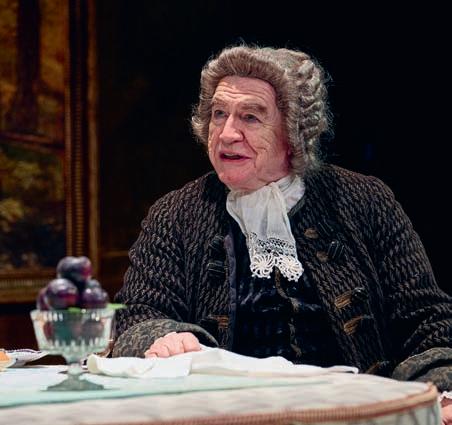
trip ‘backstage’ to see the original scenery loft.
Thanks to an illustrious roll-call of project shareholders including George III’s eldest son, George, HRH the Prince of Wales, the cornerstone for the new theatre was laid in December 1804 and opened to the public on 12 October the following year with a production of Shakespeare’s Richard III.
While not immediately successful, the New Theatre Royal’s popularity grew as it hosted visits from leading actors including Edmund Kean, Dorothea Jordan, William Macready and Joseph Grimaldi in entertainment from serious dramas to pantomime by way of operas, thrillers and comedies.
Around 1820, the rise in popularity of at-home suppers, travelling circuses and pleasure gardens were increasingly dominating the social calendars, while social and political reform was threatening economic stability. Meanwhile, poor ticket sales were compounded by rising fees for actors. As the 19th century progressed, the theatre fell into a period of decline –and then, on 18 April 1862 the theatre was destroyed by a fire. However a lavish, ornate phoenix was set to rise.
On 7 May, a limited company to rebuild the New Theatre Royal was formed. Bath-based architect C. J. Phipps redesigned it, and he added an Italianate, three-bay arcaded entrance on Sawclose.
The fully refurbished theatre opened on 3 March 1863, with Charles Kean and Ellen Terry headlining in Shakespeare’s A Midsummer Night’s Dream. But despite performances by theatre


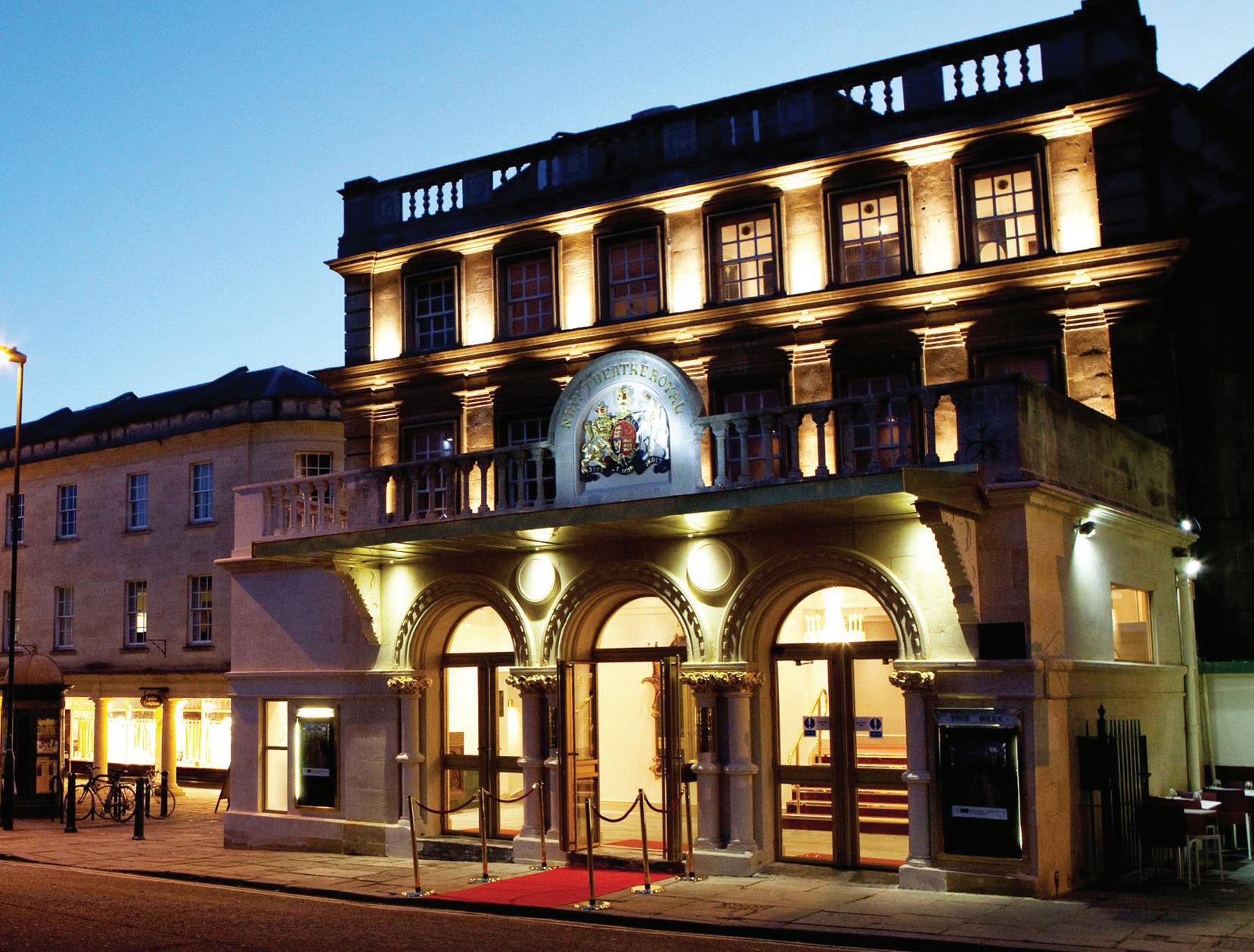
superstars including Sybil Thorndike, John Gielgud, Sarah Bernhardt, Irene Vanbrugh and ballerina Anna Pavlova, audiences declined and the theatre still struggled to make a profit; for several decades, the New Theatre Royal Bath was little more than a dusty, dilapidated provincial theatre.
In March 1979 philanthropic entrepreneur Jeremy Fry purchased the theatre on behalf of a trust. In 1980, an appeal was launched to renovate the whole site, including the rebuilding and modernisation of backstage systems to allow major touring companies to be booked. Financial support came from supporters including the Arts Council England, the Bath Preservation Trust, the city council and many individuals, and later loans were negotiated. On 30 November 1982 the theatre reopened again, with another performance of Shakespeare’s A Midsummer Night’s Dream featuring a cast from the National Theatre... and HRH Princess Margaret in the audience. Fry had saved the theatre from virtual collapse.
In 1997, a brand new 150-seat studio theatre was built at the rear of the Theatre Royal on Monmouth Street, named in honour of the actor Peter Ustinov, who led the fundraising programme. In 2005, the results of a major refurbishment of the former cinema and church hall that once inhabited the corner space between the theatre’s main house and the Ustinov on St Johns Place was unveiled and the egg theatre was hatched: a unique, innovative venue for children’s, young people’s and family theatre with a 120-seat
auditorium, family-friendly café, workshops and rooftop rehearsal studios. Today, the egg is a nationally recognised hub for outreach work with young people, schools and colleges.
In 2009, yet another major refurbishment appeal was launched by the TRB’s Royal Patron Camilla, Duchess of Cornwall. The foyer was expanded, the décor was given a facelift and the theatre’s bars were refurbished to include the Jeremy Fry Bar. The reopening ceremony was performed on-stage by actors Penelope Keith and Peter Bowles, who were starring in the TRB’s own production of Richard Brinsley Sheridan’s The Rivals, which is set in and around 18th-century Bath, and served as a rather touching tribute to the origins of the theatre.
This splendid theatre, which has repeatedly fought every adversity, has staunchly refused to allow the curtain to fall on it for good. Today it takes centre-stage as the cornerstone of Bath’s contemporary cultural and social scene.
Theatre Royal Bath, Sawclose, Bath BA1 1ET
For performances, information and to book tickets, contact the Box office: Tel: 01225 448844
For the egg theatre: Tel: 01225 823409
Web: theatreroyal.org.uk
So hilarious were his performances, Bath theatregoers queued to see him.
Historian Catherine Pitt tells the story of a man considered to be the worst actor in history
Bath, 1808 – genteel, sedate, elegant. The social season began unhindered, the glorious buzz of the Beau Nash years a faded memory. Into this calm stepped an exotic character, the self-styled Amateur of Fashion, a man who was soon to be considered “the worst actor in English theatrical history”. Allow me to introduce to you – Robert ‘Romeo’ Coates.
Born in 1772 in Antigua, the only surviving child of plantation owners, Coates was educated in England but returned to the West Indies after his parents refused to allow him to pursue a military career. When he wasn’t travelling, Coates would dabble in amateur
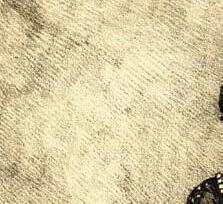

dramatics. After his father’s death in 1807, Robert rapidly headed for England, first to London and then to Bath.
When Coates appeared on the peaceful city streets in 1808, few had seen his like before. Even in the period of Regency dandyism his flamboyant appearance raised more than a few eyebrows. He wore vast furs in all weathers. In the evenings he would appear in the Pump Room and Assembly Rooms in a sky-blue coat, yellow breeches, a multi-coloured cravat and feathered hat. He embellished every element of his attire, from shirt buttons to shoe buckles and walking cane, with hundreds of diamonds, gaining him the moniker of ‘Diamond’ Coates.
To add to this, Coates chose to travel in a carriage of his own design: a two-wheeled chariot (known as a curricle) pulled along by two white horses. Atop the curricle was Coates’ mascot and motto – a crowing fighting cockerel, wings outstretched, and underneath the boast: “Whilst I live I’ll Crow”.
Despite his noticeable presence in Bath, few knew who he was or where he was from; all they knew was that he must be a man of wealth to indulge in such eccentricities.
There are conflicting views as to where exactly he lodged in Bath, but what is certain is that he could be found, daily, enjoying breakfast and lunch at York House on George Street, a large coaching inn, still a hotel today. Here, according to Pryse Gordon, a man who takes the claim for introducing Coates to the Bath stage, he approached Coates when overhearing him rehearsing passages from Shakespeare. Correcting Coates on a line, he was met with the words, “Aye, that is the reading I know... but I think I have improved upon it.”
Gordon discovered Coates’ passion for Shakespeare and for amateur dramatics. Currying favour with this wealthy eccentric, Gordon offered to introduce Coates to the manager of the Theatre Royal, William Wyatt Dimond. Coates declared that he was “ready and willing to play Romeo to a Bath audience.”
Dimond was unwilling to risk the theatre’s reputation on an unknown, but after reassurance from Gordon that seats would be filled and probably some monetary reassurance from Coates, Dimond agreed. Playbills were plastered around the city announcing that on 8 February 1809 a new production of Romeo and Juliet was opening and that the male lead was to be played by “an amateur actor from the fashionable world”.
As word spread of Coates’ acting debut, seats began to fill up fast. On the evening of the production the Theatre Royal was packed with curious Bathonians, with many more turned away at the door. Inside the anticipation was palpable.
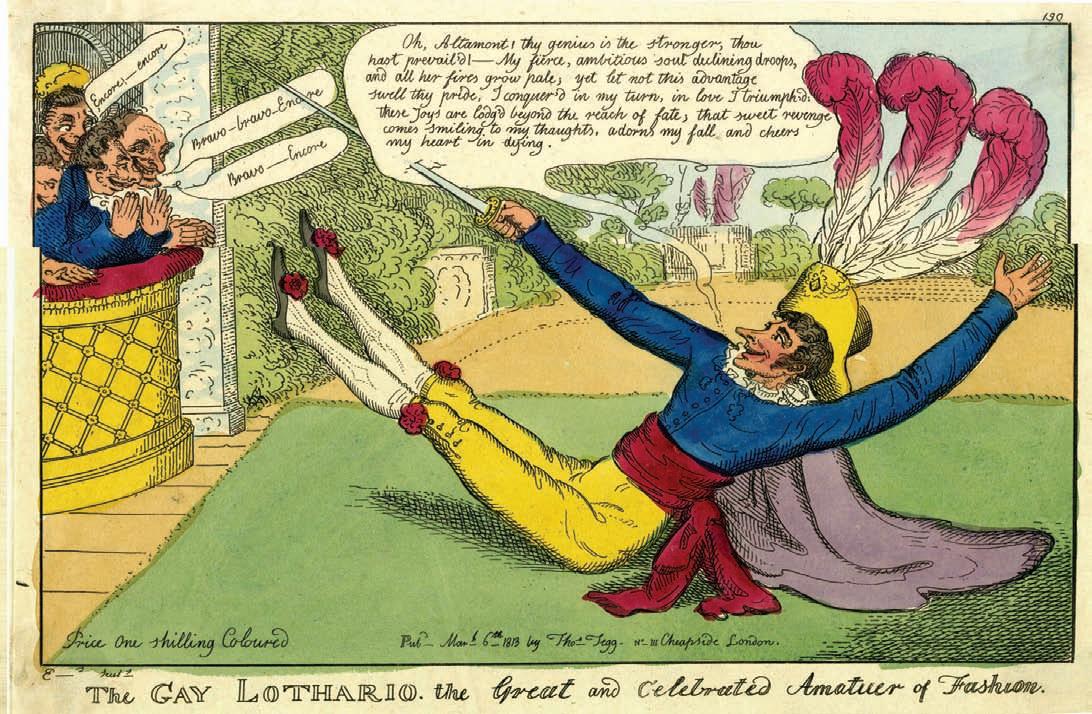
On Coates’ entrance the audience were at first dumbfounded at the vision stood before them, described by an observer as “one of the most grotesque spectacles ever witnessed upon the stage”. Romeo wore “a spangled coat of sky-blue silk, crimson pantaloons,” diamond additions; plus a huge baroque wig. Balanced on top was a white trimmed hat with plumes of ostrich feathers. Coates took a nervous bobbing bow, grinning away, and the audience burst into peals of laughter and roars of applause.
Unfazed Coates proceeded, though it was like no version of Shakespeare’s play ever seen before or since. Coates had a tendency to forget his lines, add in his own where he thought they needed improving, and would alternately whisper sections to just one box in the the atre. During the famous balcony scene, Coates turned away from Juliet, pulled out his snuff box and took a pinch. As the public roared their approval he offered the snuff box to a number of ladies and gentlemen in the audience.
Half way through the play, during the rendition of an impassioned speech, the seams at the seat of his tight red breeches, bursting open to reveal a “quantity of white linen sufficient to make a Bourbon flag!”
On appearing at the tomb of Juliet, Coates took out a silk handkerchief, laid it on the boards, put his hat down to act as a pillow and then went through a most lengthy and, apparently from his grimaces and groans, agonising ‘death’ before carefully laying himself out on stage.
Convulsed with laughter, members of the audience shouted out “Die Again, Romeo” and Coates ob liged, not once but twice more. He was about to attempt a third when Juliet appeared from the wings and stopped him. Dimond hastily dropped the curtain
bringing the play, finally, to an end. Meanwhile on stage Coates ran around, hanging off boxes, shouting “Haven’t I done well?”
The jeers and heckles that Coates received made little impact on him. He was buoyed by what he considered his success in Bat h, so much so that he decided to tour his production of Romeo and Juliet around the country, including playing the Haymarket Theatre in London.
Although a subject of mockery and satirisation, Coates still considered himself just an amateur actor and did not take a wage. His reputation preceded him so theatres were packed. Any profits Coates would request went to charity.
In December 1816 Coates headed t o Bath, and the theatre where it had all began, for the final act. Over three days he performed another of his favourite plays, The West Indian, but for the final public performance Coates chose Romeo and Juliet
It was said by audience members that he was much improved. As before, Coates was jeered, but this time he paused and declared that people could request their money back if they were not happy, but that his intention was that the money from this play were to go to the local Pierrepont Street Charity. Shamed into silence, a more reverent crowd allowed Coates to continue.
After 1816 he would do the occasional private charitable performance, but it was the last the public would see of ‘Romeo’ Coates. Dogged by debt collectors during the financial troubles of the 1830s, Coates took refuge in Boulogne for a few years where he was often spotted in his furs.
His death, in February 1848, was as bizarre as his life had been – he was crushed between two carriages in London’s Covent Garden after a night at the Opera. Alas, Poor Romeo!
Bath transforms into an enchanting, grown-up playground when the sun goes down. Our very own bonne vivante, Melissa Blease puts her party frock on and ventures out after dark
Bath is home to an abundance of restaurants, pubs and bars that are all too easy to lose yourself in until it’s time for bed. But as alluring as eating, drinking and being merry may be, there’s yet far more to the city’s nightlife scene to explore.
• Vino Vino
For Bathonians who like to keep an eye on who’s out-and-about in town, with whom, and why, wine and cocktail bar Vino Vino acts as a life-as-it-happens Bath gossip column HQ. Heated

parasols on the spacious terrace turn winter chills into a warm glow, while indoor tables adjacent to the big picture windows guarantee that you won’t miss a trick even when terrace tables are taken. Fine wine and cocktails are a speciality here and the fizz flows in abundance, while chic charcuterie and stylish sharing platters presented in picture-perfect portions fortify you up for the rest of the evening’s entertainment ahead.
• Find it on: Saw Close. Open until: midnight Monday–Thursday; 1am Friday–Saturday; 11pm Sunday
• Green Park Brasserie
There’s something unselfconsciously, comfortably cool about the whole affair; it’s a ‘welcome to the neighbourhood’ party and everybody’s invited. Under the glass canopy of the old Green Park Station, enjoy live music 4 nights a week, special offers on cocktails, and great food, this is the perfect place to start your evening - and you’ll probably want to stay longer.
• greenparkbrasserie.com
• Komedia, Westgate Street
Proud hosts/producers of 400+ events every year, Komedia has put Bath on the live entertainment map. Comedy, music, cabaret and club nights all vie for attention on the programme, while the legendary Krater Comedy Night puts three of the best national circuit comedians centre stage every Saturday night before neatly segueing into the equally legendary Big Disco or Motorcity club night even ts, which pump up the dancefloor volume until the wee small hours.
• komedia.co.uk/bath/whats-on
• Chapel Arts Centre, Lower Borough Walls
Bath’s leading alternative ’not-for-profit’ grass roots arts venue plays host to a varied array of performance and visual arts events, including live music, theatre, dance, film and cabaret. The majority of events are seated cabaret (small round tables). The venue has excellent natural acoustics, a sprung dance floor and a well-stocked bar within the Auditorium.
• chapelarts.org
• The Forum, St James Parade
Purpose-built as an art deco cinema in 1934, The Forum is Bath’s biggest venue and the third largest seated auditorium in the south west of England. The remarkable interiors represent typical art
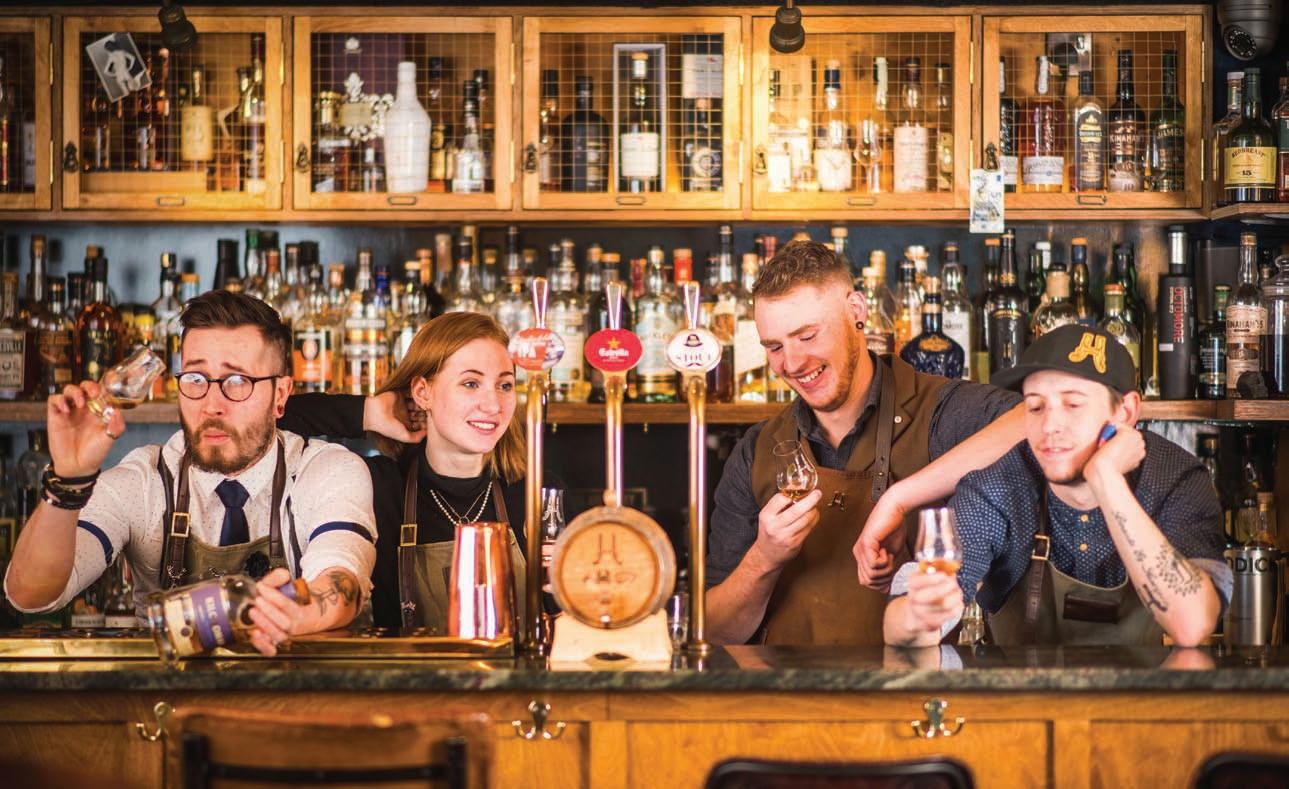
deco-era splendour including lacquered wood fittings and goldleafed flourishes, while iconic green cinema seats offer a luxurious audience experience in the elegant auditorium. One-night-only special events pack The Forum’s schedule, including live music, tribute acts, brass bands, orchestras and ‘in conversation’ events with visiting celebrities.
• bathforum.co.uk
• Little Theatre Cinema, St Michael’s Place
Proudly maintaining an independent vibe far removed from the commercial, multiplex behemoths, this trad-contempo cinema house flies the flag for the very best arthouse, cult and mainstream movies alongside regular special event screenings. Meanwhile, the lovely little (no pun intended) fully licensed refreshment kiosk negates the need for sneaking stinky takeaways and commercial confectionary wrapped in inconsiderate crackly plastic in under your coat.
• picturehouses.com/cinema/The_Little
• Everyman Cinema, SouthGate Centre
Located in the Southgate centre, near Bath Spa Station, Everyman Bath is a plush and swanky art-house cinema experience. Featuring four cinema screens, a grand bar mixing smart cocktails and you can enjoy delicious burgers and sharing plates served directly to your cinema seat. What’s not to like.
• everymancinema.com
• Theatre Royal Bath and The Ustinov Studio, Saw Close
The new Theatre Royal Bath, referred to as the Theatre Royal
Bath – opened its doors over a century ago. The theatre offers the cream of the UK’s touring company crop, while the Ustinov Studio on Monmouth Street specialises in acclaimed programmes of world and UK premieres alongside small-scale touring productions, live comedy, music and dance.
• theatreroyal.org.uk
And after all that...
• The Dark Horse
The deliciously devilish subterranean prohibition era-style speakeasy on leafy, historic Kingsmead Square casts a seductive spell over a bewitching cocktail menu, many created using locally sourced produce and ingredients including fruit and herbs foraged from the bountiful mead ows nearby. Late night bar snacks available too.
• Find it on: Kingsmead Square. Open until: 12.30am Monday-Thursday; 2am Friday-Saturday; 11.30pm Sunday
• darkhorsebar.co.uk
• Montagu's Mews at the Royal Crescent Hotel
Stylishly seductive and subtly convivial, Montagu’s Mews is an oasis of modern luxury. Relax in the elegantly modern bar or take a table on the heated, partially covered terrace in the hotel’s breathtakingly pretty garden and prepare to choose from the extensive cocktail menu, artisan botanicals, small batch spirits and imaginatively curated wines and beers.
• Find it on: The Royal Crescent (no.16). Open until: residential hotel hours

• The Canary Gin Bar
The vibe throughout this quirky, intimate split-level gin lovers paradise – home to the Bath Gin Company – is thoroughly beguiling. The recipe for the company’s eponymous spirit was developed here, and is used as the basis for its signature cocktails alongside a massive range of contenders for the gin throne. If gin doesn’t make you grin, there are plenty more options.
• Find it on: Queen Street. Open until: midnight, Monday–Saturday
• Circo
If late-night bling makes your heart sing, super-chic cocktail hotspot Circo puts sparkly sensibilities into the cocktail/nightcap equation. Cool, lively and distinctly stylish, Circo offers a stunning array of cocktails alongside a comprehensive Champagne, wine and spirits list and, at weekends, in-house DJs spin a heady mix of funk, soul, disco, house and electro beats all the way through until 3am.
• Find it on: George Street. Open until: midnight Monday–Thursday; 3am Friday–Saturday; 10.30pm Sunday
• The Old Q Bar at the Queensberry Hotel
The Queensberry Hotel’s Old Q bar is one of Bath’s most subtly glamorous hidden gems and the cocktail list a connoisseur’s joy to behold – there be no budget blends or middling mixers sullying the alcohol-i nfused waters here, and if you can’t see exactly what you want on the list, expert mixologists are on hand to offer recommendations. The fizzbased specialities are fabulous, and the Manhattan is reputed to be the best in our non-stateside town.
• Find it on: Russel Street. Open until: residential hotel hours
• Fidel’s
If rum is the latest cool spirit to set the tongues of influencers across the globe wagging (which it is), this intimate, easygoing little bar is the place to acquaint yourself with all manner of varieties of this legendarily characterful tipple. The cocktails are superb, and the staff super-friendly, knowledgeable, welcoming and more than happy to rustle up a little snifter of something else for the rum-reluctant.
• Find it on: Trim Bridge (Queen Street). Open until: midnight Tuesday – Saturday
• The Grapes
There’s been a public house on 14 Westgate Street since 1792. Today the gorgeous Grapes keeps that tradition thriving courtesy of an exceedingly well-stocked bar that muddles up both perfect cocktails and perfect pints while flying the flag for local artisan producers, a lively schedule of live music and fascinating events and a super-friendly ambience. If Pocock's Living Room (the event space on the first floor) is open, do pop up; the room has Jacobean origins and an ornate lime plaster ceiling (constructed around 1612) to prove it.
• Find it on: Westgate Street. Open until: 1am MondayThursday; 2am Friday-Saturday; midnight Sunday
• The Common Room
One of Bath’s original late-night bars, The Common Room has been an institution on the city’s party scene since the 1960s. These days, it’s open from 5pm, six days a week (and 10pm on Sunday) and the retro glam surroundings are infused with a tiki vibe. With a love for rum, you’ll find over 100 variations on the pirate’s tipple of choice, alongside a fully vegan cocktail list, an extensive spirits selection, draught beers, cider, fine wines and more. There’s DJ action at weekends, life drawing on Wednesdays with regular music nights s howcasing local upand-coming bands.
• Find it on: 2 Saville Row, Bath BA1 2QP. Open: 5pm–2am, Monday-Thursday; 5pm–3am Friday-Saturday and 10pm-2am Sunday.
• The Hideout
Opened in 2016, The Hideout is a whisky den which takes its cue from the lawless thieves, highwaymen and opportunists who might have met there in the past. It was the perfect hideout. Seven years on, it still has the feel of one of those ‘secret’ places you don’t want to share, with its cosy, vaulted feel, 300 odd whiskies on the shelf and a forward-thinking team with larger-than-life personalities and a fondness for hip-hop. Of course, you don’t have to be a whisky aficionado to love The Hideout, there are crazy good cocktails – which put it at No.25 in the top 50 cocktail bars in the UK list – beers, ciders and top-notch wines to sip outside in the sunny courtyard too.
• Find it on: Lilliput Court, off North Parade Passage. Open until: 11pm, seven nights a week
• Late night nibbles
‘Formal’ late night/early morning dining options are scarce in Bath. But if hunger strikes before bed time, grab yourself a tasty burger from local legend Schwartz Bros (Saw Close and Walcot Street), a cool kebab from Al Falafel (Mon mouth Street), a Greek treat from Taka Taka (Broad Street) or even a carton of cheesy chips from Mr D’s Burger Van (found on New Bond Street). Until you’ve ended an evening in Bath chowing down on one of the city’s original street food fast fixes, you’ll never be a true Bathonian. Sweet dreams.
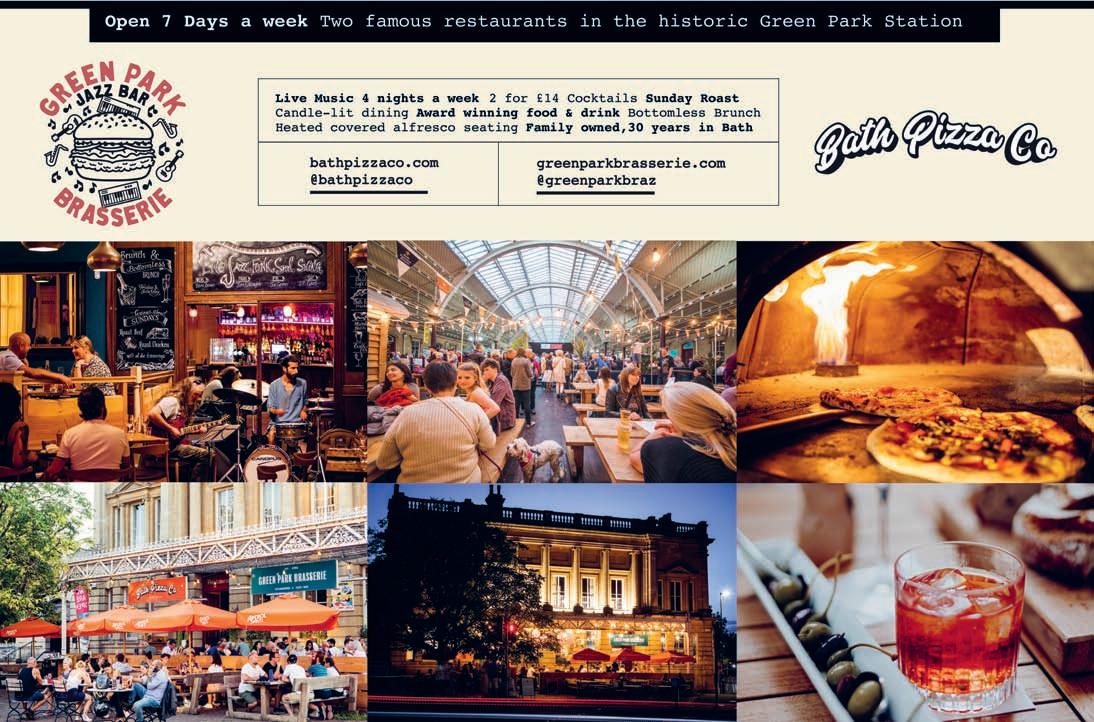


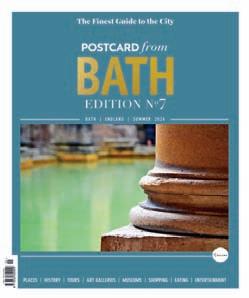

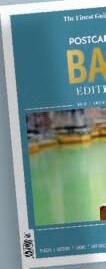



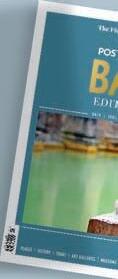


Postcard is available for guests to enjoy either in-room or in the lobbies at most of the city’s 3, 4 and 5 star hotels, as well as in serviced apartments and many B&B’s across and around Bath.
If you would like to buy a copy as a souvenir we can send one by post –we will even include the cost of the postage to any UK postal address. You can order online via our website: postcardmagazine.co.uk or by calling our offices on +44 (0)1225 424 499
Priced at £10 per copy to any UK mainland address
£15 per copy to any European address
£20 to any international zone 1 address
£25 to any international zone 2 address For postal zone information see: www.royalmail.com/international-zones
Access great information on our handy, mobile friendly website as you tour around Bath



